

Tillamook Rock Lighthouse “Terrible Tilly”

By Visit Oregon
May 28, 2019 / 7:32 pm

Share this article on social media!
Tillamook Rock Lighthouse, also known as “Terrible Tilly”, is a historic lighthouse located off the coast of Oregon, USA. The lighthouse is perched on a rock formation about a mile offshore from Tillamook Head, near Seaside, Oregon. The lighthouse was constructed in the late 19th century to aid mariners navigating the treacherous waters of the Pacific Northwest. Today, the lighthouse is no longer operational, but it remains an iconic symbol of Oregon’s maritime history.
The History of the Tillamook Rock Lighthouse
The history of Tillamook Rock Lighthouse dates back to the 1870s, when the U.S. government recognized the need for a navigational aid on this stretch of the Oregon coast. The rock formation on which the lighthouse was built was known for its perilous conditions, with strong waves and high winds making it difficult for ships to navigate safely. In 1878, construction of the lighthouse began and the structure was completed in 1881. The Tillamook Rock Lighthouse sits about 1.2 miles offshore and is approximately 20 miles South of the Mouth of the Columbia River. Although the lighthouse doesn’t serve boaters directly at the Mouth of the Columbia, it does provide an important historical marker for ships navigating in the area off the shore of Tillamook Head. Tillamook Head is a 1,200 foot high rocky bluff that protrudes out into the Pacific Ocean.
What was the purpose of the Tillamook Lighthouse?
Tillamook Rock Lighthouse was designed to withstand the harsh weather conditions of the Pacific Northwest. The lighthouse stands 133 feet tall and is made of solid masonry construction, with walls that are up to 12 feet thick in some places. The lighthouse was equipped with a first-order Fresnel lens, which was capable of producing a bright, steady beam that could be seen for over 20 miles.
Historic Challenges on the Oregon Coast
Over the years, the lighthouse had its share of challenges. The rocky terrain and rough waters made it difficult to transport supplies and personnel to the lighthouse. In 1934, the lighthouse was damaged by a severe storm, and repairs were required to make it operational again. However, with advances in technology, the need for the lighthouse diminished, and it was decommissioned in 1957.
In the years following its decommissioning, the lighthouse was used for a variety of purposes, including as a museum, a private retreat, and a destination for helicopter tours. Today, the lighthouse is privately owned and is not open to the public, but it remains a popular attraction for tourists who come to view it from the nearby shoreline or from a distance on a boat tour.
Proud Symbol of Oregon’s Maritime Heritage
Despite its nickname “Terrible Tilly,” Tillamook Rock Lighthouse is a remarkable feat of engineering and a testament to the dedication and perseverance of the lighthouse keepers who manned it over the years. It is a proud symbol of Oregon’s maritime history and a reminder of the importance of lighthouses in keeping seafarers safe in treacherous waters. The Tillamook Rock Lighthouse remains an impressive display of engineering .Today, the lighthouse is a popular tourist attraction, with visitors able to take boat tours to view the structure up close.
In addition to its historical significance, the lighthouse is also notable for its natural surroundings. The surrounding coastline is home to a variety of wildlife, including seabirds and sea lions, and offers stunning views of the Pacific Ocean. Visitors can hike along the coastal trails or take a picnic on the beach while admiring the lighthouse in the distance.
Here are a few frequently asked questions about the Tillamook Rock Lighthouse.
Why is it called terrible tilly .
The Tillamook Rock Lighthouse earned the nickname “Terrible Tilly” due to the harsh conditions that the lighthouse keepers had to endure while living and working on the rocky island. The lighthouse was built on a small, rocky island off the coast of Oregon, which was subject to intense storms and high waves that often made it difficult for ships to navigate.
Can you visit Terrible Tilly?
It is not possible to visit the Tillamook Rock Lighthouse, also known as Terrible Tilly, as it is located on a small island off the coast of Oregon and is not open to the public.
Who owns The Tillamook Lighthouse? The Oregonian published an article in May of 2022 that the lighthouse was for sale for $6.5 million. The article detailed how in 1978 Max M. Shillock, Jr and Joy Goolsby purchased the lighthouse for $27,000. In 1980 they turned around and sold the historic lighthouse for $50,000 to real estate developers Cathy Riley and Mimi Morissette.
Can you visit Tillamook lighthouse? Unfortunately, the Tillamook Rock Lighthouse is not open to the public and cannot be visited.
Does the Tillamook Rock Lighthouse still work?
No, the lighthouse has been decommissioned for years and abandon. Since its decommissioning the lighthouse has slowly fallen into decay and is now inhabited only by seals and other marine life.
Overall, the Tillamook Rock Lighthouse, or Terrible Tilly, is a unique and fascinating piece of Oregon’s maritime history. Its story serves as a reminder of the bravery and resilience of those who built and manned it, and its imposing presence continues to captivate visitors today.
Here’s a few great videos of the Tillamook Rock Lighthouse:
Are You Considering Relocating To Oregon?
- Visit Oregon
- May 28, 2019
Related Posts

The Best Trail for Backpacking on the Oregon Coast

AI Generated Landscape Photos of Oregon’s Most Scenic Locations

Best Places in Oregon to Buy a Vacation Rental on a Lake

Get Your Free Oregon Travel Guide
Leave a comment below, learn more about us, oregon regions, explore the site, follow us on social media.

© Copyright – Visit Oregon 2023 | Site Built By: Oregon Web Solutions | Sitemap
Tillamook Rock Lighthouse

Top ways to experience nearby attractions

Most Recent: Reviews ordered by most recent publish date in descending order.
Detailed Reviews: Reviews ordered by recency and descriptiveness of user-identified themes such as wait time, length of visit, general tips, and location information.
Also popular with travelers

Tillamook Rock Lighthouse - All You Need to Know BEFORE You Go (2024)
- (0.12 mi) Schooner's Cove Inn
- (0.15 mi) The Waves
- (0.14 mi) Land's End at Cannon Beach
- (0.11 mi) Steps From Town, Steps From The Beach!
- (0.16 mi) Inn at Haystack Rock
- (0.03 mi) Mi Corazon Mexican Cuisine
- (0.04 mi) Pie Girl & Pie Guy
- (0.04 mi) Lazy Susan Cafe
- (0.09 mi) Driftwood Restaurant & Lounge
- (0.10 mi) Bill's Tavern & Brewhouse
- EAT & drink
Seaside Stories
- How to Get Epic Tillamook Rock Lighthouse Views
September 2, 2017 | by By Shellie Bailey-Shah
- Share this story
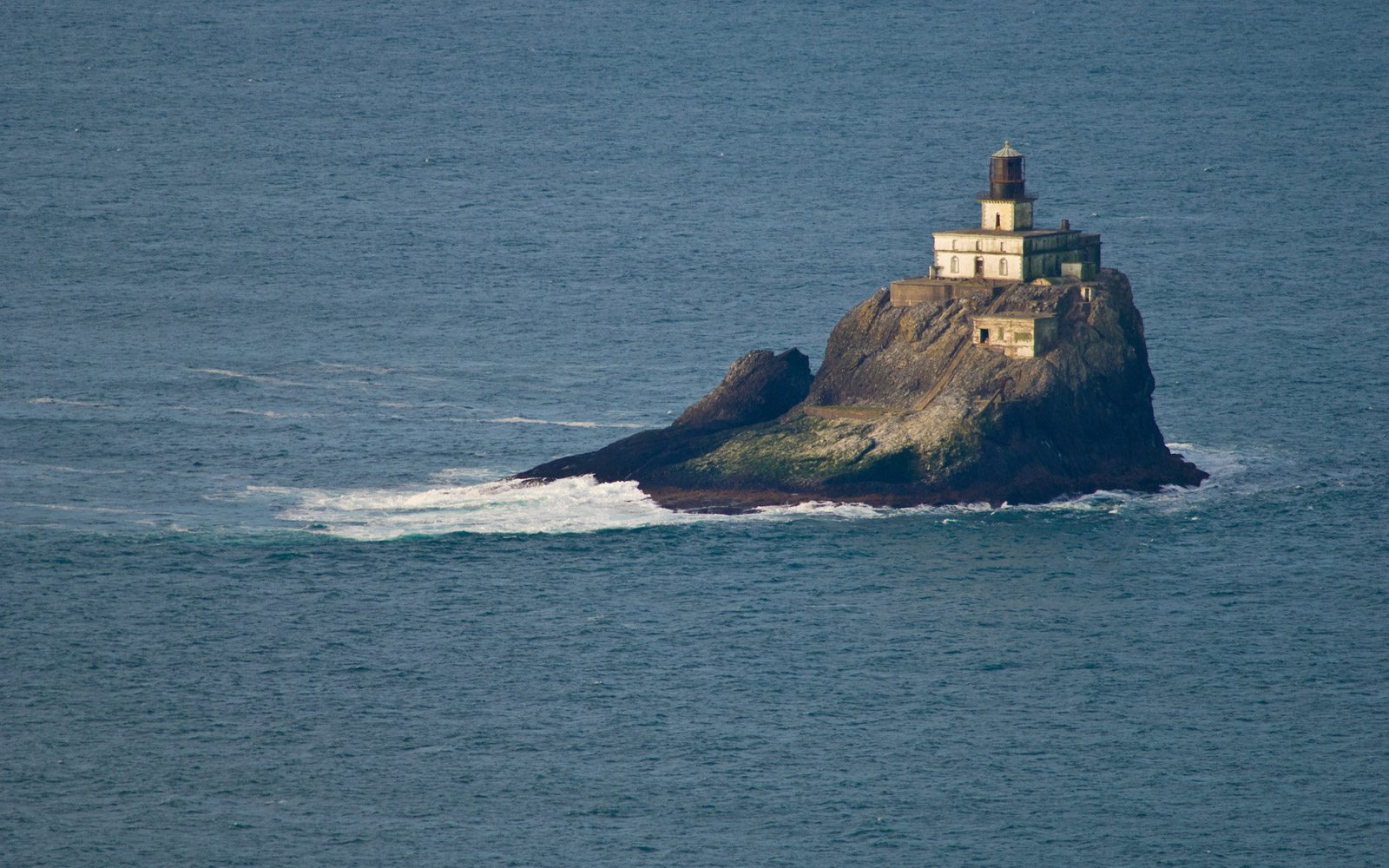
In 1806, the Lewis and Clark expedition crossed Tillamook Head to buy the blubber of a stranded whale from Native Americans at Cannon Beach. At the viewpoint, Captain William Clark famously marveled, “I behold the grandest and most pleasing prospect which my eyes ever surveyed.”
Today, you can hike the same trail as Clark — the Tillamook Head Trail —and look in awe at the same view. You’ll also get to see the infamous Tillamook Rock Lighthouse , perched on an inhospitable rock often swept over by crashing waves. Nicknamed “Terrible Tilly,” the lighthouse had a reputation for ill-tempered lighthouse keepers whose cramped quarters and isolation sometimes got the better of them.
THE QUEST BEGINS
Your quest to see Tillamook Rock begins on the south side of Seaside at the end of Sunset Boulevard. Here you’ll find a free parking lot and the Tillamook Head trailhead in Elmer Feldenheimer Forest Preserve. If you were to look at a trail map, you might assume that you’d be treated to ocean views along the entire trail. Instead you’ll find that much of the trail runs under towering Sitka spruce, Western hemlock and Western red cedar with a bed of deer ferns, skunk cabbage and goose-neck moss. To see Terribly Tilly, you’ll need to do a little work.

Get all the good info delivered to your door!
Free Official Travel Guide
- Explore 52 pages of colorful Seaside info
- Get the inside scoop on restaurants and fun
- Find maps, parks, trails and tide tables
- + much more, including Treasure Quest 2024!
THE JOURNEY BACK
Retrace your steps to the parking lot, or if you’re feeling really ambitious, you can continue 1.6 miles to Indian Beach picnic area or beyond that, another 1.5 miles to Ecola State Park in Cannon Beach.
If you make the full trek to Cannon Beach, you can call one of two cab companies in Seaside for a lift back. At the time of writing, Aalpha Shuttle (503-440-7777) charges $22 for a ride from Ecola Point and $27 from Indian Beach; Royal (503-325-5818) does not have a flat rate from either of those two locations, but you can expect to pay between $30-$40.
Click here for more great hikes in and around Seaside.
Photo by Greg Vaughn
You are currently reading
Visit our other blogs.
- Only in Seaside
- Accessible Adventures in Seaside
- 6 Great Mexican Restaurants in Seaside
- Your Home Base for Saddle Mountain Hikes
- Seaside Is Your Dog’s Best Friend
- Whales and More!
- More than 30 Years of Good Times on Seaside’s Carousel
- Tables for Two: A Romantic Stay in Seaside
- 5 Ways to Stick to Your Healthy Resolutions in Seaside
- Perfect Rainy Days Are Possible in Seaside
- Exploring the North Coast Food Trail in Seaside
- Catch the Holiday Spirit at These Merry Holiday Events
- Behind the Scenes at the Seaside Aquarium With Tiffany Boothe
- Savor Oregon Wines at Seaside’s Tasting Rooms
- What’s New in Seaside
- Your Guide to the Perfect Summer Getaway in Seaside
- Say Chēz: Destiny Deras’ New Cheese Shop and Wine Bar
- 6 Great Asian Restaurants in Seaside
- The Scoop on Sea Star Gelato: Douglass and Tanya Lintow
- Lifeguards Keep Seaside Beach Safe
- Discover Seaside’s Upper Broadway and Gilbert District
- Fun Street Foods in Seaside
- Seaside Is Your Whale-Watching Home Base
- Sharing the Stoke With Surf Shop Owner Josh Gizdavich
- Chowder for Dooger’s Next Generation: Carnegie Wiese
- 5 Places to Watch the Big Game in Seaside
- King Tides on the Oregon Coast
- Great Breakfast Spots in Seaside
- Dawn Fujiwara-Pavlik Feeds Creative Community
- Seaside’s Holiday Events Shine Bright in 2022
- Five Great Burgers in Seaside
- Discover the Beach Less Traveled in North Seaside
- Cozy Up With Bookstore Owner Karen Emmerling
- How to Have Fun in the Sand in Seaside
- Five Ways to Go Offline in Seaside
- Farmers Market Means Summer on the Coast
- C&R Mercantile’s Rachelle Minoza Brings The Chic
- Quiet Waters and Wildlife on the Necanicum Estuary
- Fun on the Way to Seaside
- Grab a Great Cup of Coffee or Roast Your Own Beans
- Plug and Play While Your EV Charges in Seaside
- Dining Gluten-Free in Seaside
- Plan Your Seaside Vacation
- Warm Drinks and Cool Winter Excursions
- Top Holiday Gifts in Seaside
- How to Take an Extended Stay This Winter
- Smoothies, Boba, Floats and Other Specialty Drinks
- Three Broadway Spots that Span Generations
- Seaside Off The Beaten Path
- RECAP: Chalk Art Contest on the Seaside Prom
- Where to Find Your Seaside Centennial Keepsakes
- How to Experience Seaside’s Prom Centennial
- See What’s New in Seaside This Summer
- Unique Vacation Rentals in Seaside
- Top Selfie Spots in Seaside
- Seaside’s Beloved Old Cypress Trees
- Pypo Boarding and Seaside’s Role in the Unique Pastime
- Tips for Whale Watching In and Around Seaside
- How to Be an Earth Steward in Seaside
- All About Storm Watching in Seaside
- Top Pizza Spots in Seaside
- The Art of the Stroll: Celebrate Seaside’s Prom Centennial
- Holidays in Seaside
- Beach + Burrito, A Love Story
- Flying Into the Seaside Airport
- Pokémon Go: All You Need To Know in Seaside
- Seaside Guide to Beachcombing
- Unique Seaside Spots to Stay
- 5 Ways to Social Distance in Seaside
- COVID: What to Expect Dining In or Taking Out
- COVID: What to Expect at Hotels and Vacation Rentals
- COVID: What to Expect at the Beach and on the Prom
- All About Independence Day 2020 in Seaside
- Support Seaside Shops Online
- Beach Reads for a Vicarious Escape
- What The Oregon Coast Can Teach You From Home
- Eat Your Way along the North Coast
- Everyone Needs a Spring Break
- Iconic Seaside in Stereo
- Building a Seaside Mountain Biking Culture
- How to Bike Seaside in Every Season
- King Tides Safety and Viewing in Seaside
- A Year in Seaside – Winter, Spring, Summer, and Fall Tips
- How to Explore the Historic Gilbert District
- Film Lover’s Guide to Seaside
- How to Treasure Seaside
- How to Sip Coffee Like a Local
- Feed Your Mind, Body and Soul in Seaside
- Celebrate the Holidays in Seaside
- Seaside Without A Car
- Feel Like A Kid Again
- Mural Walking Tour
- Epic Mountain Biking Trails at Klootchy Creek
- Pocket Garden Walking Tour
- The Amazing and Colorful History of Seaside
- Seaside Art Scene
- Discover Marine Wonders at Low Tide
- Insider Tips: Exploring the Prom Like a Local
- Why This Family Comes Back To Seaside Year After Year
- Murals, Swing Jazz, and Marine Life: Experiencing Seaside’s Arts & Culture
- Guide to Spring Events in Seaside
- The Quieter Side of Seaside
- From Arcade to Aquarium: 8 Things To Do When It’s Raining In Seaside
- How to Plan a Romantic Stay in Seaside
- Step Into Vintage Charm at the Times Theatre
- A New Year of Seaside Adventures
- Locals Weigh In on the Best Ways to Visit Seaside
- Summer’s Great, but There’s Nothing Else like Winter in Seaside
- Read These Oregon Coast Page-Turners
- A Dog’s Guide to Seaside
- For a Taste of Oregon’s Beautiful North Coast, Visit Seaside
- How to Build a Beach Campfire
- Accessible Adventures For Everyone
- A Kid-Free Couple’s Getaway
- Beach Access for Everyone
- Ranger’s Guide to the North Coast
- Top Take-Out Spots in Seaside
- How To Surf Seaside
- How To Paddle Seaside
- Top Things to Do With Teens
- Seaside Summer Event Guide
- How to Start Cycling In Seaside
- How To Walk Seaside, Oregon
- What is Fascination, Anyway?
- Top Things to Do With Young Kids
- How to Treasure the Beach
- 7 places to maximize indoor fun in Seaside, Oregon
- New Year, New Adventures
- Where to Watch for Whales
- Tides and Tide Tables: What You Need to Know
- How to Catch Your Dinner: Learning the joy of razor clamming in Seaside, Oregon
- Holiday Festivities in Seaside
- How to Seaside Inside
- Can’t-Miss Dungeness Crab Eats
- Where to Shop for Souvenirs in Seaside
- Where to Go Birding in Seaside
- Spookiest Spots in Seaside
- World’s Largest Beach Volleyball Tournament
- Big Burgers You’ll Want to Brag About
- How to Paddle Seaside
- Near Seaside: Reviewing Klootchy Creek Park
- Hot Summer Car Shows
- 4 Favorite Hikes Around Town
- How to Have an Epic North Coast Summer
- The Cove, Seaside’s Natural Treasure
- Seaside’s Spring Downtown Wine Walk
- Must-Eat Clam Chowders in Seaside
- How to Bike Seaside
- Seaside’s Very Own Rainforest: Tillamook Head
- Painted Rocks & Secret Spots
- The Sweet Side of Seaside
- An early morning kayak ride
- The Spirits of Seaside Inside
- Seaside Nightlife
- Seaside Inside: The Historical Edition
- A Stop on the Art Walk
- A Tradition of Tea
- Seaside Inside for Kids
- Mushroom Foraging Near Seaside
- Seaside Holiday Spirit
- Seaside Watercraft Adventures
- So Close, But a World Away
- An Adventure to Share
- Grant’s Getaways: Paddling the Neawanna in Seaside
- Seaside, OR Makes List of Best Beach Towns to Explore on Foot
- Hidden Gems: 13 U.S. Towns that are Diamonds in the Rough
- Portland to Seaside by Bus
- Northwest Travel Magazine: Gilbert District
- Crabbing & Clamming as Seasiders Do
- Destinations Magazine: Great Escapes
- Seaside’s History is an Honored Guest in Its Present
- Oregon Coast: Lodgings with a Tale to Tell
- Fishing Adventures In and Around Seaside
- MotorTrend Magazine – Epic Drives: Classic Cobra Visits Seaside
- The Best of Times News: The Beach at the End of the Trail
- 1859 – Oregon’s Magazine: 72 Hours In Seaside
- Northwest Travel Magazine: Best Eats on Oregon’s North Coast
- MotorHome Magazine: Sea to River, Oregon’s Spectacular North Coast
- Seaside’s Famous Feathered Citizens
- Buffleheads: Oregon Coast’s Silliest Part-Time Residents
- Ben Holladay’s Seaside House
- We’re Getting Crabby on the Coast
- Shopper’s Delight: Selnes Grocery
- Episode Six: Phillips Candies
- Seaside is Dressing Up for the Holidays
- Garden Circle Evolution
- A Little Kid on a Big Beach
- The Pull of Progress – Seaside in 1921
- Northwest Travel Magazine: The Fresh Side of Seaside, Oregon
- Postcards from the Past
- Everything but War
- View from the Pacific Pier
- Wave Meets Wall
- Find a Beach Path Less Traveled By
- October is a Fickle Friend in Seaside
- A Beach Bicycle Built for Two
- Episode Four: the Seaside Museum & Butterfield Cottage
- Color Now Bursting on the Coast
- View from the Tower
- Seaside Lifeguards: A Fond Seasonal Farewell
- Terrible Tilly: Stowing Away the Years
- Episode Five: The Historic Gilbert District
- Elevated View
- The Iron Horse Comes to Town
- Snail Mail: the Agony & the Ecstasy
- Stop and Smell the Roses
- Going for a Dip in the 1920s
- Playland: Amusements in the 1930s
- Beach Blanket Bingo
- Dog Days of Summer in Seaside
- Miss Oregon Parade: 1950
- Episode Three: the Seaside Aquarium
- Knights of Summer: Seaside’s Lifeguarding Tradition
- Gayway Park in the early 1960s
- 1st Generation Boardwalk: High Definition for the Old Guard
- Episode Two: the Lewis & Clark Salt Works
- Seaside Lifeguards – Kicking off the Summer Season
- Episode One: Grave of the Unknown sailor
- Artillery on the Beach
- View from the North Prom
- The Best Part of Waking Up
- Seaside Library
- The Columbia River Maritime Museum: On the Water’s Edge
- Drilling in Seaside
- Beach Campfires – Under a Dome of Stars
- Family Reunion
- Biking the N. Coast Mountain Range
- The Daddy Train
- Seaside Golf Club
- View from the Hotel Seaside
- Bird is the Word
- Promenade Meandering
- Ice Cream for Dinner
- The War Years in Seaside
- Washed Away
- Broadway Retro
- Boogie Nights
- A Seagull’s View
- The Succulent Season
- I’ll See You at the Nat
- Supersize Me!
- Enjoying the Breaks in Weather
- Breaking High
- The Pacific Pier
- Broadway Boon
- Holiday Traditions
- Terrible Tilly
- Clamming Chronicles
- Roaming the Sand for Treasures
- Digging for the Bounty!
- Crabbing at the 12th Avenue Bridge
- Sweets in Seaside
- Convention Center Adds Outdoor Mural
- Broadway Field is a Community Gem
- Riding the Streetcar in Seaside
- Establishing Another World Record
- Pedal Boating through Seaside
- Seeing Seaside on a Surrey
- Minus Tides an Impressive Wonder
- “Fascinated” on Broadway
- Saddle Mountain State Park Excursion
- Family Magazine: Vacation 101
- Times of Change…
- My First Trip to Seaside
- Fall in Seaside
- The Tale of the Driftwood Forts
- Paragliding on the North Coast
- A Chinook Fishing Tale
- Antiquing in Seaside
- Churches in Seaside
- The Perfect S’more
- Camping in Seaside
- Golfing at the Beach
- Making Seaside Beautiful: Gardens
- Honeymooning in Seaside
- Seaside OR: Beachside Weddings
- Let’s Fly a Kite
- Wave Energy
- Seaside Skatepark
- A Weekend of Discoveries
- SOLV Beach Clean Up
- The Cove in Seaside
- Salt Making in Seaside
- Seaside Civic and Convention Center
- Seaside Elk
- Seaside Promenade
- Where to P.L.A.Y. in Seaside
- Gone Fishin’
- The Big Storm
- Pearl Harbor Remembrance Day in Seaside
- Watching Nature Run its Course in Seaside
- A Seaside Jewel
- Seaside: More Than Just a Resort Town
- Our timeless ocean
- Living with Cooler Temperatures
and so much more!

A winning family vacation in Seaside, Oregon
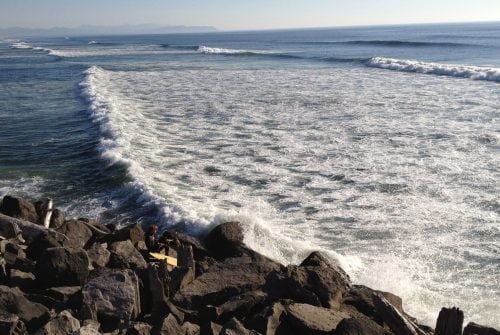
Some of Oregon’s most scenic and history-rich places are located in or around Seaside. In fact, within just a one-hour drive, yo...
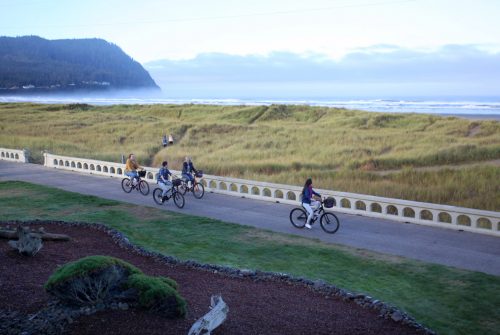
It’s difficult to imagine Seaside without the historic Promenade, the famous lamp-lined trail that stretches along the sandy bea...
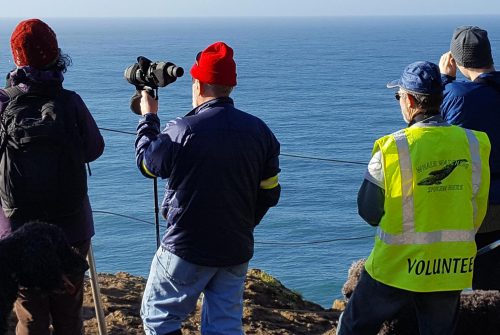
It’s possible to see gray whales off the Oregon Coast year-round, but one of two peak periods occurs in late March, when some 20...
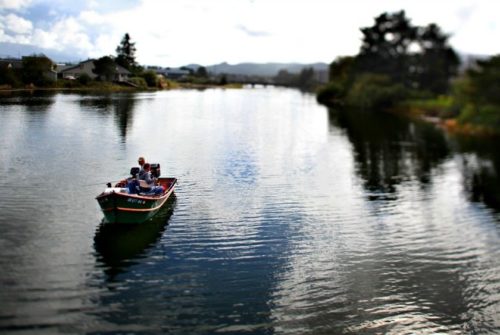
Fishing on the Oregon Coast near Seaside

Recalling Thanksgiving and Christmas traditions on Oregon

The Oregon Coast is a dynamic, ever-changing place that sparks both imagination and curiosity. While you may not be able to visit ...

I walked along the Prom last weekend on a beautifully bright and sunny day and found myself surrounded by walkers, runners, people on all sorts of wheels, strollers, couples holding hands, and dogs of all sizes leading their people around. I also heard all sorts of accents and languages-and saw plenty of cameras.

Seaside is known for a variety of outdoor activities to enjoy during most of the year and it’s not uncommon to have a 60-plu...

Just like the windswept Oregon coastline itself, Seaside is ever-changing. While embracing traditional attractions like the Promen...
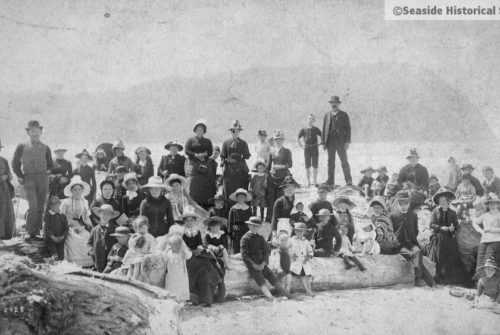
Seaside is a hot spot for family reunion get-togethers.
If your idea of the perfect beach getaway includes stretches of empty sand, hunting for sand dollars to the sounds of waves crashi...

Experiencing the changing seasons in Seaside
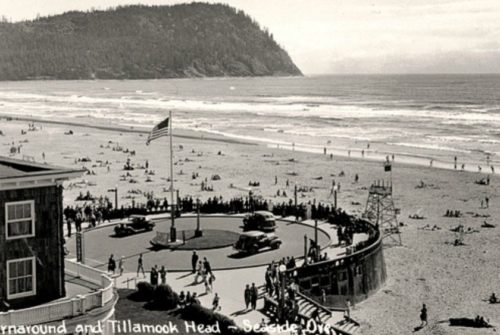
View from the old Seaside Hotel tower.

The Lewis and Clark expedition reached the sea near Seaside. Seaside has one of the most compelling stories you’ll find anyw...

Sam’s Seaside Cafe A well-executed burger shaped and grilled to perfection, layered with the proper ratios of ingredients, i...
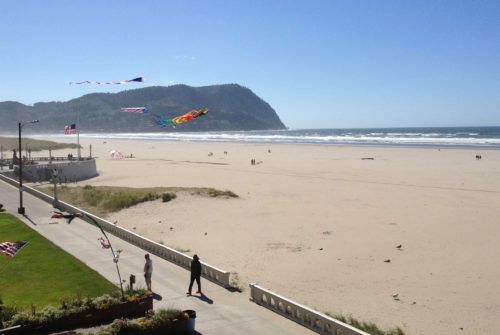
Summertime means it’s time to load the kids and pups into the car for a long weekend or weeklong vacation in Oregon’s original...

No one owns the Oregon Coast — it belongs to everyone. Thanks to 1967’s landmark Beach Bill, Oregon has some of the most prote...
Our website uses tracking technologies to learn how viewers interact with our site. We use this information to improve services and provide valuable content.

Terrible Tilly: Discover the Hidden World of Tillamook Rock Lighthouse in Clatsop County, OR
Construction: overcoming the odds, operational era: braving the elements, post-operational era: a new chapter, current status and preservation, viewing the lighthouse: a window to the past, frequently asked questions, can you go inside tillamook rock lighthouse, is tillamook rock lighthouse still in use, where can i see tillamook rock lighthouse, can you visit terrible tilly, where is the best place to see terrible tilly, who owns tillamook rock lighthouse.
Perched on a remote basalt rock in the Pacific Ocean, the Tillamook Rock Lighthouse is a testament to the ingenuity and determination of the people who built and maintained it.
Often referred to as “Terrible Tilly” or simply “Tilly,” this iconic lighthouse has a rich history of engineering feats, dramatic storms, and the brave men and women who served as its keepers.
In this article, we will delve into the fascinating story of the Tillamook Rock Lighthouse in Clatsop County, Oregon , from its challenging construction to its operation and eventual decommissioning, as well as its current status and how to view this historic landmark from nearby locations.
The United States Congress commissioned the construction of the Tillamook Rock Lighthouse in 1878. Initially, the plan was to build the lighthouse on Tillamook Head, but due to concerns about the height and potential obstruction by fog, the decision was made to build it on Tillamook Rock instead.
The project faced numerous challenges from the outset, with dangerous access to the rock, the loss of a surveyor during the project, and difficulty in recruiting workers.
Overcoming these hurdles, the construction team blasted the top of the rock to create a level area for the foundation. The lighthouse’s structure included a 62-foot tower with a first-order Fresnel lens and an attached keeper’s quarters.
The entire construction process took over 500 days to complete and cost $125,000, making it the most expensive West Coast lighthouse built at the time.
The lighthouse was first lit on January 21, 1881, and quickly gained a reputation for its challenging working conditions. Isolation and severe weather were constants for the lighthouse keepers, earning the structure its nickname, “Terrible Tilly.”
Several notable incidents, including the wreck of the Lupatia, marked the operational era. This ship sank near the rock in foggy weather, losing all 16 crew members.
The lighthouse was hit by numerous violent storms throughout its operational history, causing significant damage to the structure and even flooding the tower. In addition, keepers had to contend with broken windows, shattered lenses, and damage from debris launched by powerful waves.
Despite these challenges, the keepers dutifully maintained the lighthouse and its beacon, ensuring the safety of ships navigating the treacherous waters along the Oregon coastline .
Tillamook Rock Lighthouse was decommissioned in 1957, replaced with a whistle buoy, and marked the end of its service as an active navigational aid.
The lighthouse has changed ownership several times and functions as the Eternity at Sea Columbarium. In April 2022, the property was put up for sale, with the buildings needing complete renovation due to storm damage, nesting birds, and sea lions.
The lighthouse holds a place on the National Register of Historic Places and is also a part of the Oregon Islands National Wildlife Refuge . Unfortunately, access to the lighthouse is severely limited and is off-limits even to the owners during the seabird nesting season.
This designation helps to protect both the historic structure and the surrounding wildlife, ensuring that future generations can appreciate the unique story of the Tillamook Rock Lighthouse.
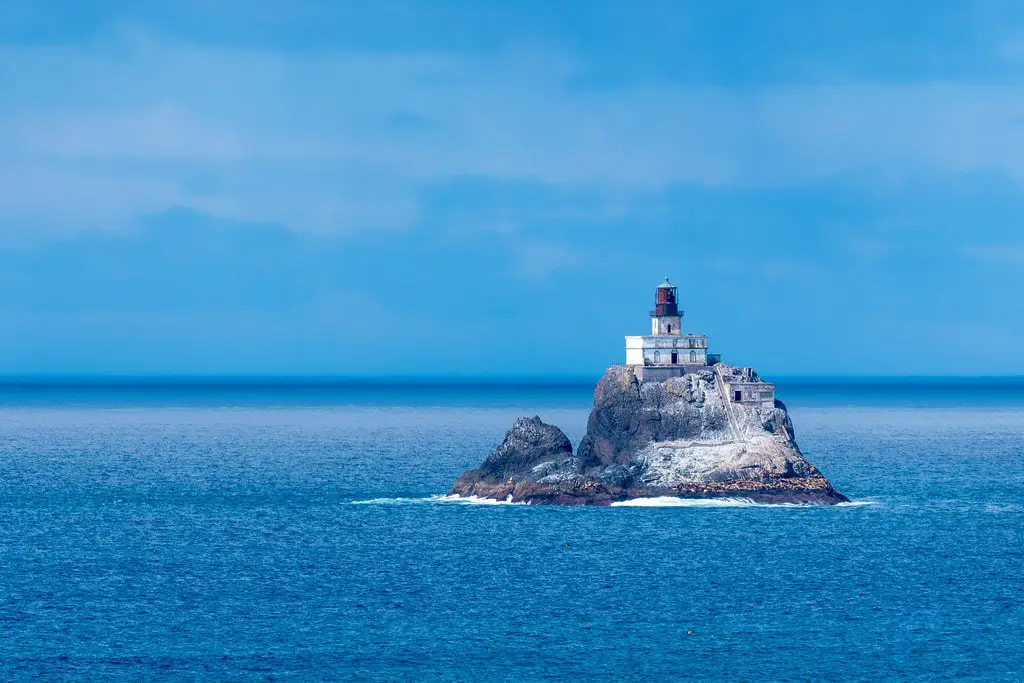
For those wishing to glimpse this historic landmark, Tillamook Rock Lighthouse can be viewed from nearby locations such as Seaside, Cannon Beach, and Ecola State Park.
Visitors can admire the rugged beauty of the lighthouse from these vantage points and reflect on the incredible efforts of those who built and maintained this beacon through some of the most challenging conditions imaginable.
You can view the lighthouse from the beach or the famous Seaside Promenade in the Seaside. To get a closer look, visit the Seaside Aquarium, where you can use their coin-operated binoculars to observe the lighthouse in detail.

Cannon Beach offers several viewing spots along its shoreline, including Haystack Rock, a well-known natural landmark. During low tide, you can walk up to the base of Haystack Rock and look north to see the lighthouse in the distance.
Ecola State Park provides some of the best views of Tillamook Rock Lighthouse. From the park’s scenic overlooks, you can take in the breathtaking panorama of the coastline and the lighthouse perched on its small rock. The park also offers several hiking trails that lead to vantage points with stunning views of the lighthouse and the surrounding natural beauty.
The Tillamook Rock Lighthouse is an enduring symbol of perseverance, resilience, and human ingenuity in adversity.
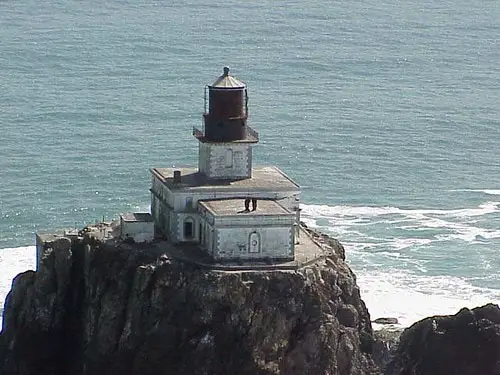
Its storied history, from its remarkable construction to its service as a vital navigational aid and its transformation into a columbarium, captures the imagination and inspires a sense of awe for those who view it from the Oregon coastline.
As we look upon this historic beacon, we are reminded of the sacrifices made by those who served as its keepers and the importance of preserving our maritime heritage for future generations.
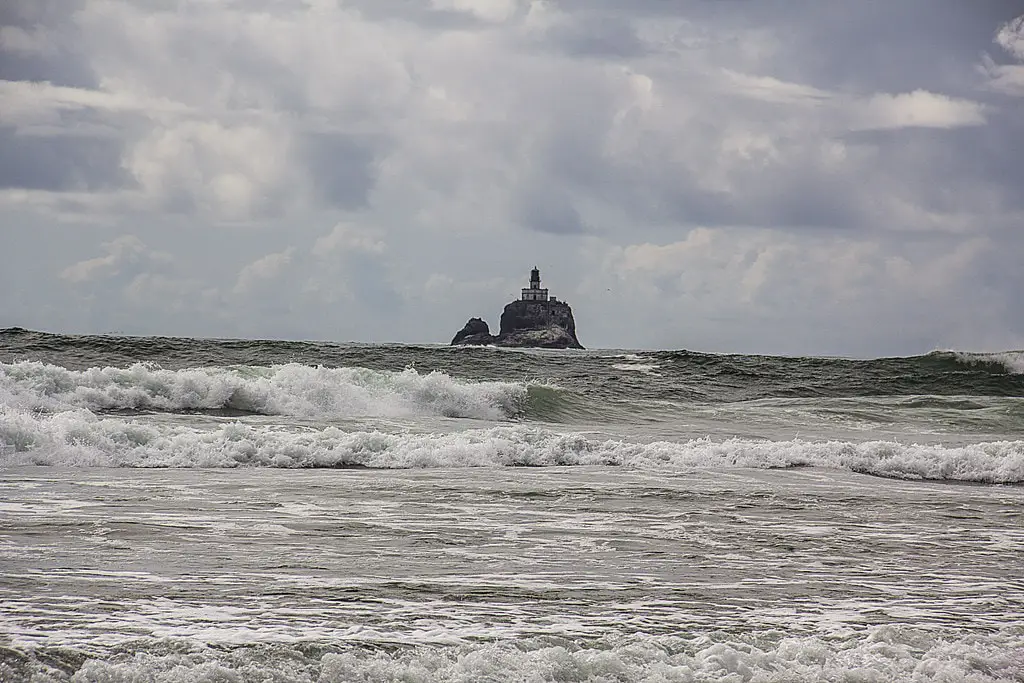
No, the Tillamook Rock Lighthouse is privately owned and not open to the public. Access to the rock is extremely limited, and the lighthouse is off-limits even to its owners during the seabird nesting season.
Tillamook Rock Lighthouse was deactivated in 1957 and is no longer used as a navigational aid. It has since functioned as a columbarium, although its license was revoked in 1999.
You can view Tillamook Rock Lighthouse from the coastal towns of Seaside and Cannon Beach, and Ecola State Park, which offers scenic overlooks and hiking trails with beautiful views of the lighthouse.
Visiting Terrible Tilly (Tillamook Rock Lighthouse) is not possible, as it is privately owned and not open to the public. However, you can admire the lighthouse from nearby coastal towns and state parks.
Ecola State Park is considered one of the best places to see Terrible Tilly, with its scenic overlooks and hiking trails offering stunning views of the lighthouse and the surrounding coastline.
Ownership has changed several times over the years since its decommissioning in 1957. As of 2023, Tillamook Rock Lighthouse is part of Oregon Islands National Wildlife Refuge and is still privately owned.
Save my name, email, and website in this browser for the next time I comment.
Privacy Policy - Terms and Conditions - Contact Us

Repeatedly the entire station was completely submerged in tremendous seas which, meeting the precipitous side of the great rock, swept upward and over the masonry and ironwork structure surmounting the crest. A section of the rock itself was torn away, great fragments of it being thrown over the station, many of them through the plate glass of the first order lantern, 16 panels of which were shattered, rock fragments 60 pounds in weight falling inside. Unbroken seas flooded the lantern, filling the watch room, where the keepers struggled to erect storm shutters in the shattered lantern panels, submerged at times to their necks before the rush of water could escape through the door into the tower and quarters below. The inrushing seas brought fragments of rock and glass, and even small fish, with the flotsam. Assistant Keeper Hugo Hanson�s hand was badly cut with flying glass. The oil vapor light was extinguished, the first order lens chipped and cracked, and the revolving mechanism so badly damaged that it was not repaired and operated until 6 days later. No light was displayed that first night, but the keepers succeeded during the night and the next day in clamping heavy wooden shutters, on hand for the purpose, into the lantern panels from which the glass panes had been broken, and thereafter displayed a fixed white light from a 300-millimeter lens lantern until the main light was repaired and its regular flashes restored on October 27. The storm raged for 4 days; the great seas thundering over the rock, preventing the keepers from leaving the confines of the tower and quarters until October 25.
Farewell, Tillamook Rock Light Station. An era has ended. With this final entry, and not without sentiment, I return thee to the elements. You, one of the most notorious and yet fascinating of the sea-swept sentinels in the world; long the friend of the tempest-tossed mariner. Through howling gale, thick fog and driving rain your beacon has been a star of hope and your foghorn a voice of encouragement. May the elements of nature be kind to you. For 77 years you have beamed your light across desolate acres of ocean. Keepers have come and gone; men lived and died; but you were faithful to the end. May your sunset years be good years. Your purpose is now only a symbol, but the lives you have saved and the service you have rendered are worthy of the highest respect. A protector of life and property to all, may old-timers, newcomers and travelers along the way pause from the shore in memory of your humanitarian role.

Tillamook Rock Lighthouse – Enigmatic Terrible Tilly
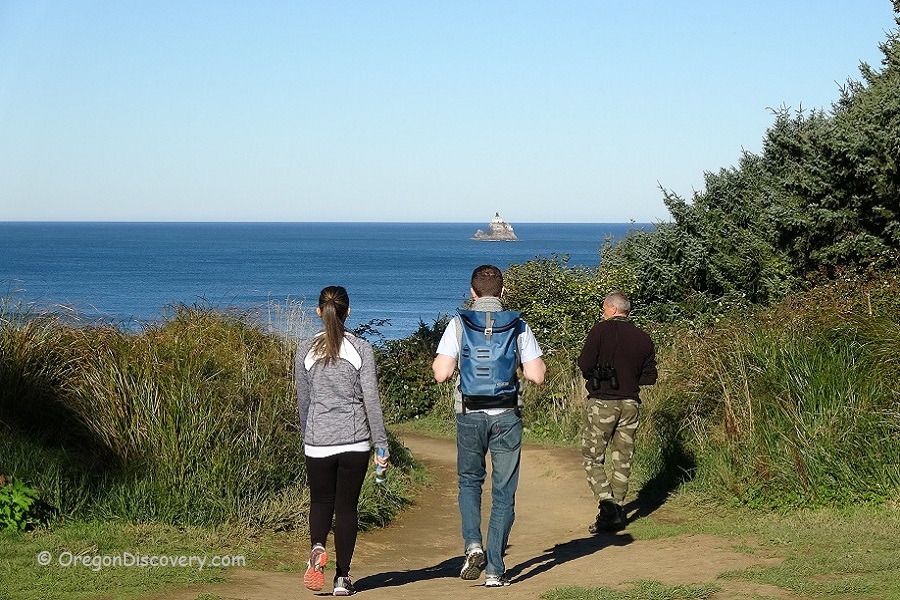
• Tillamook Rock Lighthouse, aka Terrible Tilly, is a mystery piece of the Oregon Coast • This is the most expensive lighthouse ever constructed in the U.S.
Tillamook Rock Lighthouse, also known as Terrible Tilly Lighthouse, is a unique and mysterious piece of Oregon Coast history. Located on the rock about a mile offshore from the Tillamook Head, this lighthouse probably has the richest history of all the Oregon lighthouses. This 62-foot light station towering 133 feet above sea level can be visible from Ecola State Park and Tillamook Head. Tillamook Head Viewpoints offer the best view of the lighthouse. It, however, requires a moderate difficulty hike - 1.3 miles (one way) from Indian Beach Day-Use Area State or 2.9 miles (one way) from Tillamook Head Trailhead in Seaside.
Terrible Tilly was one of the most expensive lighthouses ever constructed on the U.S. West Coast. The project’s final cost was $125,000 at the time, roughly $3.51 million in today's dollars. The name "Terrible Tilly" is the result of the severe weather conditions during its construction that claimed multiple lives.
The idea of building a lighthouse on an offshore rock was born in 1878. The construction survey was first done by H.S. Wheeler, who was highly skeptical about the entire project. He took two trips to Tilly's planned location to see what work was needed. Mr. Wheeler concluded that the project would be prohibitively expensive and even require using explosives to level up the surface of the rock.
The third survey trip was made by John Trewavas. Mr. Trewavas was an experienced stonemason who had previously completed lighthouses in similarly harsh conditions, including the Wolf Rock Lighthouse in England . Unfortunately, this trip was the last one for Mr. Trewavas -- he was swept away by a massive wave and was never seen again.
The third surveyor, Mr. Charles A. Ballantyne, had an even harder task. By then, Terrible Tilly had already gained a horrible reputation -- finding workers for the project was not easy. Nevertheless, Mr. Ballantyne managed to find a crew of men who had not heard of Mr. John Trewavas' death and was finally able to start the work.
In May 1880, the top of the rock was leveled by explosives, and the lighthouse construction began. At the beginning of January 1881, when the light was nearly complete, another tragedy struck Terrible Tilly.
The bark Lupatia was sailing in the area during the dense fog and high winds and got dangerously close to the shore. They were so close that Mr. Wheeler, who was in charge of the construction, could hear the sailors' voices. So he ordered workers to light a bonfire and place the lanterns in the tower to warn the ship crew that they were as close as 600 feet (200 meters) to the rock. Lupatia's crew managed to turn the bark away from the rock, but the ship got wrecked anyway. The next day, 16 bodies were washed on the shore of Tillamook Head. Only the dog fromLupatia survived.
Shortly after the Lupatia wreck, on January 21, 1881, the Tillamook Rock Lighthouse was first lit. After that, violent storms and strong winds became the new enemies of this ambitious project. Waves damaged the lighthouse multiple times; the tower got flooded because large debris brought by the storm broke the window of the lantern room, and so on. In the end, the lens was destroyed by the winds of 109 miles per hour (175 km/h) that launched boulders all the way to the top of the tower. The lens was eventually replaced by the aerobeacon with metal mesh installed around the lantern room to protect it from debris.
Terrible Tilly was decommissioned in 1957 and replaced by a whistle buoy. Ultimately, after decades of service accompanied regular damage inflicted upon the structure and the equipment, the light managed to break the record as the most expensive lighthouse to ever operate in the United States.
After the decommissioning, Terrible Tilly changed ownership multiple times and even became Eternity at Sea Columbarium in 1980. About 30 urns had been brought to Terrible Tilly before the Columbarium license was revoked in 1999. As of April 2022, Eternity at Sea put the property for sale.
Tillamook Rock Lighthouse | Facts
Tower Height: 62 ft (19 m) Focal Height: 133 ft (41 m) Built: 1881 Operation: Deactivated in 1957
Location: A mile offshore from the Tillamook Head Open: No public access
Ecola Viewpoint is located:
- 3 miles north of Cannon Beach
- 80 miles northwest of Portland.
Adventures Nearby
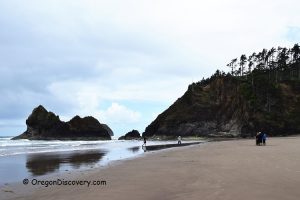
Directions to Terrible Tilly Viewpoins
From Highway 101 in Cannon Beach,
- Take N Alternative Route of Highway 101 and travel 0.4 miles southwest to 5th Street
- Turn right onto 5th Street and then slightly right onto Ecola State Park Road
- Drive 1.7 miles north on Ecola State Park Road and then turn left onto Ecola Park Road
- Continue 0.2 miles to the destination.
Ecola State Park - Get Google Maps Directions
Indian Beach Trailhead - Get Google Maps Directions
Leave a Reply Cancel reply
Your email address will not be published. Required fields are marked *
This site uses Akismet to reduce spam. Learn how your comment data is processed .
Oregon Discovery ©2024 All rights reserved
Tillamook Rock Lighthouse

Top ways to experience nearby attractions

Most Recent: Reviews ordered by most recent publish date in descending order.
Detailed Reviews: Reviews ordered by recency and descriptiveness of user-identified themes such as waiting time, length of visit, general tips, and location information.

Also popular with travellers

Tillamook Rock Lighthouse - All You Need to Know BEFORE You Go (2024)
- (0.19 km) Schooner's Cove Inn
- (0.25 km) The Waves
- (0.23 km) Land's End at Cannon Beach
- (0.17 km) Steps From Town, Steps From The Beach!
- (0.26 km) Inn at Haystack Rock
- (0.04 km) Mi Corazon Mexican Cuisine
- (0.06 km) Pie Girl & Pie Guy
- (0.07 km) Lazy Susan Cafe
- (0.14 km) Driftwood Restaurant & Lounge
- (0.15 km) Bill's Tavern & Brewhouse
A project of the Oregon Historical Society

Browse the complete list of entries

Browse curated collections of entries
- In the Classroom
- Primary Source Packets
- Staff and Board
- Digital Exhibits
©2020 Portland State University and the Oregon Historical Society
The Oregon Historical Society is a 501(c)(3) non-profit organization. Federal Tax ID 93-0391599
Tillamook Rock Lighthouse
By Cameron La Follette , Douglas Deur
Tillamook Rock Lighthouse sits on a rock a mile offshore of Tillamook Head in Clatsop County, Oregon. Operating from 1881 to 1957, the lighthouse was nicknamed Terrible Tilly for its ferocious storms and the difficulties facing lighthouse keepers stationed there. It was the most expensive lighthouse built in the United States up to that time.
In 1878, Congress appropriated $50,000 for a first-class lighthouse to facilitate navigation on the north Oregon Coast, particularly the approaches to the treacherous Columbia River Bar. The lighthouse was originally slated for Tillamook Head, located between Seaside and Cannon Beach, but officials determined that the south-facing landform would not provide good visibility for mariners seeking the Bar. Development plans turned to Tillamook Rock. Tillamook Head, declared surplus, was later donated by private owners to the state and became the nucelus for Ecola State Park .
An isolated, storm-battered basaltic island less than an acre in size, Tillamook Rock rises nearly 100 feet from the sea 1.2 miles due west from Tillamook Head and 20 miles south of the mouth of the Columbia River . Violently churning seas crash against the steep sides of the Rock and surge high up its sloping eastern face. Nineteenth-century reports describe it as home to hundreds of sea lions and countless seabirds, and Natives in the area considered the Rock as resource-rich yet exceptionally dangerous to people traveling by canoe.
Building a lighthouse on Tillamook Rock was perilous. The first person hired to undertake a survey, thirty-eight-year-old master mason and lighthouse builder John R. Trewavas of Portland , missed his footing on the eastern face of the Rock, and surging waters swept him into the sea. Local craftsmen were reluctant to work on the Rock, especially after Trewavas’s death, and construction foreman Charles A. Ballentyne hired eight skilled quarrymen from outside the area. The quarrymen stayed at Fort Canby, near Ilwaco, Washington, while awaiting the chance to slip out through storms to Tillamook Rock.
They made the trip on October 12, 1879, and the quarrymen constructed wooden shelters on the wet, sloping surface. They worked under trying conditions to dynamite the Rock's rounded head and level a space for the lighthouse. One gale swept away the supply house and marooned the workers for sixteen days. Native accounts suggest that workers also shot many sea lions, mainly to clear the rock for the ongoing construction.
By the end of May 1880, workers had flattened the top of the Rock, and the cornerstone for the lighthouse was laid on June 22. Two derricks ferried equipment and materials by cable to the construction site from ships below—the cutter Corwin and steam schooners Mary Taylor and George Harley , standing well off the Rock for safety. Workers unloaded everything from ashlar stone blocks to clean sand, as well as the fog signal boilers and the delicate first-order Fresnel lens . Construction took over two hundred days.
Tillamook Rock light began operations on January 21, 1881. The tall white tower stood 133 feet above sea level. The lighthouse ultimately cost nearly $125,000. After its initial appropriation of $50,000, Congress was forced to provide another $50,000 in 1880, and $25,000 in 1881, to cover the costs. Tillamook Rock’s construction cost nearly $3 million in 2016 dollars.
Duty at Tillamook Rock meant isolation, punishing storms, and a hazardous environment. Supplies were often delayed for days or even weeks, and communication was possible only by telegraph via an underwater cable to Indian Beach at present-day Ecola State Park . Monstrous storms often battered the Rock, contributing to the lighthouse’s nickname, Terrible Tilly. During a gale in October 1934, for example, winds of over a hundred miles an hour pounded the coast. Waves surged over the tower, shattering the Fresnel lens , and the battered lighthouse became a shambles of ruined equipment and flooded rooms as boulders crashed into the building. The telegraph cable was severed, and all of the landing gear was carried away. The keepers finally made contact with the mainland using a code-sending transmitter cobbled together of spare parts by keeper Henry Jenkins.
The first head keeper at Tillamook Rock, Albert Roeder, lasted only four months. Still, a number of keepers served for many years, among them William Dahlgren (1901-1919), Robert Gerloff (1903-1928), George Wheeler (1929-1952), and Oswald Allik, who started in the late 1930s and was serving as head keeper when the Coast Guard closed Tillamook Lighthouse on September 1, 1957. Tillamook Rock, by then the most expensive lighthouse in the country to maintain, had been made obsolete by modern radar and communications technologies.
Declared surplus, Tillamook Rock was sold several times. Real estate developer Mimi Morrissette purchased the property in 1980. She gutted the lighthouse and cemented its windows, converting it into the Eternity at Sea Columbarium. Those willing to pay between $1,000 and $5,000 (for the choicest spot, in the lantern room) could have their ashes interred there. The columbarium lost its license in 1999 due to inaccurate recordkeeping, and later license applications were rejected.
Still privately owned, Tillamook Rock is part of Oregon Islands National Wildlife Refuge, and the lighthouse is listed on the National Register of Historic Places. The seabirds and sea lions have returned.
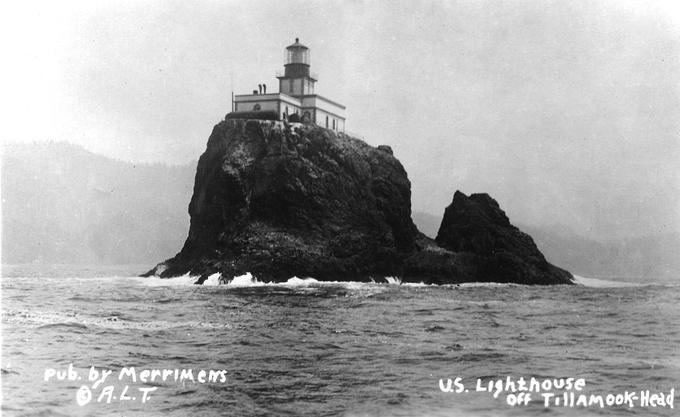
Tillamook Rock Lighthouse.
Courtesy Oregon State University Libraries, Gerald Williams Coll.
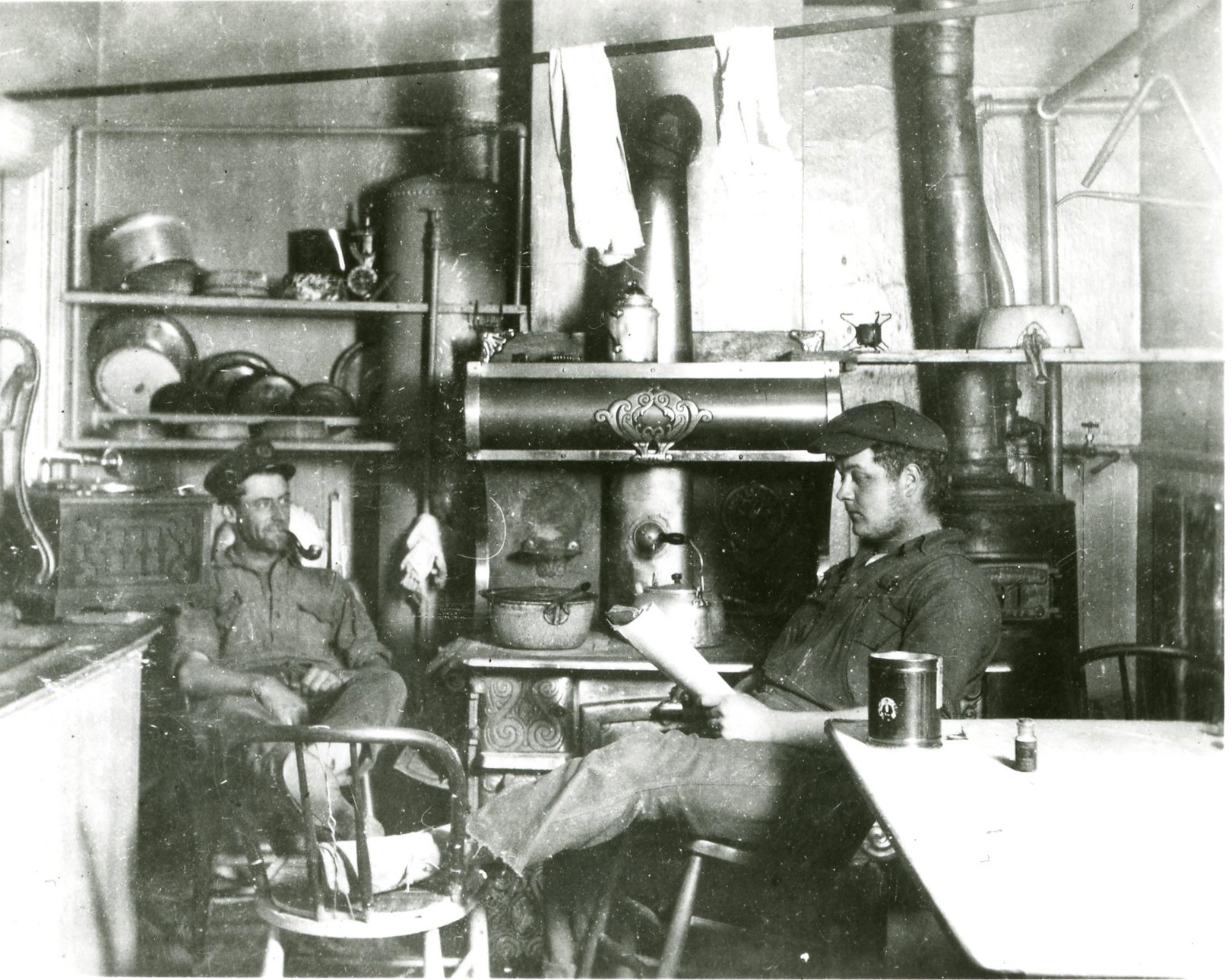
Keeper W. T. Lawrence (left) with unknown keeper, Tillamook Rock Lighthouse, c. 1920s.
Oregon Historical Society Research Library, 12571, photo file 654b
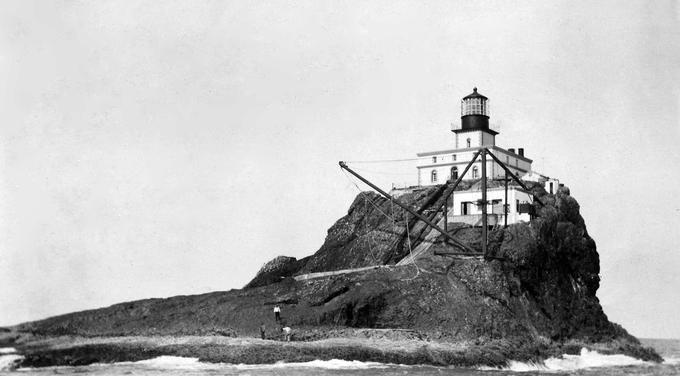
Courtesy Oregon Hist. Soc. Research Lib., 36626
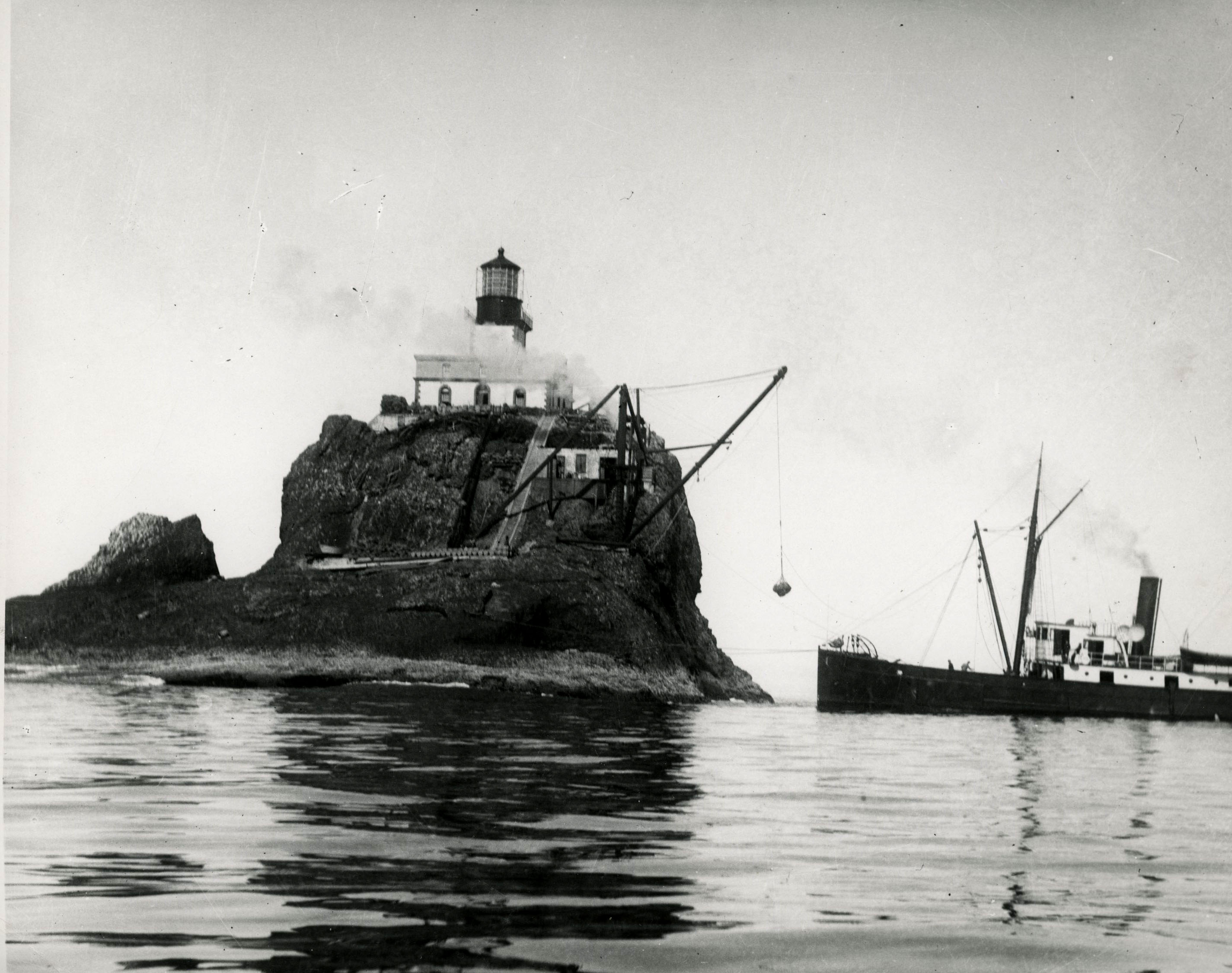
Courtesy Oregon Hist. Soc. Research Lib., 12848
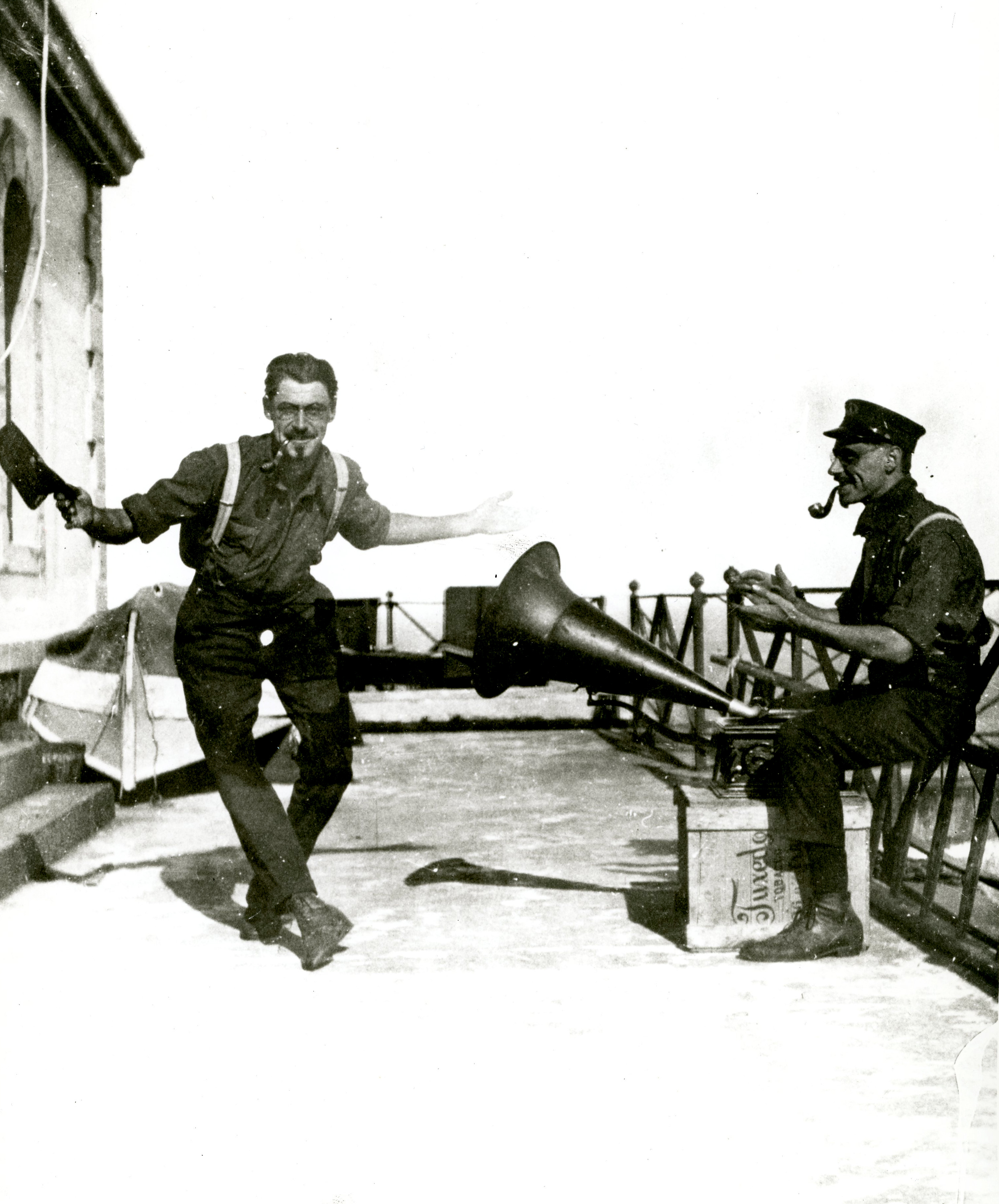
Keeper W. T. Lawrence (right) claps for a dancing colleague, c. 1920s.
Oregon Historical Society Research Library, 12572, photo file 654b
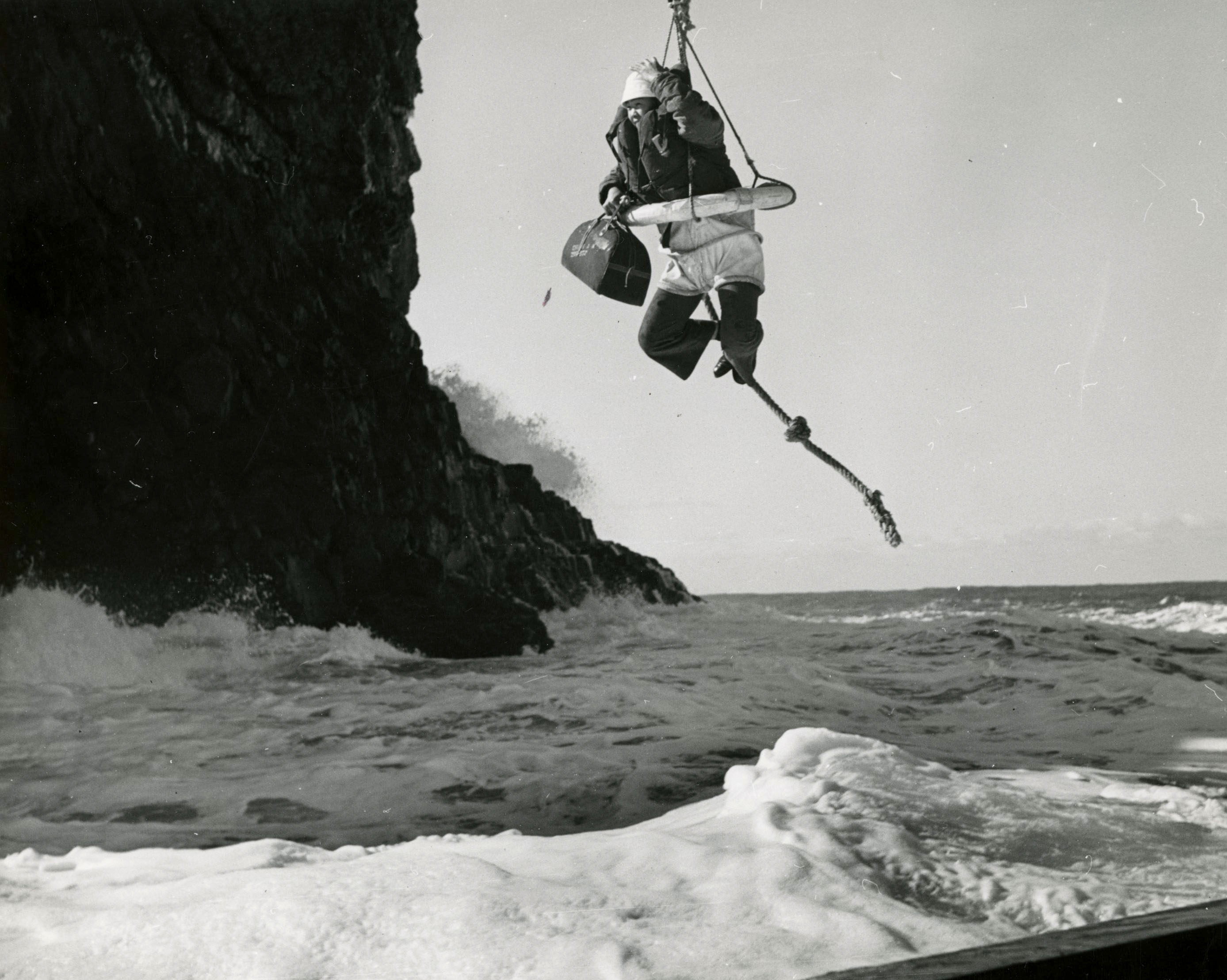
Tillamook Rock Lighthouse, rescue exercise.
Courtesy Oregon Hist. Soc. Research Lib., 10739a
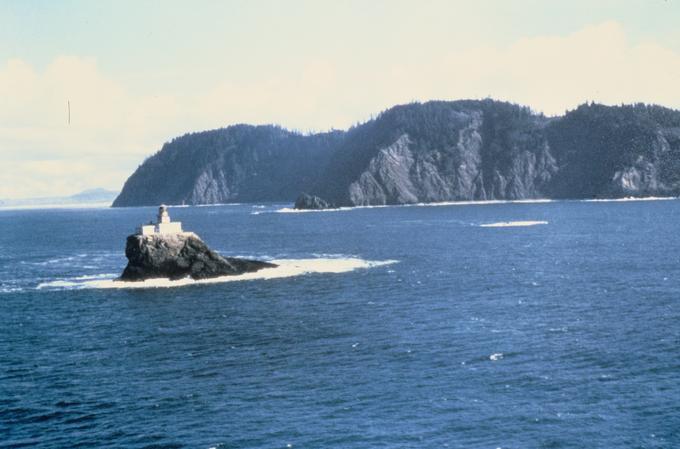
Courtesy University of Oregon Libraries, OSHPO, pna_01613
Related Entries
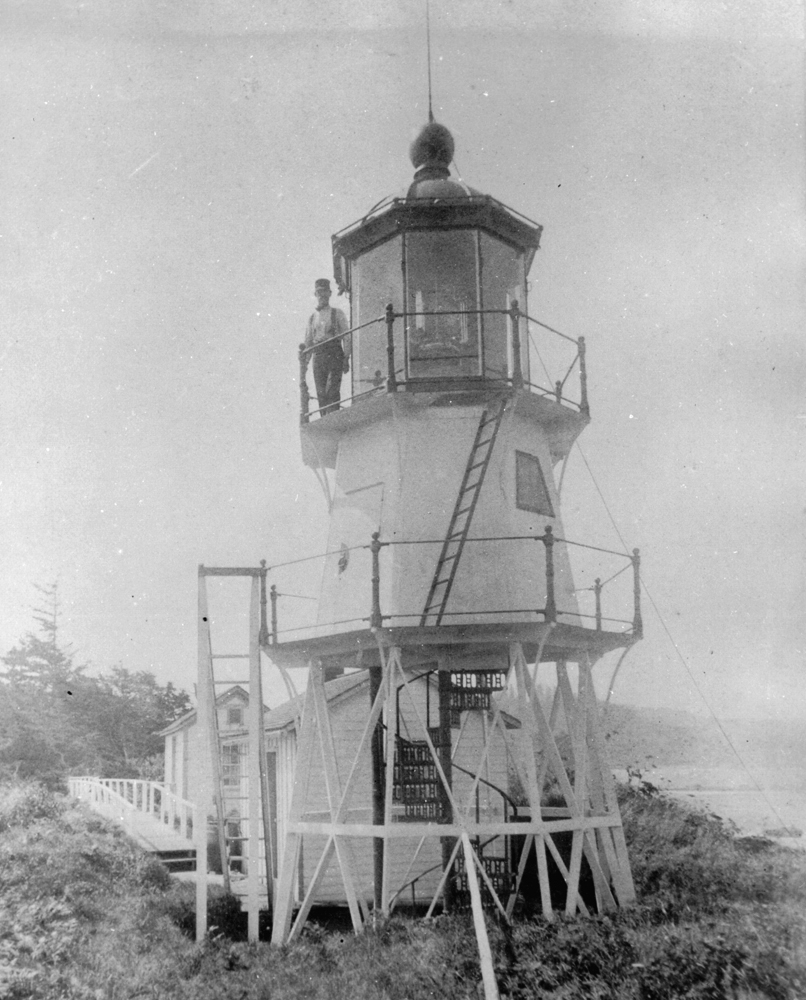
Cape Arago Lighthouse
The Cape Arago Lighthouse sits on a small island off Cape Arago, south …
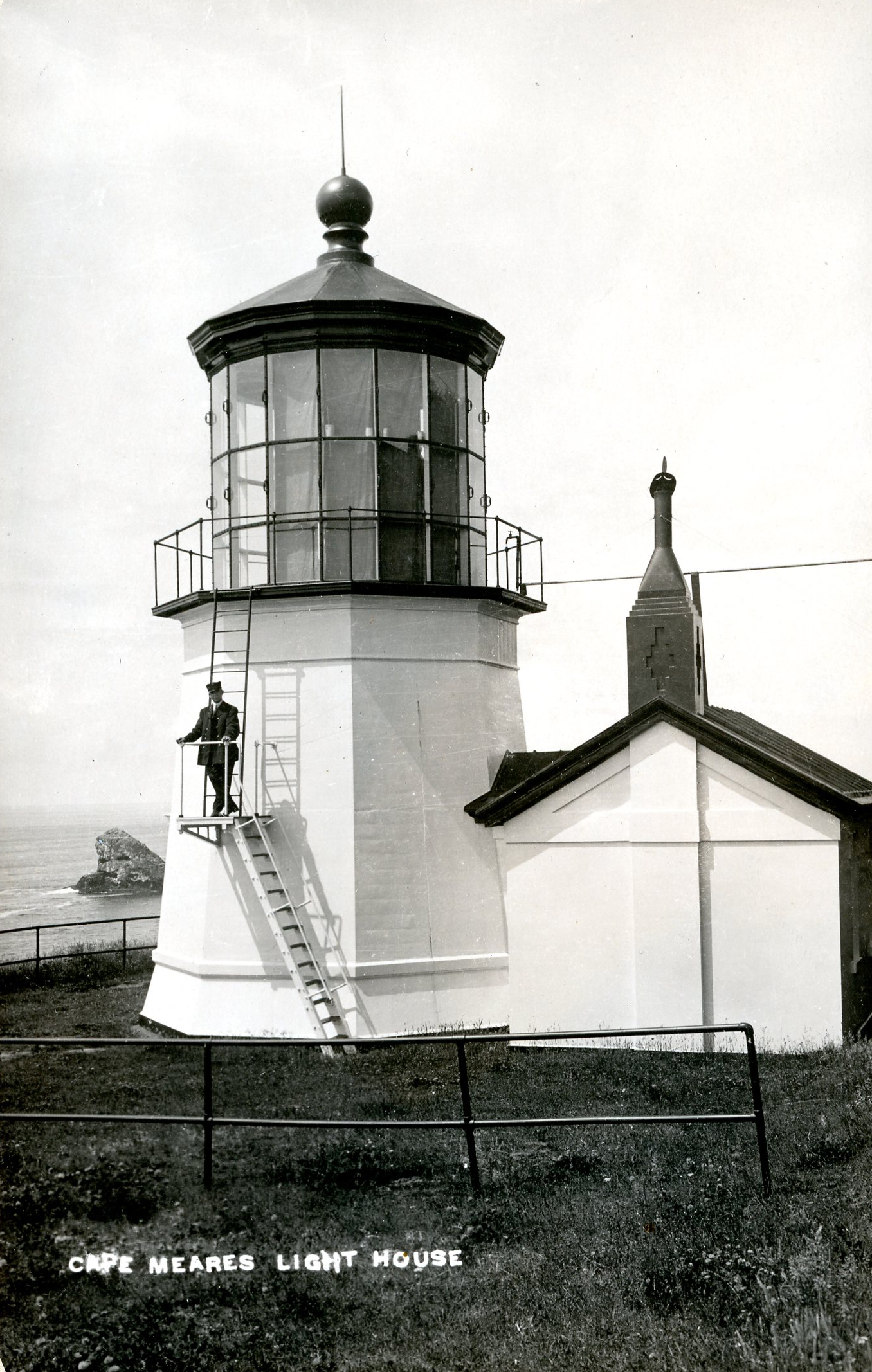
Cape Meares Lighthouse
Cape Meares Lighthouse is located atop Cape Meares, a scenic craggy hea…
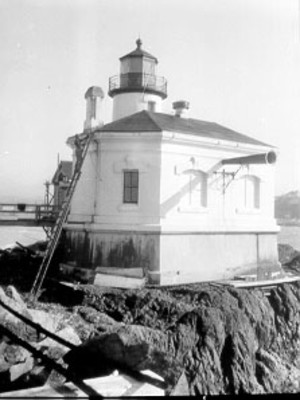
Coquille River Lighthouse
The Coquille River Lighthouse, which is adjacent to the Coquille River,…
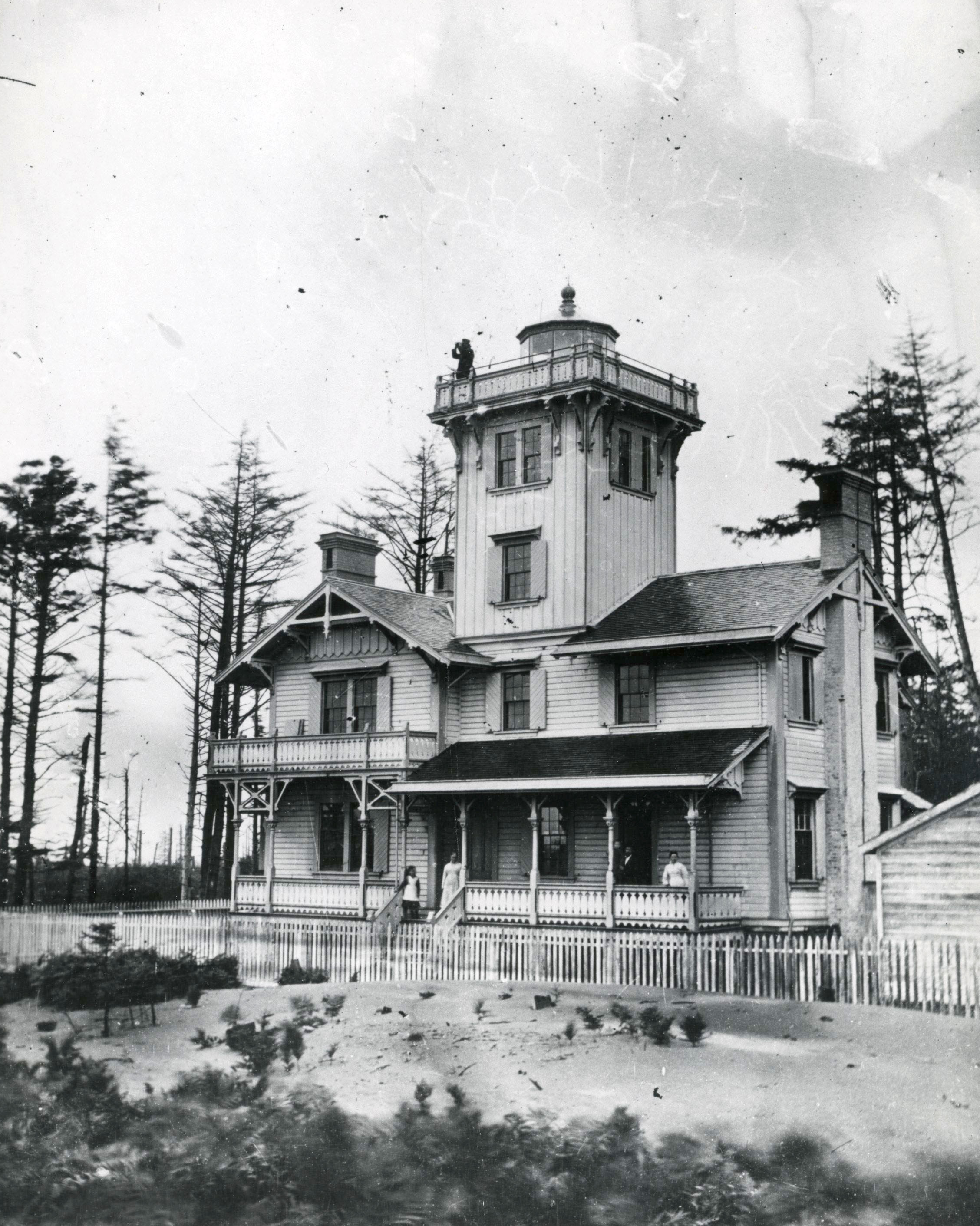
Point Adams Lighthouse and Life-Saving Station
Point Adams was given its name by Captain Robert Gray, who in his offic…
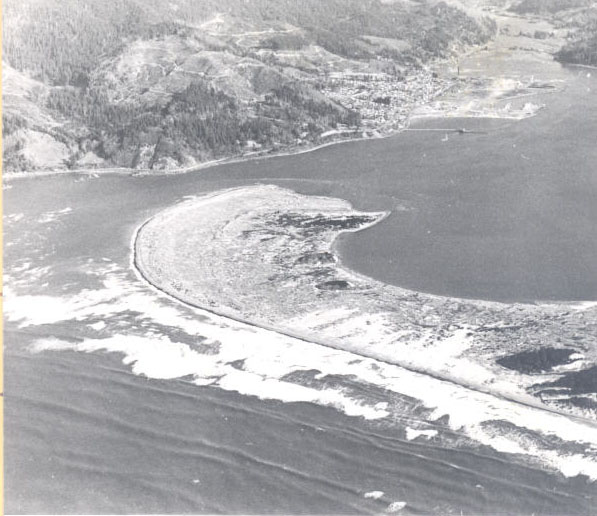
Tillamook Bay
Tillamook Bay, which encompasses a 597-square-mile watershed, is the la…
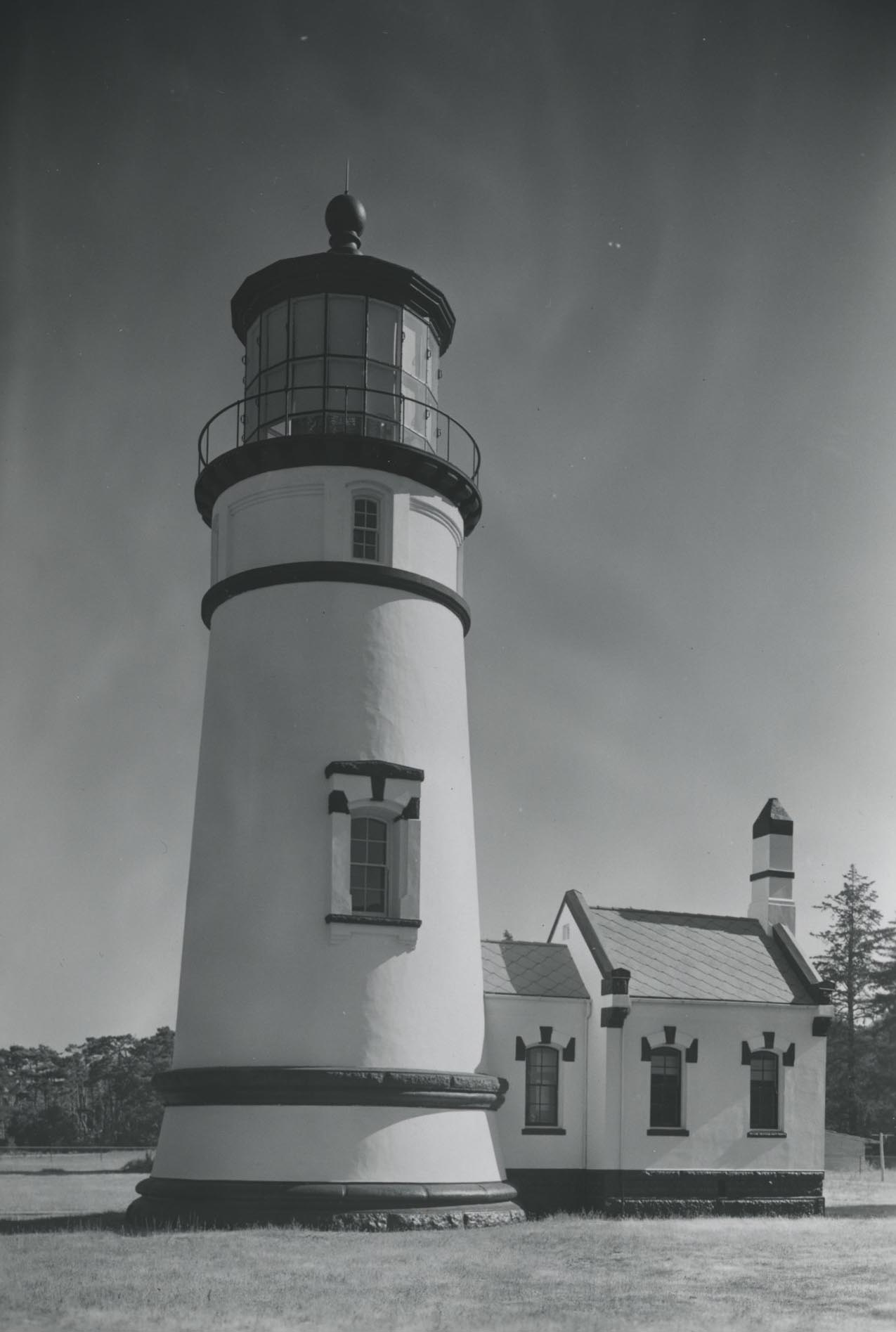
Umpqua River Lighthouse
The Umpqua River Lighthouse, Oregon’s first, was built twice. The U.S. …
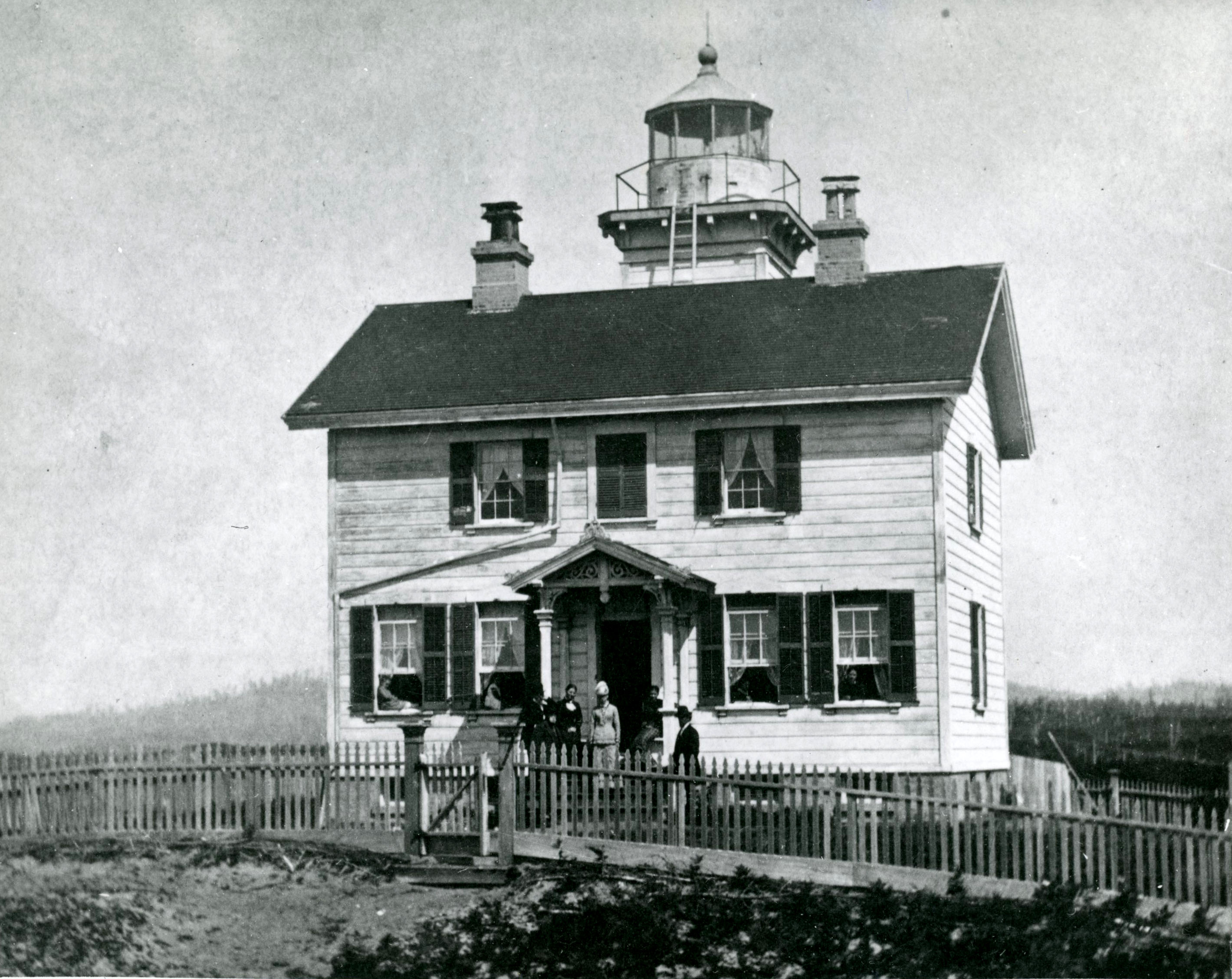
Yaquina Bay Lighthouse
Yaquina Bay Lighthouse, built in 1871, is the only wooden lighthouse in…
Related Historical Records
Map this on the oregon history wayfinder.
The Oregon History Wayfinder is an interactive map that identifies significant places, people, and events in Oregon history.
Further Reading
Deur, Douglas. Empires of the Turning Tide . Seattle, Wash.: USDI National Park Service, 2016.
Gibbs, James A. Oregon’s Seacoast Lighthouses. Medford Ore.: Webb Research Group, 1992.
Nelson, Sharlene, and Ted Nelson. Umbrella Guide to Oregon Lighthouses . San Luis Obispo, CA: EZ Nature Books, 1994.
Webber, Bert and Margie. “Terrible Tilly”: Tillamook Rock Lighthouse . Medford, Ore.: Webb Research Group, 1992.
Last updated
Feb. 27, 2024

- Workshop Login
- Tillamook Rock Lighthouse

Tillamook, Oregon - 1881 (1881**)
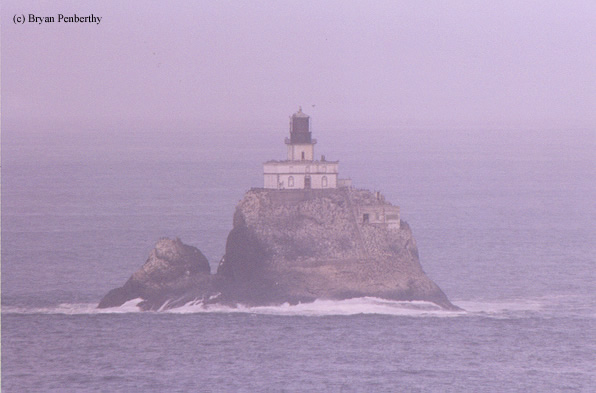
- All Lighthouses

History of the Tillamook Rock Lighthouse

Standing more than a mile offshore from Tillamook Head is an isolated basaltic sea stack that was frequented by thousands of sea lions. It would soon become known as "Terrible Tilly," after the federal government had established the Tillamook Rock Lighthouse in 1881.
As trade along the West Coast continued to grow year over year, the Lighthouse Board began looking to fill in gaps along the Pacific Coast of Oregon. They had established the Cape Arago Lighthouse in 1866 , the Yaquina Bay Lighthouse in 1871 , and its replacement, the Yaquina Head Lighthouse in 1873 .
By the late 1870s, the Lighthouse Board began to focus on Northern Oregon and the entrance to the Columbia River. In 1878, the Lighthouse Board had recommended construction of a lighthouse on Tillamook Head. Congress approved the $50,000 appropriation on June 20, 1878, but a survey of the location revealed several obstacles.
The first was the elevation of the headland. At nearly 1,000 feet above sea level, any light would be frequently shrouded in fog and therefore not be visible to ships. There were no natural "benches," or lower locations along the cliff to place a lighthouse. Although crews could have made one, frequent landslides gave cause for concern.
The final issue with the Tillamook Headland was accessibility. There was no approach from the sea, which would have necessitated opening and maintaining a road 20 miles long, over difficult and unknown land, which all materials to construct the station would have had to travel.
As there was no place to erect a lighthouse on Tillamook Head, the Lighthouse Board began looking offshore at the isolated Tillamook Rock. Although the board wanted an engineer to survey the rock in the fall of 1878, unfortunately, there were delays - severe weather and lack of a suitable vessel for transport to the rock.
By early June 1879, a lighthouse tender was able to transport H. S. Wheeler to Tillamook Rock, but the seas weren't cooperating, and therefore, he could not land. The lighthouse tender was able to get Wheeler close enough to the rock to convince him that it was large enough to build the light on it. He conceded that building a lighthouse upon the rock was going to be no easy feat, but admitted that it could be conquered.
Wheeler was ordered not to return Lighthouse District Office in Portland until he had surveyed the rock. On June 22, Wheeler and several sailors made the trip to Tillamook Rock aboard the U.S. Revenue Cutter Thomas Corwin and were able to land, but an approaching squall cut their trip short. As the seas were rising and they were afraid that the approaching storm would separate them from the vessel, they jumped into the water and were rescued by life lines.
Wheeler was ordered again to determine the feasibility of constructing a lighthouse on Tillamook Rock. He successfully landed on June 26, and although he couldn't take a complete survey, he was able to use a tape line and take approximate measurements. In his report dated June 30, 1879, he stated:
After several previous ineffectual attempts, a successful landing was made on June 26. It is an isolated basaltic rock divided, above low water, into two unequal parts, by a wide fissure with vertical sides running east and west, stands 100 feet above the sea, and has a crest which can be so far reduced as to accommodate a structure not greater than 50 feet square. A comparatively quiet landing can be made on the east side when the sea is smooth. The water on all sides is deep.
He then went on to report the issues with erecting the light on the headland and recommended that the Lighthouse Board place a fog signal upon the rock:
The light should be placed as low as possible, and the rock is its proper site. Though the execution of the work will be a task of labor and difficulty, accompanied with great expense, yet the benefit which the commerce seeking the mouth of the Columbia River will derive from a light and fog-signal located there, will warrant all the labor and expense involved. It is recommended that a siren fog-signal be erected at the station in connection with the light, and that $50,000 be appropriated to continue the work.
Wheeler submitted detailed plans and estimates for construction of the Tillamook Rock Lighthouse to the Lighthouse Board on July 11. On August 30, 1879, the State of Oregon had conveyed title to and jurisdiction over Tillamook Rock to the federal government. The Lighthouse Board authorized the plans on September 11.
Before the leveling, Wheeler felt it necessary to have a competent person land on the rock and take a thorough survey. John R. Trewavas, a master mason, from Portland was selected as he had construction experience with remote lighthouses, specifically the Wolf Rock Lighthouse, near Cornwall, England.
On September 18, while attempting to land on the eastern slope of Tillamook Rock, Trewavas lost his footing on the wet slope, slipped, and fell. As he went down, a wave immediately swept him off the rock and into the Pacific Ocean. A sailor named Cherry jumped in after him, and the boat crew rowed quickly to where Trewavas was struggling in the water, but he slipped below the water, drawn under by the undertow. His body was never found.
This incident quickly soured the public's opinion of the remote lighthouse and locals refused to work on the project. The new construction superintendent, Charles A. Ballantyne, was authorized to hire a crew of eight or more skilled quarrymen and transport them to the old keeper's dwelling at the Cape Disappointment Lighthouse . The workers were housed there until they could be transported out to Tillamook Rock, which was done largely to keep "the laboring party free from the idle talk of the town."
Due to high seas, the revenue cutter Corwin couldn't cross the Columbia Bar until October 12, when it proceeded to steam out to the rock and anchored 300 feet off the northeast side. On October 21, two men safely landed on the rock. A 4½-inch rope was then delivered to them, which they attached to a projecting ledge 85 feet above sea level, while workers affixed the other end to the mast of the Corwin . Unfortunately, it was impossible to keep the line taut, and occasionally, people and supplies were "dunked" in the ocean.
Attached to the cable connecting the Corwin to Tillamook Rock was a "traveler' which was designed to move back and forth. From there, three additional men and supplies were safely transferred from the ship to the rock by a "breeches buoy," which G. L. Gillespie, Lighthouse Engineer, described as the following:
It consisted of an ordinary circular rubber life preserver, slung from the traveler, to which was securely lashed a pair of breeches cut short at the knees, the latter and its attachments to support the man in the proper position when in the air, and the former to preserve his life if he should fall into the water.
After transferring the men and their provisions onto Tillamook Rock, the Corwin steamed back to Astoria as the seas had become rough. It came back five days later to deliver additional men and supplies.
Due to full exposure to the elements, the nine men spent their first fifteen days on the rock trying to provide shelter for themselves and their supplies. The first few days were spent sleeping in small A-tents, which were neither dry nor comfortable. They soon set up sleeping quarters on the southwest side but found it frequently deluged by the southwesterly seas. To remedy this, they moved their sleeping quarters to the north side.
Their next action was to level a spot for the derrick and then to begin leveling the rock at the 90-foot level. Although some of the rock chipped away rather easily, much of it needed large charges of black powder. This work continued throughout the winter, but on January 2, a nor'easter struck the rock.
The storm sent the waves crashing against and over the rock, carrying away the storehouse, provisions, a water tank, and the roof of the blacksmith shop. The storm reached its height on the night of January 9th. Although the men wanted to seek refuge on a higher level, per Mr. Ballantyne, the men were instructed to stay put in the supply house, which was on a lower landing, but somewhat sheltered. Fortunately, there were supplies of hard bread, coffee, and bacon stored there.
As the steamer couldn't get over the bar and into the Pacific Ocean for more than two weeks after the storm had subsided, rumors spread around town that none of the men had survived. The lighthouse tender made it out to Tillamook Rock on January 25 and found the men safe but in desperate need of fresh provisions.
Ballantyne worked the rock until May 1, when he was ordered ashore to monitor the construction of the appliances needed to land the stone and heavier materials. When he returned on May 31, the work of leveling was complete at 91.49 feet, and the crew had removed 4,630 cubic yards of solid rock. After 224 days of work, Tillamook Rock was ready for the construction of a lighthouse.
On January 15, 1880, the Lighthouse Board made a contract with Messrs. Chalmers, Holmes, and Jeffery, of Portland, Oregon in which they would deliver the stone needed for the lighthouse to the wharf in Astoria. By late May, the supplies were ready for transportation to Tillamook Rock, and after an unavoidable delay, the first batch made it to the Rock on June 17. A separate contract was made to charter a small steam wrecking vessel to move most of the supplies to the rock.
On April 20, 1880, a contract was made with Calvin Nutting & Son of San Francisco, California for $8,200, to supply a first-order lantern and the necessary metal work by September 1. Some of the metal work needed installation at the time of construction, which arrived on the Rock by July. The last section, together with the lantern, were delivered by September.
The Lighthouse Board requested duplicate first-class fog signals on June 21, 1880, for the Tillamook Rock Lighthouse. Due to the inefficiencies of the steam whistle at Point Adams, the board requested to source the signals from A & F Brown of New York City, the patentees of the equipment, at the cost of $5,100.
A & F Brown delivered the completed sirens to the General Lighthouse Depot in Staten Island on December 1. On January 13, 1881, they arrived in Portland, Oregon where they were tested and then sent via river boat to Astoria. Smith Brothers & Watson, of Portland, Oregon manufactured the locomotive-style boilers at the cost of $3,550. By February 11, all the equipment had been transported to Tillamook Rock and was operational.
On the dark stormy night of January 2, 1881, the British bark Lupata crashed into Tillamook Head. That night, the ship had been so close to Tillamook Rock that the lighthouse workers claimed they could hear the commands of the captain.
To warn the ship of the impending disaster, the workers lit bonfires and set off blasting charges, which successfully warned the Lupata away from Tillamook Rock. It wasn't until the morning when they spotted wreckage floating in the water that the workers realized that the Lupata headed eastward towards Tillamook Head, instead of westward into the open Pacific Ocean. All 16 crewmembers perished, the only survivor was an Australian Shepherd dog.
Nineteen days later, the Tillamook Head Lighthouse cast its characteristic white flash every 5 seconds for the first time from its first-order Fresnel lens. But, for the crew of the Lupata , it was nineteen days too late. The Tillamook Rock Lighthouse took 575 days to complete and came with a price tag of $123,492.82, which in 2017 would be around $2.8 million.
When finished, standing 90 feet above the ocean, was a one-story structure measuring 48 by 45 feet. Rising out of the middle of the structure was a 35½-foot; brick tower, which atop stood an eight-foot-tall lantern. Additionally, on the western side of the structure was a 32 by 28-foot extension to house the fog signal equipment.
In 1882, a few additional items were added to the station to complete it, which included railings, exterior iron stairway, a coal and engine house, tramway, landing wharf, bridge, and a retaining wall on the east side.
What the Lighthouse Board soon determined after building a lighthouse at such an exposed location was that it was going to require continual maintenance. A storm in January 1883 sent stones flying into the iron roof of the fog signal building leaving 20 holes. They were temporarily repaired with putty, and soon replaced with need galvanized sheet-iron.
A new landing bridge was established in June 1885 but was damaged by heavy surf that September. Although rebuilt by the following September, it would be destroyed again in December the following year. The storm of December 1886 caused an unprecedented amount of damage. The following is an excerpt from the Annual Report of the Lighthouse Board :
In December, however, the heaviest surf known there broke over the station causing the damages as follows: The roofs on the south and west sides of the fog-signal room and on the west side of the dwelling were crushed in by the water and the part on the north side of the fog-signal room was displaced. The roof was loosened at the south side of the tower, allowing water to leak into the dwelling. The plastering in parts of the dwelling was jarred off and some was loosened by the water. The galvanized-iron chimney-tops were broken from two of the chimneys. The concrete covering of the top of the rock around the building was broken, and a brick parapet and concrete filling in a low place outside the fence at the southeast corner were carried away. A mass of the filling, weighing about half a ton, was thrown over the fence into the inclosure [sic]. Three 730-gallon water-tanks filled with water at the west end of the building were broken from their fastenings and piled against the fence. The ash-chute on the north side of the rock and the spar for swinging the derrick boom were broken away, but the latter was saved by one of its chain fastenings. The platform around the derrick was destroyed and some planks were broken from the landing platform. The landing bridge was carried away, having stood till nearly the end of the storm, when it failed, apparently by the breaking of the pivot at the bottom of which the mast rested.
The weather delayed repairs until February 4, 1887. However, the replacement for the water tanks would have to wait an additional year due to the difficulty landing the bulky tanks on Tillamook Rock.
Storms that approached from the southwest had the tendency to send rocks into the lantern, smashing the glass, and at times, sections of the Fresnel lens even though it was 136 feet above the ocean. During one storm in 1889, ten panes of glass were broken, requiring replacement.
That year, in an attempt to stop the rocks, The Lighthouse Board recommended a "moveable shield of strong wire, having meshes of about 6 inches and covering a segment of about 90 degrees." It was to be put in place during stormy weather and was determined to have no effect in diminishing the light.
In 1890, $6,000 was appropriated for a telegraph line to connect the station to Fort Stevens. There were many delays over the years brought about by weather - the workload of the lighthouse tender and consent from landowners. But communication was finally established on November 4, 1895.
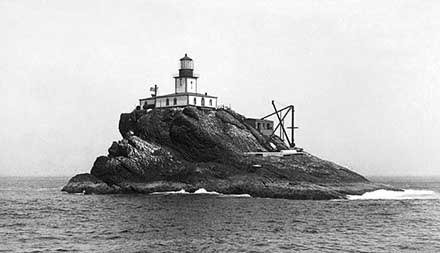
The mighty Pacific Ocean continued its assault on the lighthouse. On December 9, 1894, a severe storm sent waves crashing over the station. The storm broke 13 panes of glass in the lantern and damaged the lens and revolving apparatus. The gale also damaged the roof of the dwelling and fog signal building, allowing sea water to flood both buildings. It would be more than a week before a crew could land on the island and perform temporary repairs.
As the protective net over the lantern didn't seem to stop the panes of glass from being broken, the Lighthouse Board decided to cover the rock on the west and southwest sides with cement to prevent further disintegration.
Another storm which ran from December 6 to the 11, 1897 again damaged the roof of the dwelling and severed the telephone cable connecting Tillamook Rock to Fort Stevens. As the roof of the station was repeatedly damaged and leaked, the Lighthouse Board had it rebuilt with two-foot-thick concrete and steel I-beams. Contractors started the work on May 9, 1898, and finished by that September.
Over the years of service, the remote station had many additional brushes with storms. In each storm, rocks were hurled like projectiles into the lantern shattering panes of glass and letting in sea water which would flow down the stairs into the dwelling. In more than one instance, the sea was water carrying seaweed, fish, dead birds, and debris. In some cases, the trumpets of the fog horn would be full of rocks.
A storm in 1913 that lasted for 15 hours propelled so many rocks at the lighthouse that lighthouse author Jim Gibbs said that a "gunboat firing a full broadside could not have done more damage." However, this storm was nothing compared to the devastating storm that struck in 1934.
The storm struck the Oregon and Washington coasts on October 21. At the mouth of the Columbia River, keepers at the North Head Lighthouse clocked wind speeds at 109 mph. Relief Lightship 92 couldn't hold its position despite her moorings and full speed ahead on the engines.
Offshore, at the Tillamook Rock Lighthouse, things were much worse. Despite a focal plane of 133 feet above the water, the Pacific Ocean continually submerged the Tillamook Rock Lighthouse. When they hit the side of the rock, they were swept upwards and over the lantern. At one point, a section of the rock was torn away sending fragments, some as heavy as 60 pounds into the lantern.
Sixteen panels of the lantern were shattered allowing seawater to flood the watch room. With each subsequent wave, additional seawater, rocks, glass fragments from the lens, and even fish would enter the tower. The keepers struggled against the waves to erect storm shutters and at times, were submerged in seawater to their necks, until the water was able to funnel its way through the doorway into the tower and quarters below.
The storm badly damaged the massive first-order Fresnel lens and extinguished the oil vapor lamp. By the following night, the keepers were able to display a fixed white light from a 300-millimeter lens lantern. Six days would pass before the Lighthouse Service could repair the lens and reinstate its signature flash.
Assistant Keeper Henry Jenkins made a shortwave radio out of miscellaneous items around the station, including the telephone that no longer worked as the storm severed its cable. He succeeded in reaching an amateur operator ashore in Seaside, Oregon, who relayed his message to the superintendent.
When the storm finally subsided on October 25, the keepers found the fog trumpets choked with rocks and other debris, which caused them to fail and the hoisting derrick missing. The massive derrick, used to lift men and supplies onto and off of the island, was anchored by three-foot-long iron bolts into solid rock.
For their efforts to keep the light shining during the storm, Keeper William Hill, and assistants, Henry Jenkins, Hugo Hanson, and Werner Storm all received commendations.
As the repairs were going to run into the thousands of dollars, it was decided to modernize the station. The Fresnel lens was beyond repair and replaced with a modern rotating aerobeacon. Diesel engines installed in the fog signal house provided electricity for the station and light, and a row of batteries to provide backup.
Although it had received the nickname "Terrible Tilly," due to its remoteness and was said to be one of the most avoided stations in the whole country, there were some keepers that loved the location. One such keeper, Robert Gerlof served for an amazing 25 years (1903 - 1928.) He only left because he was he was approaching the mandatory retirement age of 70.
A newspaper interview quoted Gerlof as saying, "I do not want to leave my rock. I have no family. The sea is my friend. I do not want to go ashore." Gerloff had served previously on the Columbia Lightship and the lighthouse tender Columbine before taking the assignment at Tillamook Rock.
The last keeper at the Tillamook Rock Lighthouse was Oswald Allik, who turned the light off on September 1, 1957. He transferred to the Heceta Head Lighthouse where he served until July 20, 1963, the date that the Heceta Head Lighthouse was automated.
As the maintenance and upkeep at such a remote station had become too costly and the lighthouse was no longer near the steamer lanes, the Coast Guard replaced it with a lighted whistling buoy about a half-mile west of Tillamook Rock. However, after a few months, it too was decommissioned.
The Tillamook Rock Lighthouse was placed for sale by the General Services Administration in 1959 and sold to a group called the Academic Economic Coordinators of Las Vegas for $5,500. Although some of the group visited the rock before placing the bid, none visited after.
In 1973, the group sold the station to George Haupman, a General Electric executive, in 1973 for $11,000. He had plans to turn the station into a summer retreat, however, after visiting the island and seeing the condition of the lighthouse, he ended up selling to Max Shillock Jr. for $27,000 in 1978.
Shillock and three friends attempted to reach the rock in a 12-foot motorboat in heavy seas. On the way there, the boat capsized sending the men into the ocean. During the ordeal, one man drowned, and a Coast Guard helicopter rescued the other three men, a story which made the news.
Shillock soon defaulted on his loan and was sued by Mrs. Joy Goolsby, the loan holder. During the settlement, Goolsby became the sole owner and immediately placed Tillamook Rock back on the market. Due to the publicity of Shillock's rescue, there was a lot of interest in the property and Goolsby ended up selling the place for $50,000 just three years later.
The new owners, Eternity at Sea, a group of investors from Portland, planned to operate the Tillamook Rock Lighthouse as a columbarium. To convert the location into a crypt, they cemented over all windows and placed metal plates over the lantern panes. Although the plans appeared to be successful, by 1999 only 30 urns had been placed.
That same year, Eternity at Sea lost its license to operate as a columbarium as it was late in renewing its license. It had applied again in 2005, but the Oregon Mortuary and Cemetary Board rejected its application due to improper record-keeping and improper urn storage. The board said that rather than being placed in niches as required, the urns sat on boards and concrete blocks and therefore the lighthouse could not qualify as a columbarium.
Eternity at Sea's Ms. Morissette isn't giving up. She is still advertising for "Honorary Lighthouse Keepers," and her long range plan is to construct walls of niches in titanium that could hold 300,000 urns. When people ask her what if a tsunami hits the lighthouse, she tells them "their second choice better be to be buried at sea."
Today, nature is reclaiming what man took from them in 1879. The rock is a nesting place for sea birds, and seals and sea lions have returned to the lower sections. Due to an agreement with the U.S. Fish and Wildlife Service, the Tillamook Rock Lighthouse is a privately owned part of the Oregon Coast National Wildlife Refuge Complex. Because of this agreement, the rock is off limits during the spring and summer when the seabirds are nesting. Not even the owner can approach the rock.
- Annual Report of the Light House Board , U.S. Lighthouse Service, Various years.
- "The Halcyon Days of Oregon's Tillamook Rock Lighthouse," Debra Baldwin, Lighthouse Digest , July / August 2016.
- Report Upon The Construction of Tillamook Rock Light Station, Sea Coast of Oregon , G. L. Gillespie, 1881.
- "Terrible Tillie, Where the Departed Rest Not Quite in Peace," William Yardley, New York Times , October 24, 2007.
- "A Nice Place to Visit, But...," Richard Clayton, Lighthouse Digest , June 2000.
- Oregon's Seacoast Lighthouses , Jim Gibbs & Bert Webber, June 2003.
- "Tremendous Seas Sweep Tillamook Rock," Lighthouse Service, Lighthouse Service Bulletin , November 1, 1934.
Directions: The lighthouse sits several miles off shore. The best view would be from the water. However, there is a decent view to be had from Ecola State Park in Cannon Beach. There is a $3.00 fee to enter the park. After heading into the park, head to the left hand side. It will take you a short distance to a parking area. From here, if you walk up to the ocean, you can see the Tillamook Rock Lighthouse. I used a 1000mm telephoto lens for this picture.
Access: The lighthouse is owned by Eternity at Sea. Grounds / dwelling / tower closed.
Historic Structures

This lighthouse in Oregon is now a repository for crematory remains

Tillamook Rock Lighthouse is Oregon's only offshore light and the fourth oldest of nine lighthouses now standing on the state's coastline. Its construction, completed in 1881, was an engineering feat involving hazardous landings of men and materials by derrick and breeches buoy from a lighthouse tender anchored off the rock. Its roof was replaced and extra loft added to the keepers' quarters in 1889, at which time openings on the heavy weather sides (south and west) were filled. Its period of service as an aid to navigation extended more than 75 years under the jurisdiction of the U.S. Department of the Treasury Light House Keeping Service and, from 1939 on, the U.S. Coast Guard. It was superseded by a whistle buoy and decommissioned in 1957. Two years later, it was surplused by the General Services Administration and passed into more than 20 years of disuse under successive private ownerships, during which time ambitious dreams of a novel gambling casino and other enterprises faded.
Between April and September, 1980, the lighthouse on its tiny island site, a basalt outcrop, was refurbished by its present owner and its interior adapted as a columbarium, or repository for crematory remains. While the lighthouse is visible from nearby public beaches and from Ecola State Park on Tillamook Head, the only access to Tillamook Rock today is by helicopter. Deposits are made by the management of the new Eternity at Sea Columbarium a limited number of times a year as weather conditions permit. The lamp is in place in the lantern, but, under terms of the deed transferring title to private owners, the light may not be activated. Notwithstanding its change of use, the stone masonry lighthouse still embodies the distinctive characteristics of its type and possesses integrity of location, setting, design, materials, workmanship, feeling and association.
Of all the lighthouses built in the United States, Tillamook Rock Light is considered by many to be the most noteworthy. Its isolated and exposed position atop a solid basalt islet more than a mile offshore made it not only an extremely lonely post for its tenders, but also one of the most challenging. Since its powerful beam was first shown in 1881, it guided untold thousands of ships safely past one of the most hazardous sections of coastline on the continental United States and into the Columbia River shipping lanes, so prominent in the economic history of Oregon and the Northwest.
Constructed under the direction of the U.S. Army Corps of Engineers, the lighthouse was considered to be a significant architectural and engineering accomplishment. The fact that John R. Trewaves, a master mason with years of experience erecting lighthouses off the walls of England, was killed trying to complete the assigned task of surveying the rock prior to taking foremanship of the construction, is in itself a significant statement for the inventiveness of the men who were able to complete the job.
In June of 1879, District Superintendent of Lighthouse Construction, John R. Wheeler, was able after numerous other attempts, to make a successful landing on the rock in order to survey its topography, prior to beginning construction. This landing party is considered to be the first ever to set foot on Tillamook Rock. However, unable to land his surveying equipment, Wheeler was forced to make his survey with only a tape measure.
The difficult task of construction was begun in October of 1879 under the supervision of Charles A. Ballantyne. Against all odds, Ballantyne assembled a construction crew, kept them away from negative public opinion for twenty-six days until the weather allowed a landing attempt, transported them to the rock, and invented an ingenious method for transporting men and equipment from a ship anchored a safe distance off the rock to the construction site.
Experiencing great difficulty in landing initial supplies and men, it became obvious to Ballantyne that a method other than jumping from small boats to the rock would have to be employed. He answered the need by rigging a heavy rope between the top of the rock and the mast of a ship, and devising a traveler pulley mechanism to transport men and supplies from the ship to the island. This method was used during the initial construction and was later replaced with the huge derrick during the lighthouse's active years.
While the construction crew lived in makeshift quarters, braving the bitter winter elements, the top thirty feet of the rock was blasted off to create a level foundation. Finally on June 24, 1880, the construction of the massive derrick was complete, and the cornerstone of the lighthouse was laid in place. At that time, huge oblong basalt blocks, quarried from Mount Tabor in Portland, Oregon, were laid in place one by one, to form the walls of what was considered the sturdiest lighthouse ever built in the United States.
Construction continued until January 3, 1881, on which date the purpose of the undertaking became clear to the men involved. On that night in a dense fog, the British bark, Lupatia, like so many before her without navigational aid, ran aground on nearby Tillamook Head, taking with her the lives of the entire crew.
The tragedy so effected the construction crew that their efforts were redoubled. Only three weeks after the disaster, on January 21, 1881, 575 days after the beginning of construction, the original Fresnel lamp was placed in operation for the first time. Construction costs totaled the unheard-of sum of $123,493. It was the most expensive lighthouse ever built on the West Coast.
The completion of the task of construction was so lauded that, on the basis of this feat, Major G. L. Gillespie, Designer-Engineer of the project, was eventually promoted to Commander of the Army Corps of Engineers.
With the exception of the addition of a second story over the keepers' quarters and a sturdier than original concrete roof over all areas in 1898, the lighthouse remained very much as she was built for 76 years of service. Withstanding all the most destructive forces nature and the sea could subject it to, Tillamook Light provided safe passage for untold numbers of ships passing the perilous northern Oregon coastline in search of the Columbia River shipping lanes.
In 1939, Tillamook Light, as did all U.S. Lighthouses, came under the jurisdiction of the U.S. Coast Guard. In a move to economize, Congress disbanded the civilian-operated U.S. Lighthouse Service. Afterward, Tillamook Light was manned by Coast Guard personnel except for its principal keepers, who remained civilian.
With the inception of less costly modern electronic equipment, lighthouses began to go out of use in the mid-20 th century. Tillamook Rock Lighthouse was no exception. Replaced by a signal-sending electronic buoy, the lighthouse was decommissioned. The last log entry commissioned by the legendary civilian head keeper of twenty years, Oswald Allik, to Jim Gibbs, a former attendant of the lighthouse when serving the U.S. Coast Guard, read as follows:
"Farewell, Tillamook Rock Light Station. An era has ended with this final entry, and not without sentiment I return thee to the elements. You, one of the most notorious and yet most fascinating of the sea-swept sentinels in the world; long the friend of the tempest-tossed mariner. Through howling gale, thick fog and driving rain your beacon has been a star of hope and your foghorn a voice of encouragement. May the elements of nature be kind to you. For 77 [sic.] years you have beamed your light over desolate acres of ocean. Keepers have come and gone; men lived and died; but you were faithful to the end. May your sunset years be good years. Your purpose is now only a symbol, but the lives you have saved and the service you have rendered are worthy of the highest respect. A protector of life and property to all, may old timers, newcomers, and travelers along the way pause from the shore in memory of your humanitarian role. September 1, 1957."
In 1959, the General Services Administration put the lighthouse up for sale by sealed bid after the State of Oregon refused possession. It was purchased by a Las Vegas group called Academic Economic Coordinators for $5,600. This group did nothing with the lighthouse in seventeen years of ownership and finally sold it in 1973 to a Senior General Electric Executive, George Hupman, for $11,000.
Hupman's attempts to convert the lighthouse into a summer retreat proved fruitless and he eventually sold it in 1978 to Max M. Shillock, of Portland, Oregon, for $27,000.
In a scandal given statewide publicity, Shillock was accused of swindling a Eugene woman out of the money to purchase the lighthouse. In early 1980 the lighthouse reverted to her ownership, but was immediately purchased by Mimi Morissette for the purpose of restoration and conversion to a Columbarium at Sea. With acquisition cost of $50,000, Tillamook Rock Lighthouse was subsequently rehabilitated.
Lighthouse Description
Tillamook Rock Lighthouse is situated on a concrete terrace atop a basalt islet 1.2 miles off Tillamook Head on the northern Oregon Coast. The focal plane of its lamp is nearly 145 feet above mean sea level. The complex consists of a two-story stone masonry lighthouse keepers' dwelling with a single-story fog signal wing centered on the west elevation, a cistern, a supply house below the terrace, and concrete stairs descending to a concrete pad, or wharf at the base of the rock. The square light tower rises above the center of the low hipped roof of the lighthouse and is encircled by an observation deck and railing and is surmounted by a conical-roofed lantern. The coursed ashlar exterior walls of the lighthouse are trimmed with rock-faced staggered quoins, and original round-arched door and window framements are similarly finished with rock-faced ashlar.
The 45-foot by 48-foot two-story keepers' house was divided into five interior living spaces, an office, kitchen and dining area, and an eighth room used for additional food storage. Stairs led to a work and storage area in the upper story.
Through the center of the first level, running east and west, was the central hall which passed through the light tower foundation, which occupied in turn a 16 foot-square area at the center of the keepers' quarters. From this base the light tower projects skyward to a height of about 54 feet from the top of the rock to its peak, and nearly 145 feet above the ocean mean level.
Located off the westernmost wall of the keepers' quarters, and sharing a common wall with the keepers' quarters, is the 28-foot by 32-foot fog signal room which originally housed the steam boiler used to operate the fog signal as well as diesel generators which provided the sole power source to the light station.
The exterior walls of the structure are constructed of 14 inch-thick basalt stone blocks, as are the first thirty six feet of the walls supporting the light tower. The interior areas of the stone block walls are lined with red brick, thus making the total thickness about two feet in the main building and up to four feet at the corners of the tower base.
At the 36-foot level of the tower is a surrounding steel catwalk and railing. It is at this point that the tower changes from the sixteen foot square base construction to a 14-foot diameter, 8-foot high turret formed by two layers of brick totaling sixteen inches in thickness and comprising the foundation of the cylindrical steel and glass lantern room.
The roof of the tower is comprised of wedge-shaped steel plates forming an inverted cone topped by a steel sphere and lightning rod.
Surrounding the lantern room windows is a steel chain mesh storm guard which was added in 1935 after a severe storm caused damage to the original lantern and forced the replacement.
Within the tower is the most noteworthy interior architectural feature, a 77-step steel spiral staircase which winds it way along the interior walls of the tower from the first floor to the steel plate floor of the lantern room.
In 1898, following a number of storms in which the original steel plate roof supported by a series of wood joists and rafters was damaged, a new roof, constructed of 10 inch steel "I" beam supports and a 2-foot thickness of concrete, was added. At the same time what had been an attic storage area over the keepers' quarters was converted to a second story with a 6-foot ceiling clearance.
As originally designed, the main structure had tall round-arched windows as follows: two on either side of the main entrance centered in the east elevation, two in both the north and south walls of the keepers' quarters, two in the western wall of the keepers' quarters on either side of the fog signal room, two in the southern wall of the fog signal room, one In the westernmost wall, one alongside the secondary entrance to the building in the north wall of the fog signal room, one each in the east and west walls of the light tower, and four portholes spaced evenly around the turret portion of the light tower.
However, around the time the second story was added in 1898 the six windows with either a southern or western exposure were cemented in as further storm-proofing, with the two in the south wall of the keepers' quarters and the one in the west wall of the fog signal room being allowed 18-inch portholes as replacements. A porthole was added to the staircase room at the southwest corner of the keepers' quarters, and six small openings were made in the second story (three in the north wall, and three in the east).
Surrounding the lighthouse proper is a concrete walkway, originally lined by a steel cable and post guard rail. At the east side, the walkway widens into a platform or terrace about 70 feet deep and 70 feet wide.
Because the rock beneath the platform slopes away sharply, it was necessary to construct a stone block foundation of some height. In the space beneath the platform, cisterns for capturing and holding fresh rainwater were installed. Another cistern was built halfway above platform level parallel to the north wall at the easterly corner of the keepers' quarters.
Also built alongside the north wall of the building, was a privy constructed of brick and cement. The facility was eventually superseded by inside plumbing and a water closet located in the northwest corner of the fog signal room.
Beginning at the northeast corner of the afore-mentioned platform, a long flight of concrete stairs descends the gentlest slope of the rock to the 20-foot by 30-foot by 12-foot brick on concrete supply house located approximately 20 feet below the base of the lighthouse platform. The stairs then descend to a concrete slab located at the base of the rock. This lower platform was used as a loading platform in conjunction with the derrick.
The derrick, used to load and unload both supplies and personnel during the lighthouse's active years, succumbed to gradual deterioration brought on by the salt water and years of neglect. All that remains of the mighty oak mast is a short stump to hold its place in the giant steel swivel, which is based in concrete and anchored with steel bolts in the native rock of the island.
Constructed of stone, brick, concrete, and steel, Tillamook Rock Lighthouse has, with the exception of its nonsupporting wood and plaster interior walls and floors, withstood the test of time quite admirably, showing no real signs of exterior decay. Exposed steel components, railings and tanks, for example, were rusted and in need of paint. Windows, long since shot out by passing boaters, are now filled in with concrete block. The building has been repainted. With routine maintenance hereafter, it should stand indefinitely.
The management of the Eternity at Sea Columbarium removed all perishable wooden interior walls, floors, beams, and other such interior components, sealed off all openings with masonry, except the double door entrance located in the north wall of the fog signal room. An interior concrete platform was constructed to replace the original wooden floor. After interior partitioning was removed, the space was fitted with a honeycomb of sleeves to be filled with crematory urns.
Although all windows and doors are permanently sealed save one, they are on the exterior painted to appear from the nearest onshore viewpoint (Ecola State Park) as they did in their original form.
Additional Information
- Built: 1879-1881
- Architect: Colonel G. L. Gillespie, U.S. Army Corps of Engineers
- Address: About 1.2 miles off Tillamook Head southwest of Seaside
- City: Seaside
- County: Clatsop
More Information and Pictures
Recent articles.
- Mobley Hotel, Cisco Texas
- North Fort Worth High School, Fort Worth Texas
- Elm Court Estate, Butler Pennsylvania
- Hamden Covered Bridge, Hamden New York
- Tyrconnell House and Gardens, Baltimore Maryland

- Next Page Pictures

Miles with McConkey
Fabulous Oregon Lighthouses to Visit on Your West Coast Trip
Posted: April 15, 2024 | Last updated: April 15, 2024
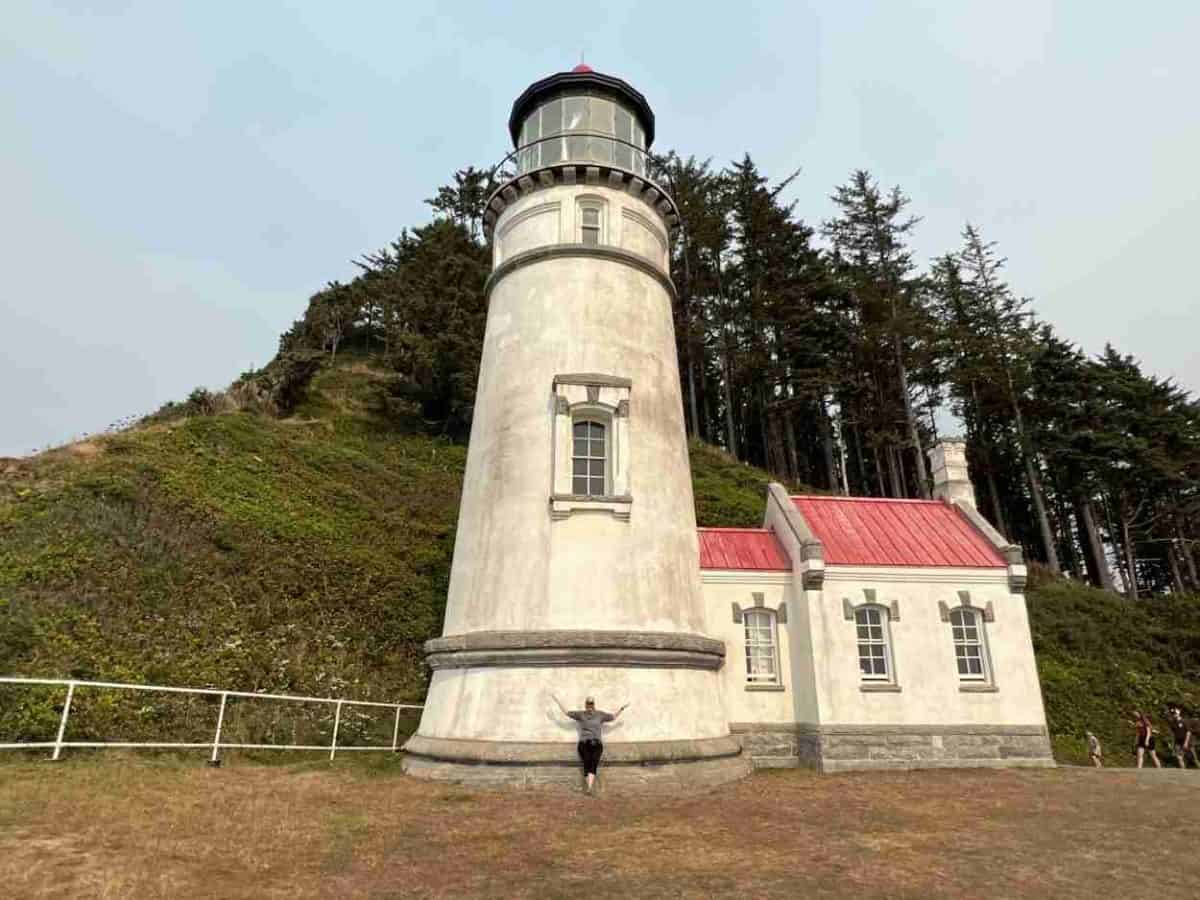
While I am fascinated by a smoky gray, rolling fog, I do not enjoy driving in it. I cannot imagine the terrifying challenge of navigating a ship through a thick fog. That may be why I was so enamored with the Oregon lighthouses during our drive along the state's scenic coast.
There are many wonders on Highway 101, but please take time to admire some of the lighthouses along the journey. For years, the beacons have safely guided mariners along the treacherous rocky shores.
To give you a brief history, the U.S. Army Corps of Engineers built most of Oregon's lighthouses in the late 1800s. While the U.S. Lighthouse Board initially managed the towers, the U.S. Coast Guard took over these duties in 1939. In the 1960s, the Coast Guard installed automatic beacons and began delegating management to local government agencies. Oregon has nine surviving lighthouses, all of which are on the National Register of Historic Places. We will outline the fabulous Oregon lighthouses from north to south to guide you safely through the fog.
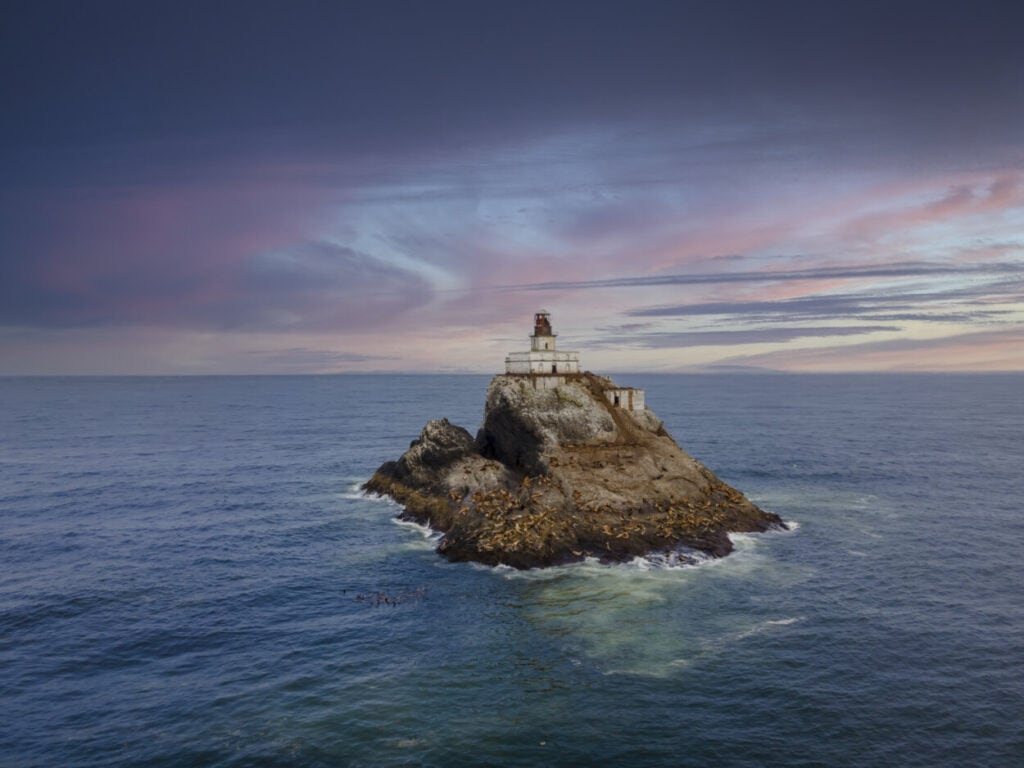
Tillamook Rock Lighthouse
Year lit: 1881
Height: 62 feet
Many people find the Tillamook Rock Lighthouse fascinating. It sits about a mile offshore from Tillamook Head, 133 feet above sea level, on a rock battered by the Pacific Ocean waves. Because of the location and conditions, the lighthouse earned the nickname "Terrible Tilly." It was decommissioned in 1957 and is now privately owned.
You cannot access the Northern Oregon Coast lighthouse but can see it from a distance. The tower sits between and is visible from the towns of Cannon Beach and Seaside. Ecola State Park offers the best views of the lighthouse. For an even closer view, bring your binoculars.
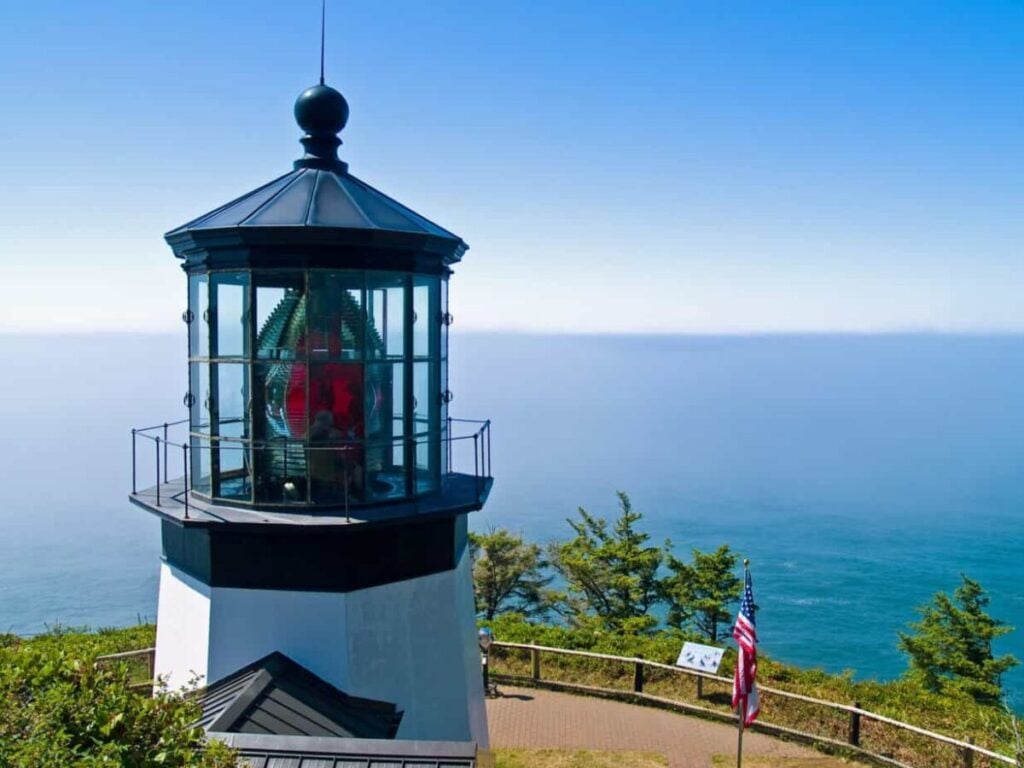
Cape Meares Lighthouse
Year lit: 1890
Height: 38 feet
Oregon's shortest lighthouse honors Captain John Meares, the first person to sail into Tillamook Bay. Although decommissioned in 1963, the beacon still houses a Fresnel lens made in Paris. The light is a five-wick oil lamp with a reflector turned by a 200-pound lead weight, similar to the system used in a grandfather clock.
Cape Meares Lighthouse is 10 miles west of Tillamook in Cape Meares State Scenic Viewpoint . While visiting the park, you can also see the Octopus Tree, a large, contorted Sitka spruce. The park is open daily from 7 am to dusk, but the lighthouse is only available from May through September.
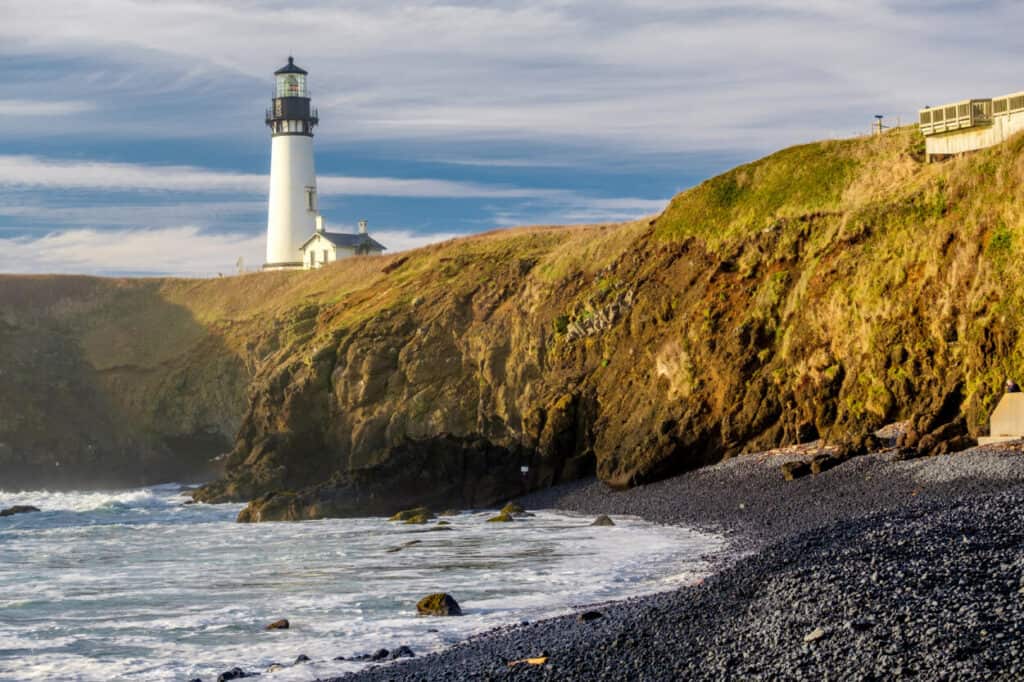
Yaquina Head Lighthouse
Year lit: 1873
Height: 93 feet
Continue south to MilePost 137.6 on Highway 101 on the Central Oregon Coast, where you will discover Oregon's tallest lighthouse. Yaquina Head Lighthouse, dominating the horizon, contains more than 370,000 bricks. Initially solid white, it did not rotate and burned lard oil to illuminate its 4-wick lamp.
While tours are available depending on weather, conditions, and staffing, the grounds and interpretive center are open year-round. The tour is usually 45 minutes long and involves a strenuous 114-step climb to the top. Visit the Yaquina Head Outstanding Natural Area for current information about tours.
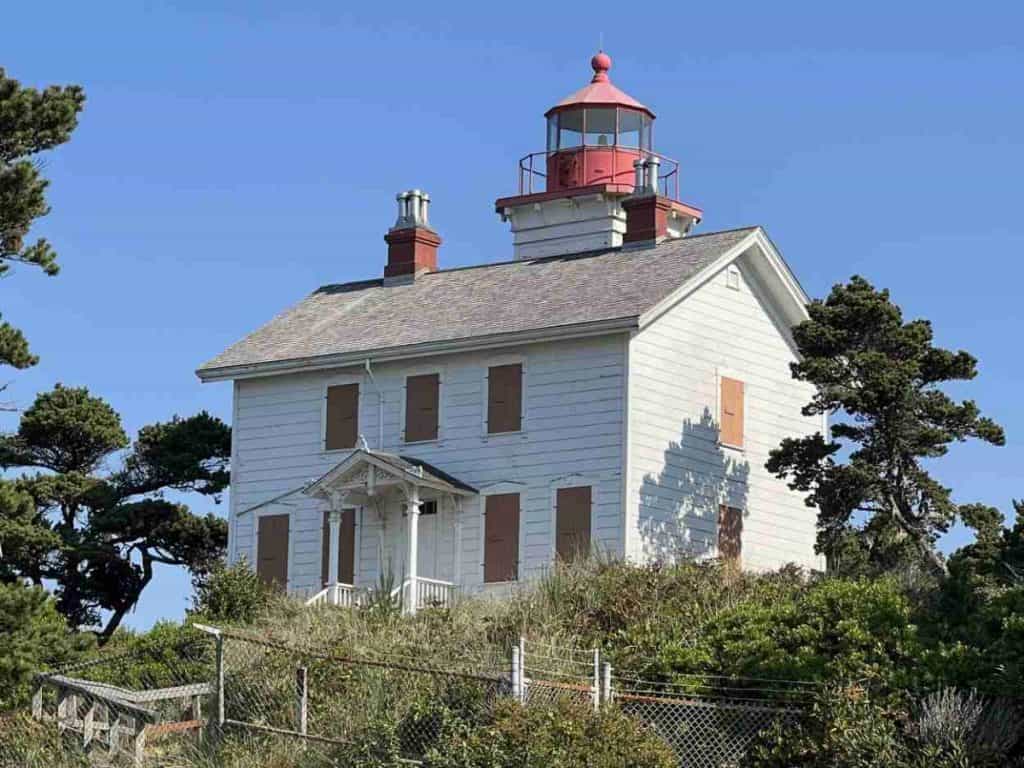
Yaquina Bay Lighthouse
Year lit: 1871
Height: 39.6 feet
Yaquina Bay Lighthouse sits a few miles south on the Oregon Coast Highway at MilePost 141.9. It is the only surviving state lighthouse with the light and living quarters in the same building and the state's only intact wooden beacon.
Yaquina Bay Lighthouse was re-lit in 1996 with a modern optic shining a steady white light from sunset to sunrise. Self-guided tours are free. In summer, the lighthouse is open daily from noon to 4 pm. Winter hours are noon to 4 pm, Wednesday through Sunday.
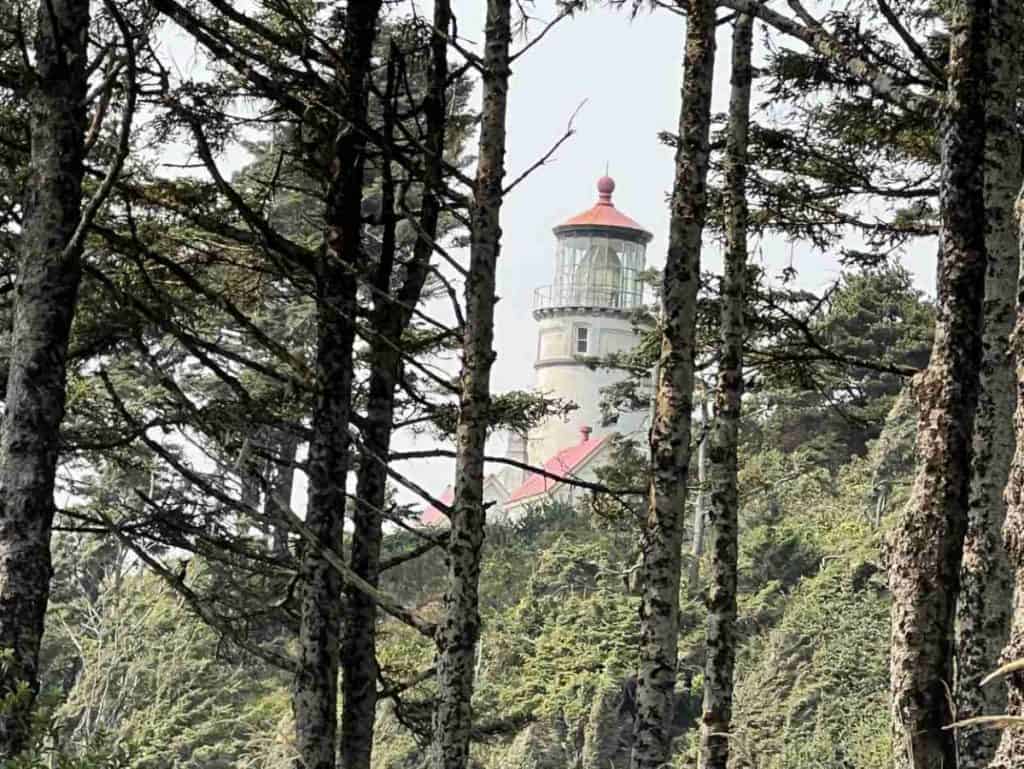
Heceta Head Lighthouse
Year lit: 1894
Height: 56 feet
Continuing south on Highway 101 to the Southern Oregon Coast, you will encounter Heceta Head Lighthouse at MilePost 178.3 in north Florence . A day-use parking permit is required, but Heceta Head Lighthouse State Scenic Viewpoint offers much more than a tower, including the picturesque Cape Creek Bridge, a sandy beach with tide pools and caves, and hiking trails.
While France makes most Fresnel lenses, historians believe Heceta Head's lens is the only one on the West Coast made in England. Its signal flashes white every ten seconds.
Heceta Head Lighthouse is open year-round, weather and staff permitting. Regular hours for self-guided tours of the outside and the ground floor are 11 am to 3 pm in summer and 11 am to 2 pm in winter. If you are a lighthouse enthusiast, consider staying in the assistant lightkeeper's house, now a bed and breakfast.
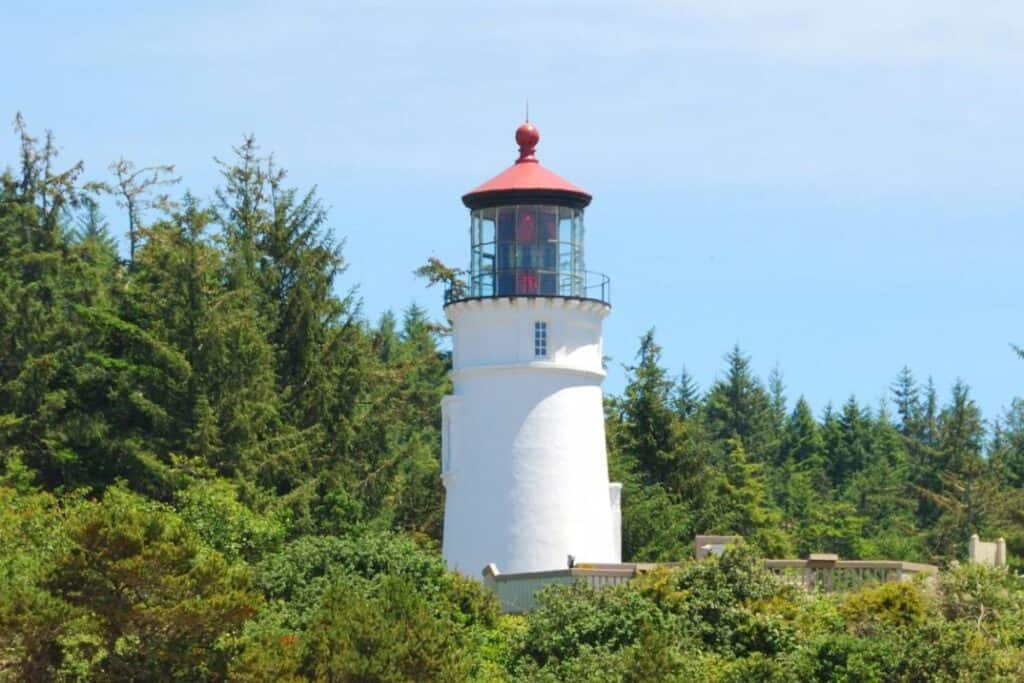
Umpqua River Lighthouse
Height: 65 feet
You may notice that the Umpqua River Lighthouse looks like the Heceta Head Lighthouse. Architecturally, it is nearly identical. However, the lens is quite different. It is the only Oregon Coast lighthouse emitting red and white light.
The signal is at MilePost 215.6 on the Oregon Coast Highway at Umpqua Lighthouse State Park in Winchester Bay. It is open daily except for major holidays. During the tour, you can learn how lensmakers turned the glass red.
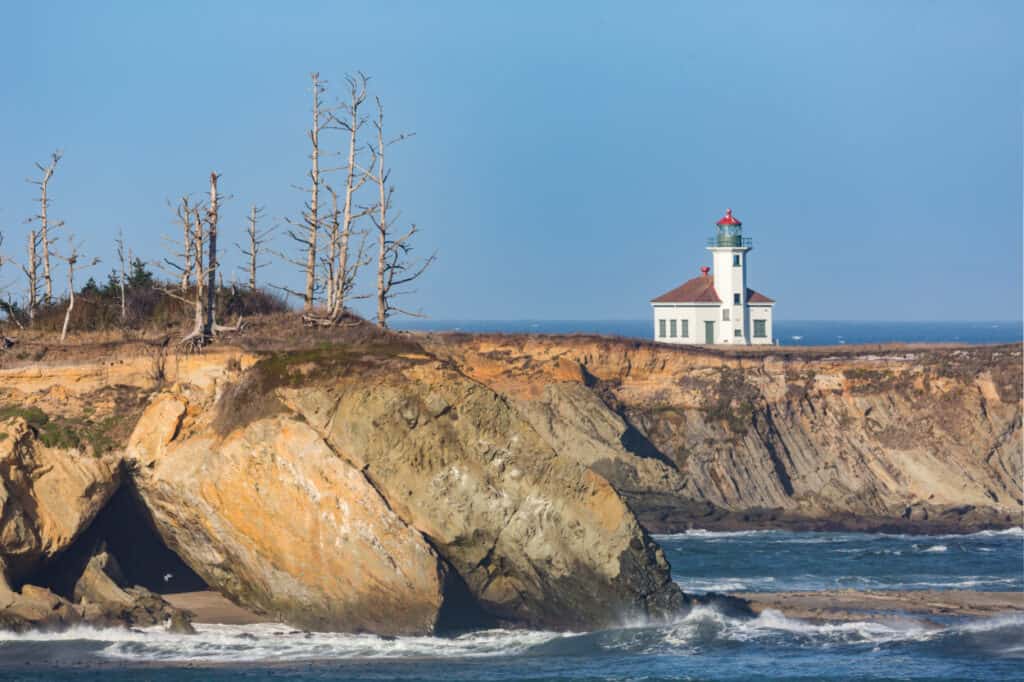
Cape Arago Lighthouse
Year lit: 1934
Height: 44 feet
Although not open to the public, you can view Cape Arago Lighthouse at MilePost 10.4 on Cape Arago Highway. In 1993, the Coast Guard removed the lens, which no longer operates.
Cape Arago is the third lighthouse built on the island. The first was constructed in 1866, and the second in 1909. Harsh weather conditions caused deterioration, necessitating replacement. The Confederated Tribes of the Coos, Lower Umpqua, and Siuslaw Indians took over the property and the beacon in 2013.

Coquille River Lighthouse
Year lit: 1896
Height: 40 feet
You will find Coquille River Lighthouse in Bullards Beach State Park near Bandon at MilePost 259.2 on Highway 101. Short and stout, the signal stands sturdily along the shore next to the Coquille River and the ocean.
Although no longer operable, it served as a command center and a refuge for people during the Bandon fire of 1936. The inside is not open, but you can enjoy the outside view anytime.
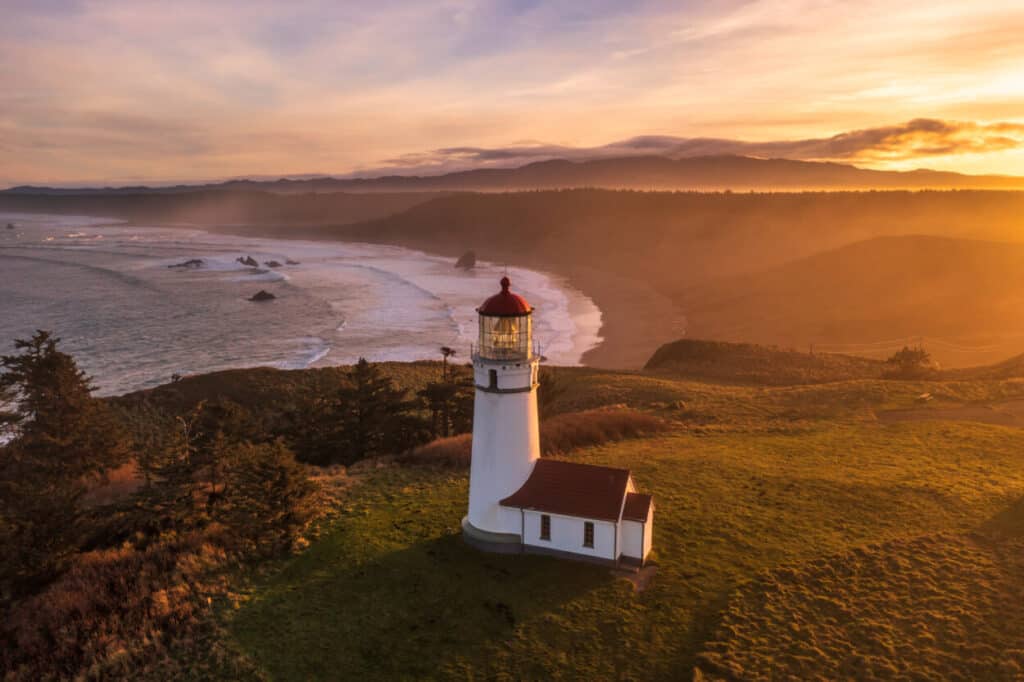
Cape Blanco Lighthouse
Year lit: 1870
Height: 59 feet
MilePost 296.6, near Port Orford, houses the oldest standing lighthouse on the Oregon Coast. The tower is not open and requires repair. However, you can tour the signal workroom. A separate building, formerly a garage, now houses the ticket office and a gift shop.
Daily guided tours of the workroom are available from April through October from 10 am to 3:30 pm. Note that tours are not offered on Tuesdays.
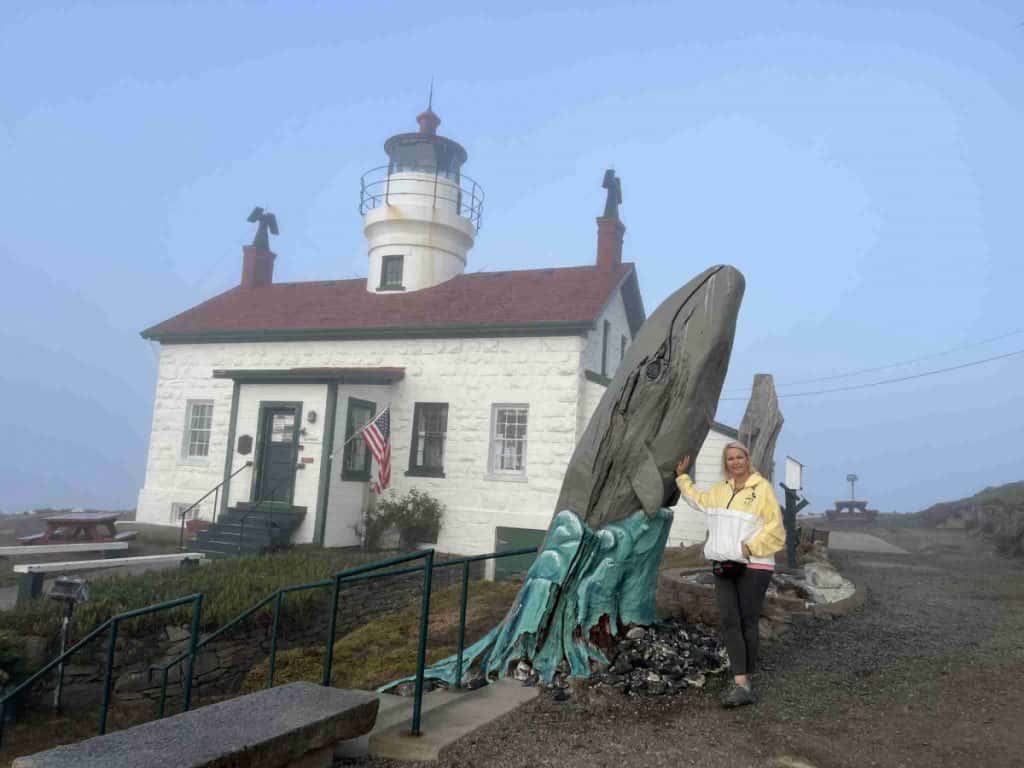
Bonus Lighthouse
Year lit: 1856
Height: 45 feet
A short drive south from Brookings, Oregon, to Crescent City, California, will yield fantastic gems. Battery Point Lighthouse is a somewhat unknown attraction along the edge of Redwood National and State Parks . Although an island at high tide, you can access the beacon during low tide.
A trip to Redwood National and State Parks is well worth your time. There, you can see the world's tallest trees and the largest elk in North America.

Oregon Lighthouses
A scenic drive along the stunning Oregon Coast yields many adventures and points of interest. Lighthouses, one of the coast's main attractions, are unsung heroes that have safely directed mariners ashore for years. Honor the glorious towers as part of your road trip. They just might clear your brain fog.
Featured image credit: Miles with McConkey
More for You
20 of the world's richest people who you might not know are LGBTQ+
Beijing Warns US After Missile Launcher Reaches 'China's Doorstep'
16 Compliments You Didn’t Realize Are Actually Pretty Insulting
13 Things You Should Never Pressure Wash
Space Rock Slammed Into Moon - The Explosion Was Seen From Japan
Popular Beer Company Files for Chapter 11 Bankruptcy
James Bond Trailer Featuring Henry Cavill Receives 2.3M Views Despite Being an AI Fake | THR News Video
I’m a Real Estate Agent: Here Are the 4 Florida Cities Where You Should Avoid Buying a Home
NFL Draft News: Jayden Daniels' Representation Reportedly Upset After Commanders Meeting
Arkansas senators say Clinton airport exec. killed by ATF with no bodycam: 'Violation of its own policy'
15 Succinct Jokes That Really Make You Think
5 Things You Need To Stop Doing If Your Car Has An Automatic Transmission
A millennial who made $170,000 secretly working two remote jobs says it helped him pay off about $50,000 in student loans
18 Life Rules Jesus Gave Us to Live By
‘It can happen again’: Judge set to preside over Trump trial delivers her toughest Jan. 6 sentence to date
15 Things That Are Now So Expensive They're No Longer Worth It
IRS Announces Refund Increase to Taxpayers
The 25 Most Dangerous Cities to Drive In
How to 'quiet quit,' from a former teacher who did it for 2 years so she could enjoy a better life while still getting a paycheck
19 Celebrity Beauty Brands That Actually Live Up to the Hype

11 Oregon Lighthouses & The Adventures Nearby
Sharing is caring!
I think we can all agree the coast is stunning but something that sticks out, aside from the sea stacks, are Oregon’s lighthouses.
These historic and beautiful lighthouses are sprinkled along the coast and are surrounded by adventures! After all, seeing a lighthouse is pretty cool but there’s got to be more to it right?
Don’t worry! We got you. Here are the 11 Oregon Lighthouses and all the best adventures you can do around each of them!
Table of Contents
1. Tillamook Rock Lighthouse
2. cape meares lighthouse, 3. yaquina head lighthouse, 4. yaquina bay lighthouse, 5. cleft of the rock lighthouse, 6. heceta head lighthouse, 7. umpqua river lighthouse, 8. cape arago lighthouse, 9. coquille river lighthouse, 10. cape blanco lighthouse, 11. pelican bay lighthouse, visiting bullards beach state park near bandon, oregon, exploring cape meares state scenic viewpoint, oregon’s lighthouses.
Here’s a map to help you plan your trip. We’ve marked the lighthouses as well as the nearby adventures. Everything below is ordered from north to south.
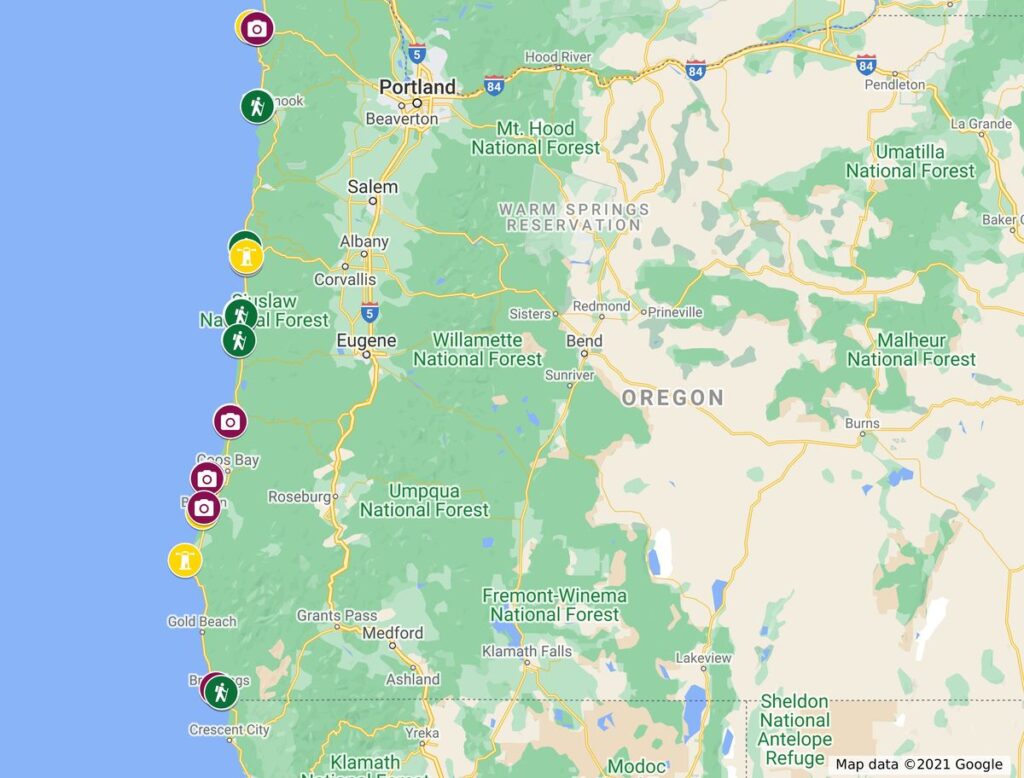
Don’t Forget This!
A lot of the best adventures around Oregon will require a Northwest Pass. You can easily get one delivered straight to your door. Grab it now before you leave !

Located more than a mile off the North Coast of Oregon is ‘Terrible Tilly’, or Tillamook Rock Lighthouse. It stands on a sea stack of basalt and is well-known throughout Oregon.
It is closed to the public, and while you can’t visit it, it’s still a formidable sight off of the coast of Tillamook Head. The rock was selected to be the light’s location in 1878, yet building it proved to be a challenge thanks to the constant battering of the waves and storms.
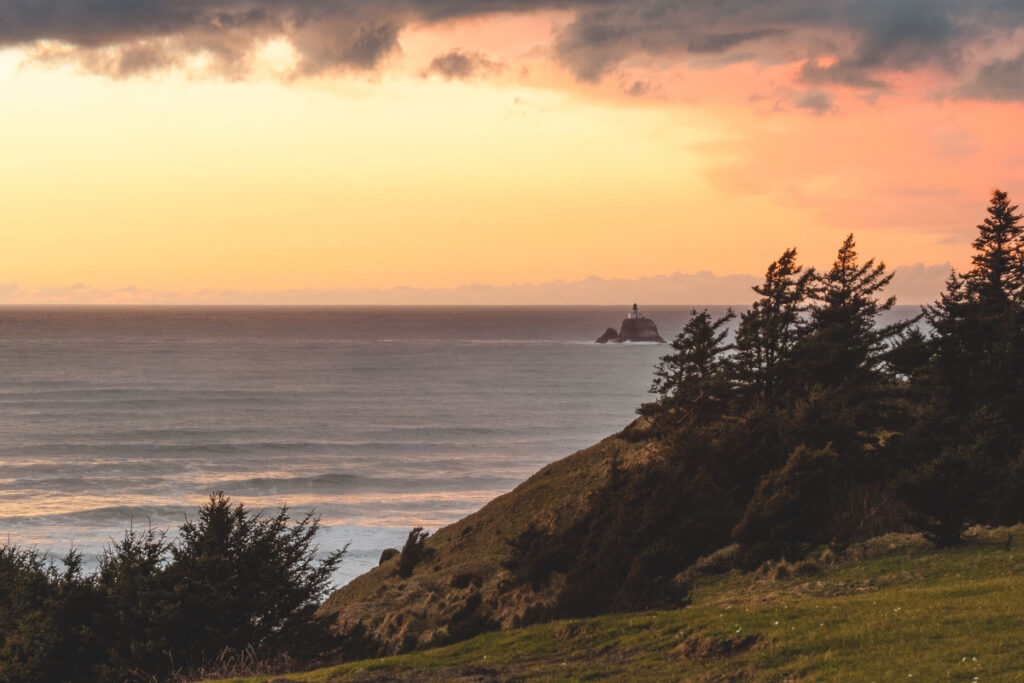
According to historical records, a huge storm swept away all of the worker’s provisions and they were stranded for two weeks on the rock. The construction took over 500 days, and it was lit for the first time in 1881.
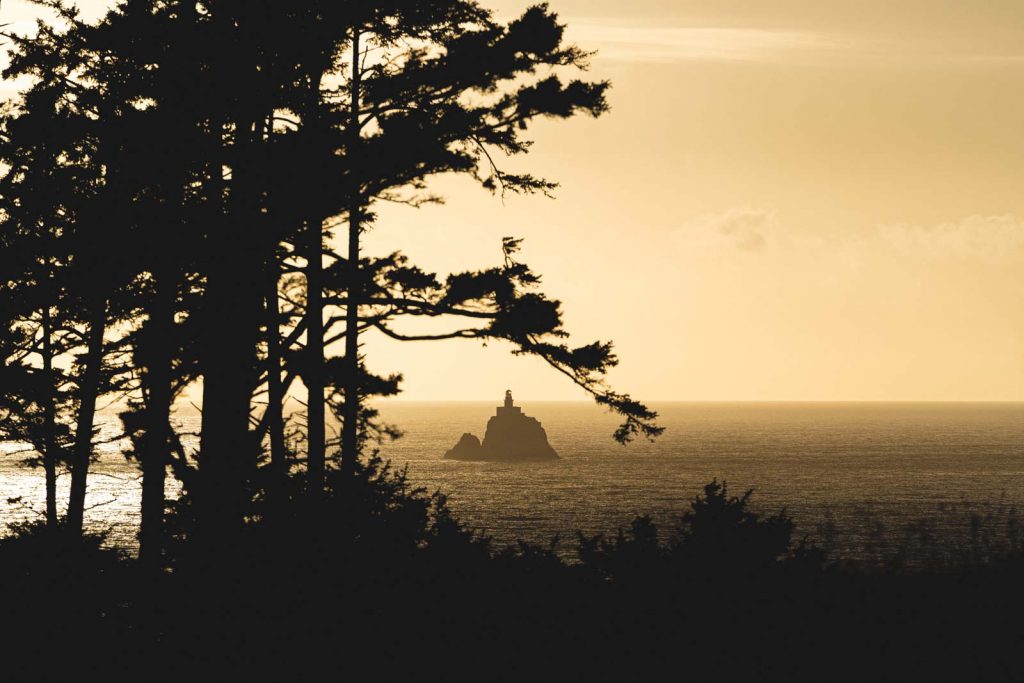
Lightkeepers were only assigned to work for 42 days at a time simply because the conditions were so hard. After the lantern room and Fresnel lens being wrecked by a storm in 1934, it was never replaced.
RELATED: 11 Most Scenic Oregon Coast Towns (And What to do There!)
Adventures Near Tillamook Rock Lighthouse in Oregon
Ecola State Park – The state park winds its way around Tillamook Head and is bursting with the potential for adventure. It stretches along 9 miles of coastline, with hiking being its main draw.
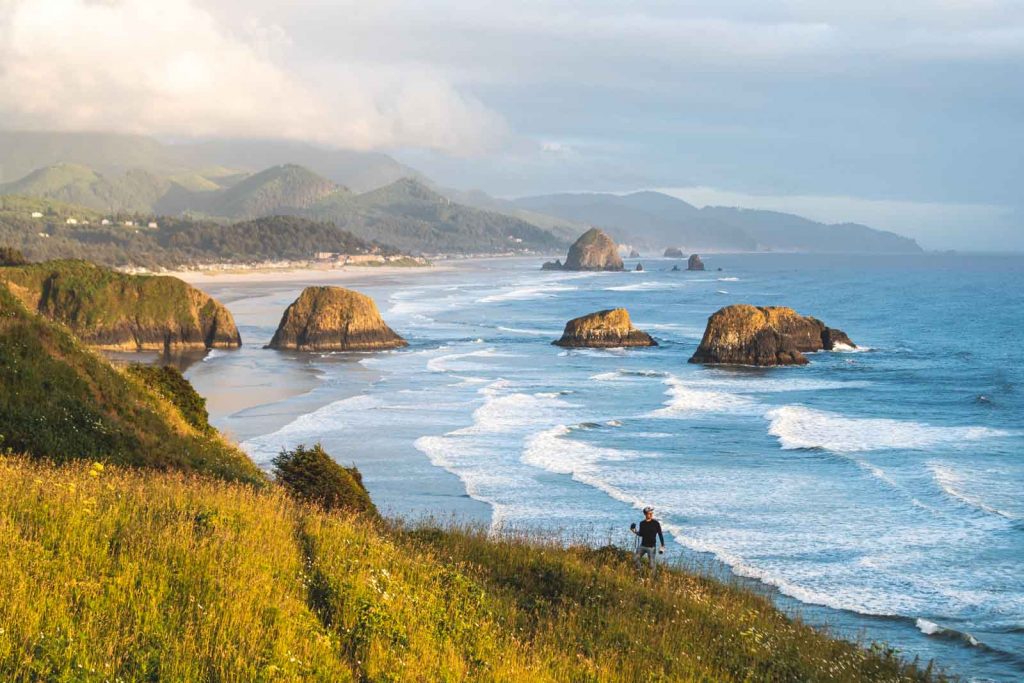
The Clatsop Loop Trail is a notable trail that begins at the Indian Beach parking area which takes you past breathtaking views of the coastline. For some of the best views of the lighthouse, take the short spur from OCT Hikers’ Camp.
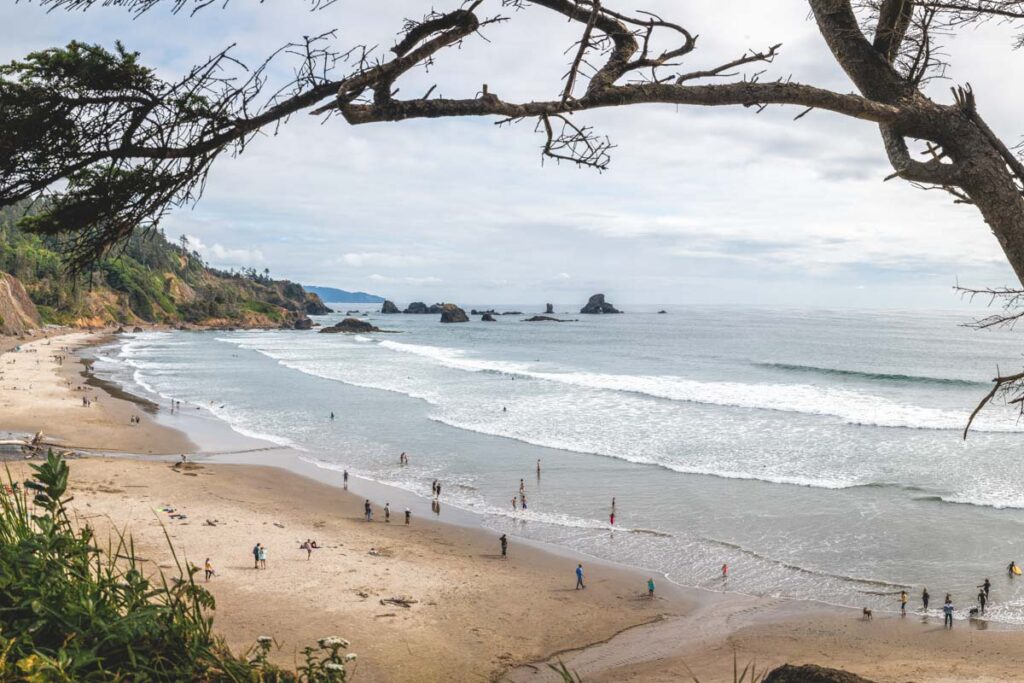
Surfing – A short drive or walk from Tillamook Head you’ll find Indian Beach, a hotspot for surfers who are eager to hit the waves. Both kayakers and surfers hit this spot, with summer being the best time of year for surfing . Bring your board and hit the waves and see what this part of the Oregon coast has to offer.
Tucked away amidst the scenic landscape of Cape Meares State Scenic Viewpoint is the beautiful Cape Meares Lighthouse. One of the most interesting features of this Oregon lighthouse is that it is the shortest lighthouse on the Oregon Coast, standing at only 38 feet tall.
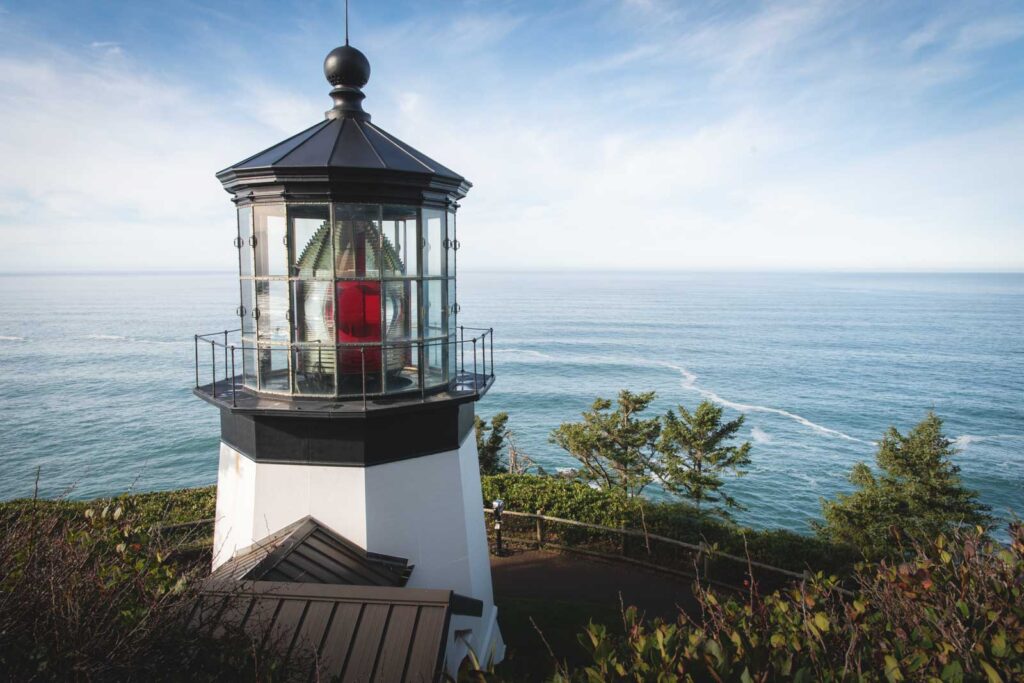
It was named for Captain John Meares, the first to sail into Tillamook Bay, and was built in 1890. Don’t let its short stature fool you – it stands on a steep cliff, and when working, its bright light could be seen for 21 miles out to sea.
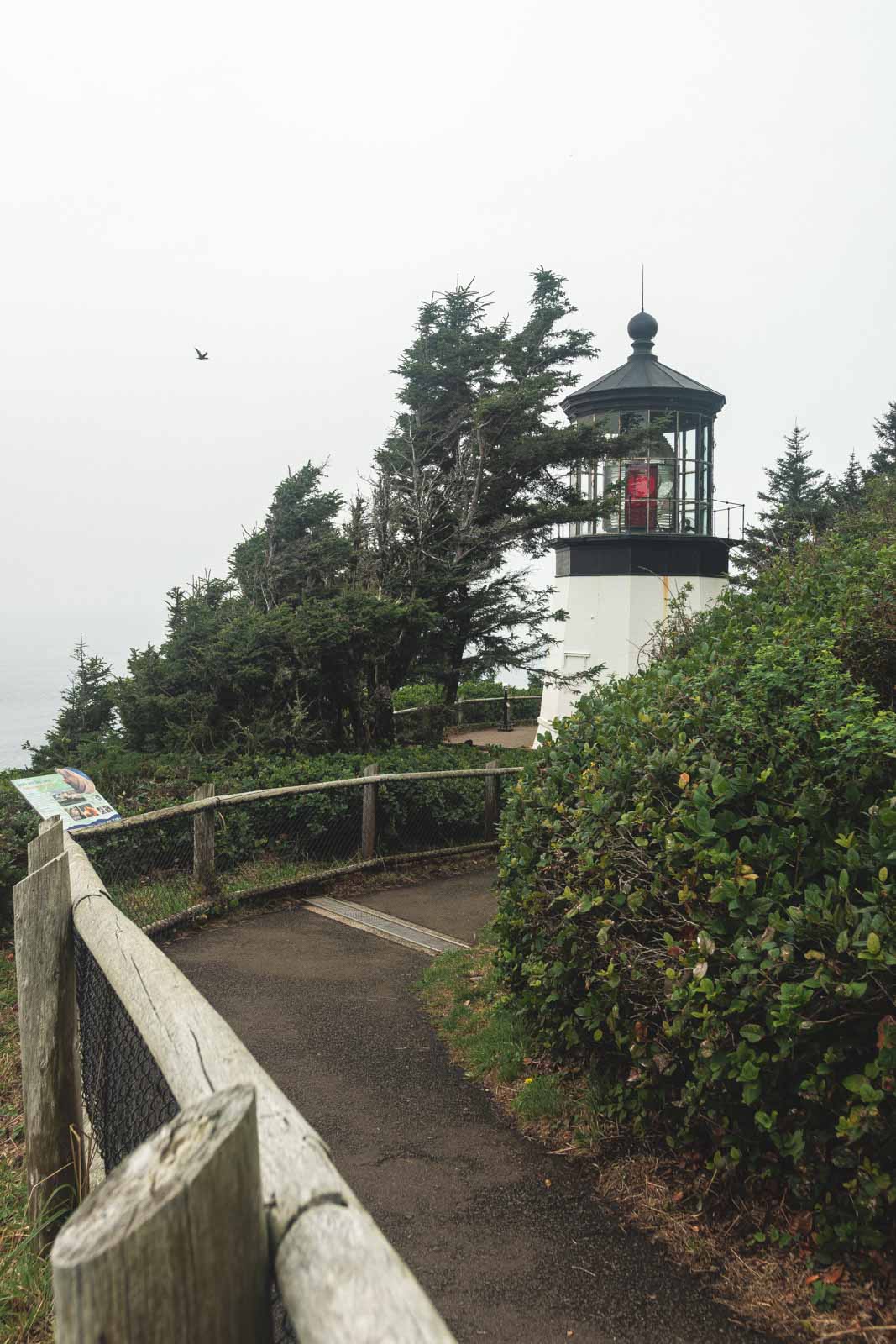
The tower is the only one like it on the coast, made out of sheet iron which is lined with bricks. The lighthouse was deactivated in 1963 and replaced by a newer tower, before being listed on the National Register of Historic Places in 1993.
When visiting, although the staircase is pretty short, it is one of the only lighthouses where you can walk around the lens, enjoying the views that the keepers did over a century ago.
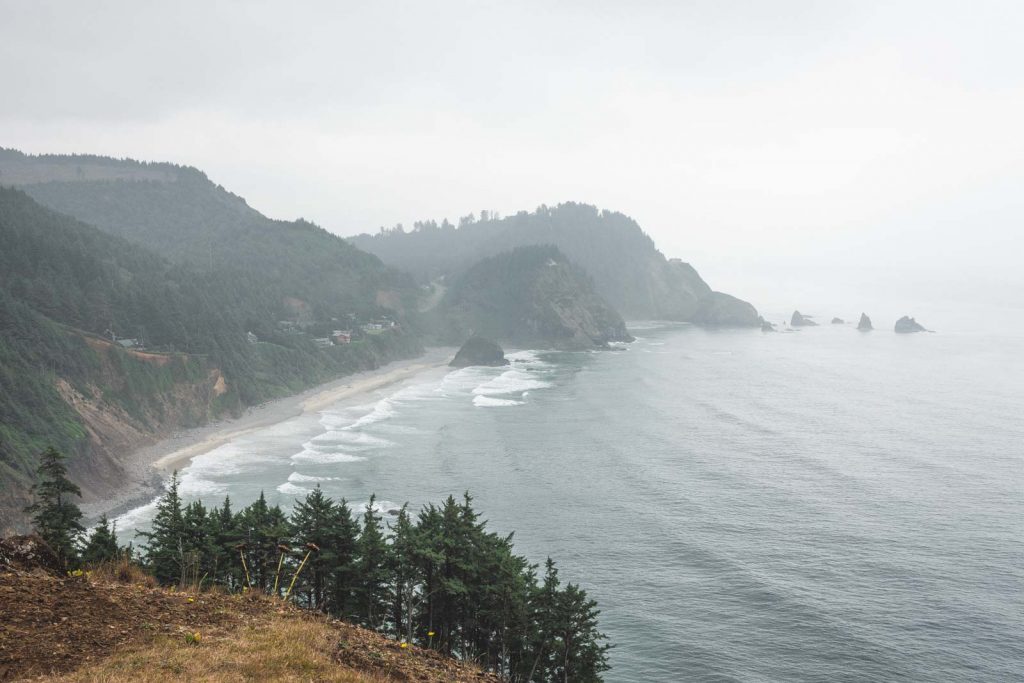
Tours: June to August open 11am to 6pm – May and September 11am to 4pm.
Adventures Near Cape Meares Lighthouse in Oregon
Wildlife Watching – Keep your eyes peeled when on the cliffs for a chance of spotting migrating gray whales. Birds are also abundant throughout the park, so keep your eyes peeled for scoters, western grebes, and common loons. One of the best places to see wildlife is from the wildlife viewing deck.
Cape Meares Lighthouse Loop – (0.5 miles, easy, loop) – The lighthouse loop is the only way to reach the lighthouse along a very well maintained trail, with a few areas to stop and look at the crashing waves below. Add on a few extra minutes to your stroll and see the Octopus Tree, it’s a unique Sitka Spruce with lots of “arms.”

Cape Meares Beach Trail – (1.4 miles, moderate, out and back) – This beautiful hike will take you to the beach, with a stunning view of the ocean on the way down. It is a steady decline on the way to the beach and then once you reach the end, you have the option of climbing down to the beach via a rope which isn’t for the faint of heart.
RELATED: Exploring Cape Meares State Scenic Viewpoint
As the tallest lighthouse in Oregon at 93 feet, Yaquina Head is pretty impressive. It is perched on headlands, surrounded by the Pacific Ocean on three sides, with incredible trails all around it.
Every day the lighthouse braves the wind that wildly whips around this scenic outcrop of land, and it has been standing and helping passing ships since 1873.
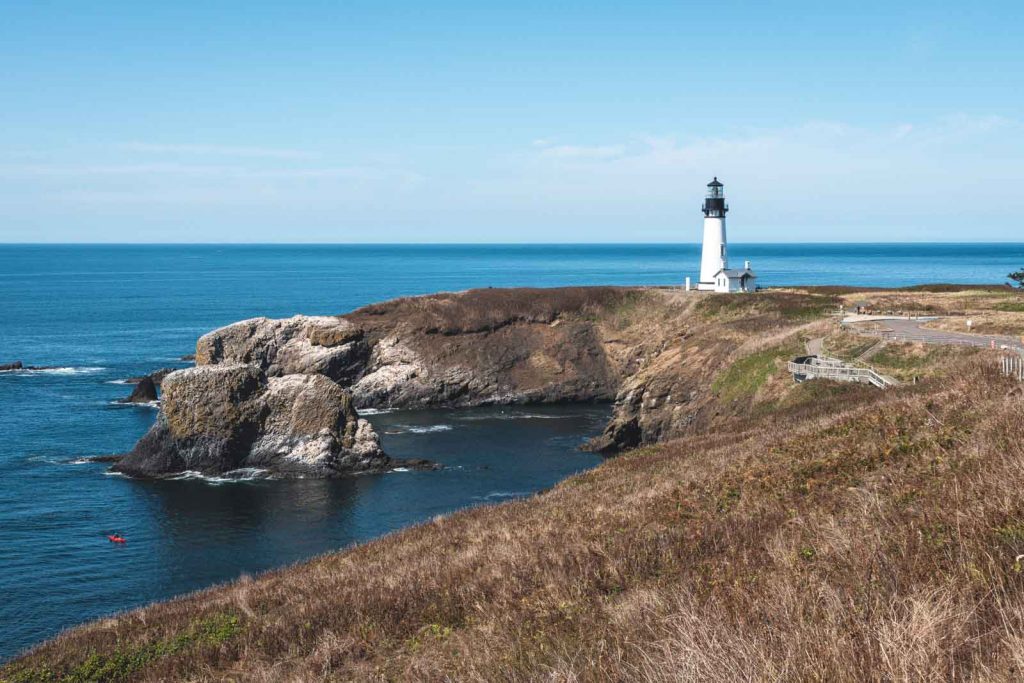
When visiting this lighthouse, the interpretive rangers will play the role of the lighthouse keeper, giving an interactive history of the lighthouse and taking you up to the top of the tower where you can stick your head in the lens room.
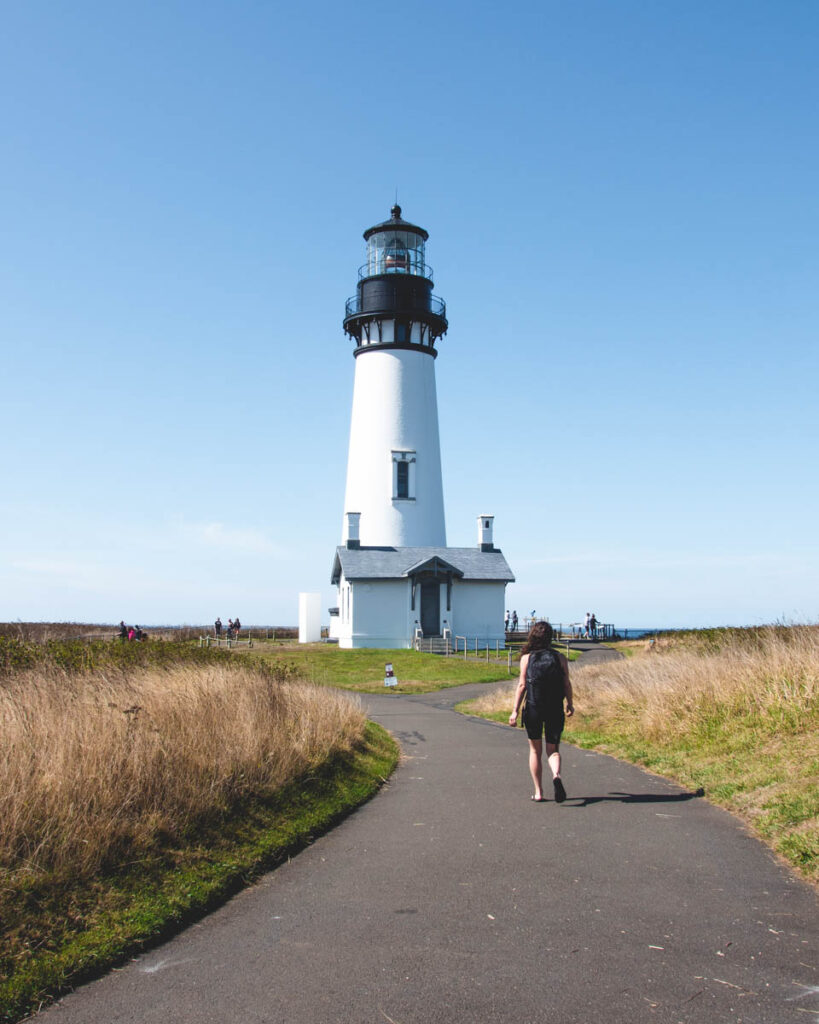
Tours : are offered by reservation only, and there are limited tickets per day.
RELATED: A Legendary Oregon Coast Road Trip – 35 Stops & 3 Itineraries
Adventures Near Yaquina Head Lighthouse in Oregon
If you love seabirds, then a stop at the lighthouse is unmissable. There are plenty of birds that call the area their home, but in the summer months, most people come to see the common murres who gather in numbers reaching more than 60,000!

Salal Hill Trail – (0.7 miles, easy, out and back) – This trail is an easy, short hike up Salal Hill. Once you reach the summit, you’ll be greeted with beautiful views of the beach on each side of you, as well as a great view of the lighthouse.
Yaquina Head Lighthouse and Cobble Beach Loop – (0.4 miles, easy, loop) – This is the best trail to take if you want to get up close to the lighthouse from the parking lot. It will also take you to a lovely beach with some tide pools.
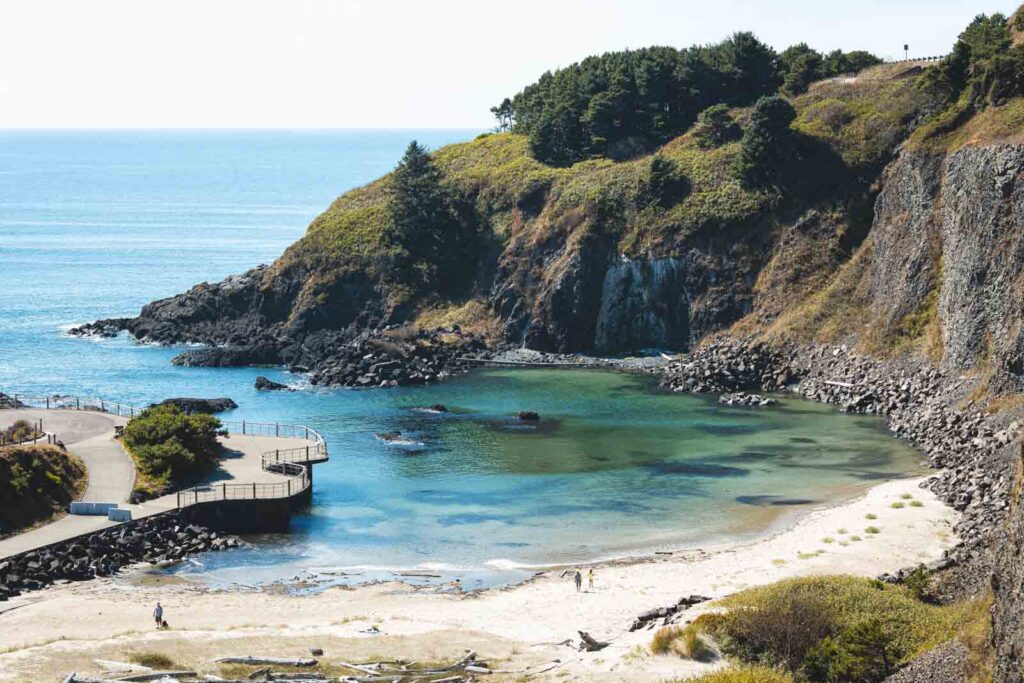
Lighthouse Trail to Quarry Cove – (0.7 mile, easy) – Want to find yourself in a stunning blue water cove? Head southeast from the lighthouse on the lighthouse trail to find yourself at this unique beach that most people miss. Alternatively, you can drive down as this cove has its own parking lot and is on the way out.
Built in 1871, Yaquina Bay Light was created not long after the founding of the city of Newport . This lighthouse was only active for three years as the larger Yaquina Head Lighthouse was then established. It was then used by the United States Army Corps of Engineers as their living quarters.
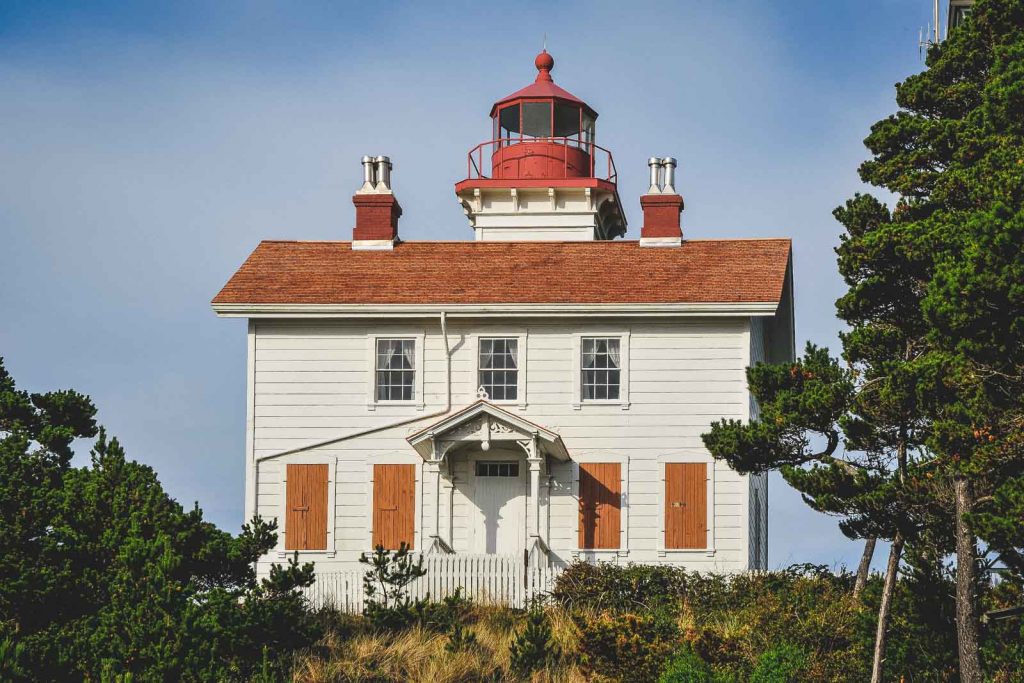
It was listed on the National Register for Historic Places in 1970 and, to this day, is the only existing Oregon lighthouse in which the living quarters are housed in the same building as the light. You can take a self-guided tour of this lighthouse, a stone’s throw away from the historic bayfront.
Tours: Between 12-4 pm, during the summer months, you can do a self-guided donation-based tour. (Wednesday through Sunday on the off months)
RELATED: 13 Adventurous Things To Do in Newport, Oregon
Adventures Near Yaquina Bay Lighthouse in Oregon
South Beach State Park – The stunning South Beach State Park offers plenty of recreational activities. The paved jetty offers a great place for a jog or a cycle, plus there is an equestrian trail for those that prefer to be on horseback. Kayak tours are offered on Beaver Creek, while other adventures include fishing, boating, surfing, and beachcombing.

South Beach State Park Trail – (4.3 miles, easy, out and back) – This trail is great for those up for a walk but is not used to hiking, as the terrain is mostly paved. It gives you a great overview of the park with stunning views most of the way.
Yaquina Bay State Park and Lighthouse – (0.4 miles, easy, loop) – You get a lot of view for such a short hike, taking you right up to the lighthouse. There are few spots where you can stop for a picnic or access the beach down a steep set of stairs.
The Cleft of the Rock Lighthouse is one of two Oregon lighthouses privately owned, which unfortunately means it is not open to the public.
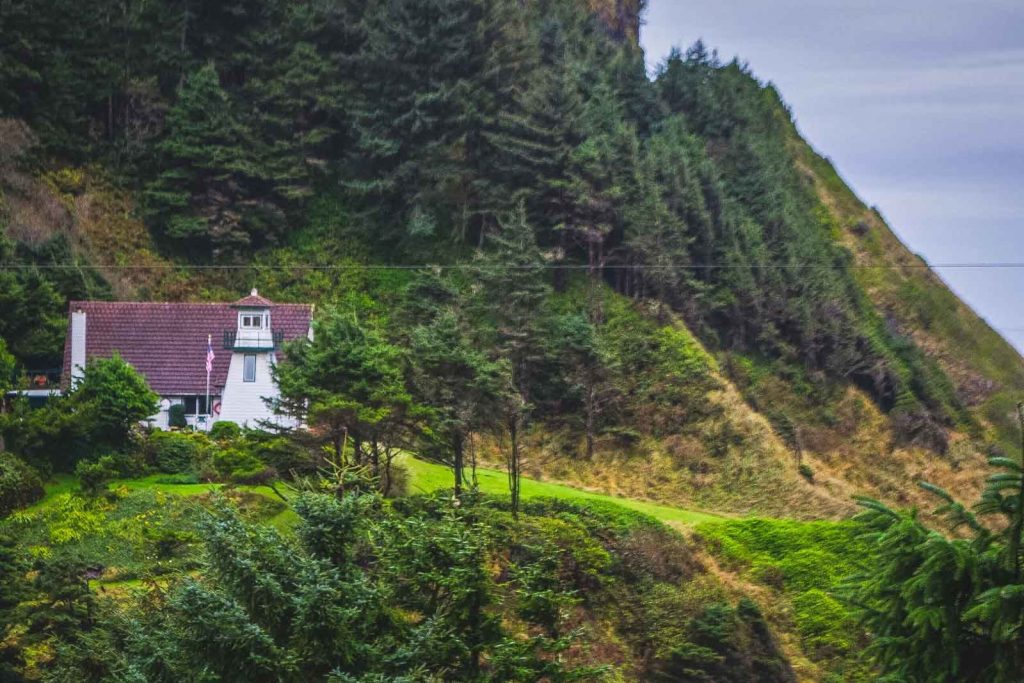
The lighthouse was built by Jim Gibbs, the former light owner, in 1976 and has been modeled after the Fiddle Reef Lighthouse, located on the southern shore of Vancouver Island. The lighthouse sits on the north base of Cape Perpetua and was named after a hymn.
Adventures Near Cleft of the Rock Lighthouse in Oregon
Thor’s Well – Rugged, dangerous, and incredible, Thor’s Well is a circular hole in the cliff formed after a sea cave collapsed. The natural attraction is most impressive at high tide when the waves rush in under the hole and fills it up from the bottom, causing spray to burst up through the hole.
The waves receding is almost as impressive, as it seems as though the water is draining away down a bottomless pit.
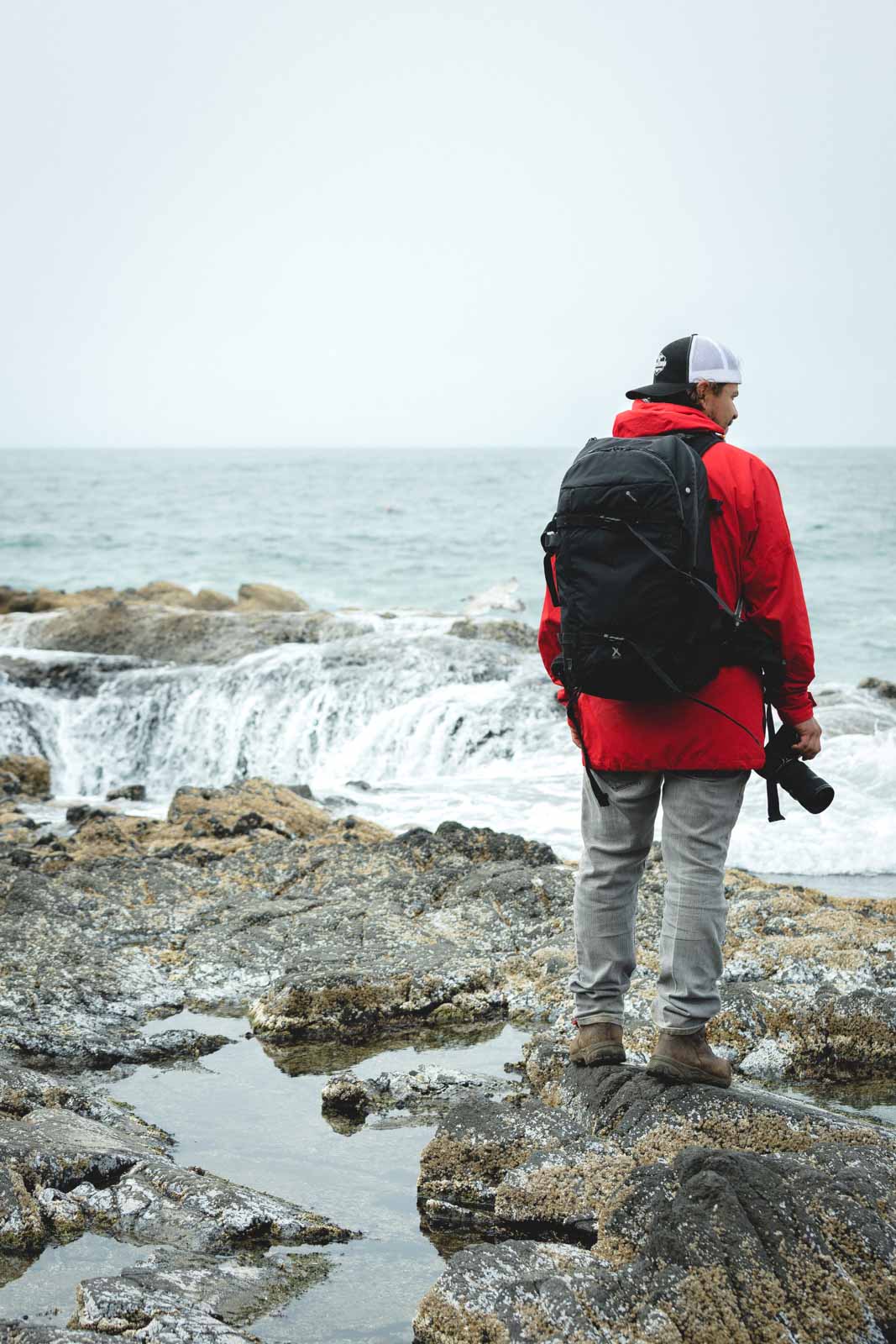
Spouting Horn – Similar to Thor’s Well but maybe not as well known is the Spouting Horn, a hole in the cove where seawater gets funneled during high tide.
Cape Perpetua – The cape is a must-stop on the Oregon coast, known for its unique rainforest-like landscape that collides with the ocean. There are plenty of stunning trails in the area that are just waiting to be explored.
Saint Perpetua Trail – (1.7 miles, moderate, out and back) – This stunning hike will take you through dense spruce woods with carpets of beautiful wildflowers to a viewpoint where you will be treated to 150 miles of panoramic scenic Oregon coast.
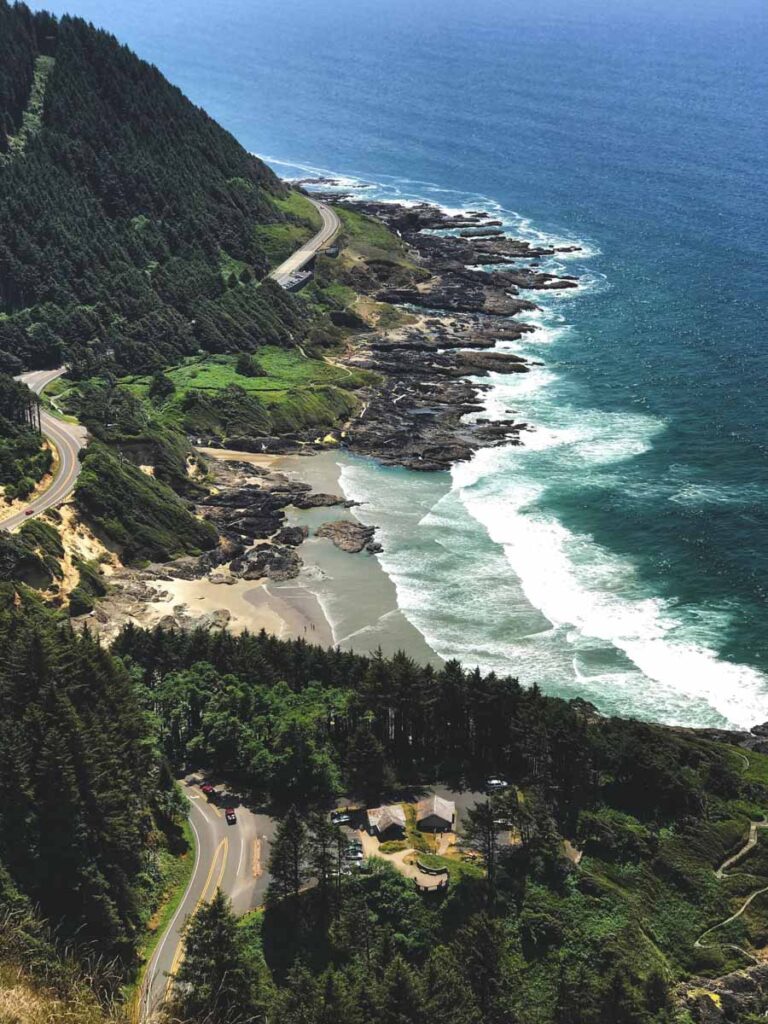
RELATED: 17 Breathtaking Oregon Coast Hikes
Cook’s Ridge and Gwynn Creek Loop Trail – (6.4 miles, moderate, loop) – This trail lets you fully explore what Cape Perpetua has to offer. You’ll be able to take in the inland rainforest as well as the coastal area, with plenty of interpretive signs along the way to tell you a little more about what you are passing.
Cape Cove Trail – (1 mile, easy, out and back) – The hike is nice and easy while also letting you take in views of the ocean and enjoy the fun tidal pools. The hike directly connects to the Captain Cook Trail and the Restless Waters Trail if you are looking to extend your hike.
Perched on top of Heceta Head is the iconic Heceta Head Lighthouse, one of the most photogenic Oregon lighthouses on the coast. The tower itself is 56-feet in height and can be seen for 21 miles out to sea.
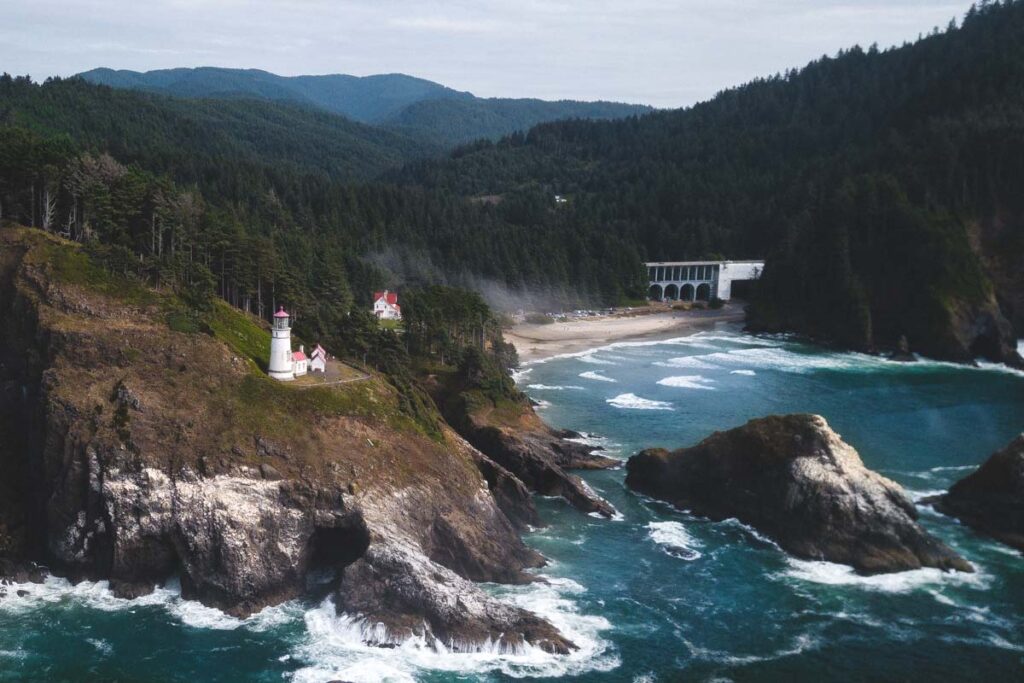
As well as being the most photographed, it also has the strongest light on the Oregon coast. The light was first lit in 1894 and is now maintained by the Oregon Parks and Recreation Department, and the lighthouse keepers’ house now operates as a cute little B&B.
The sight of this land bluff jutting dramatically from the land topped with the lighthouse can best be admired from U.S. 101, as from here you can take in the whole scene, as well as the sound of the sea lions below you.
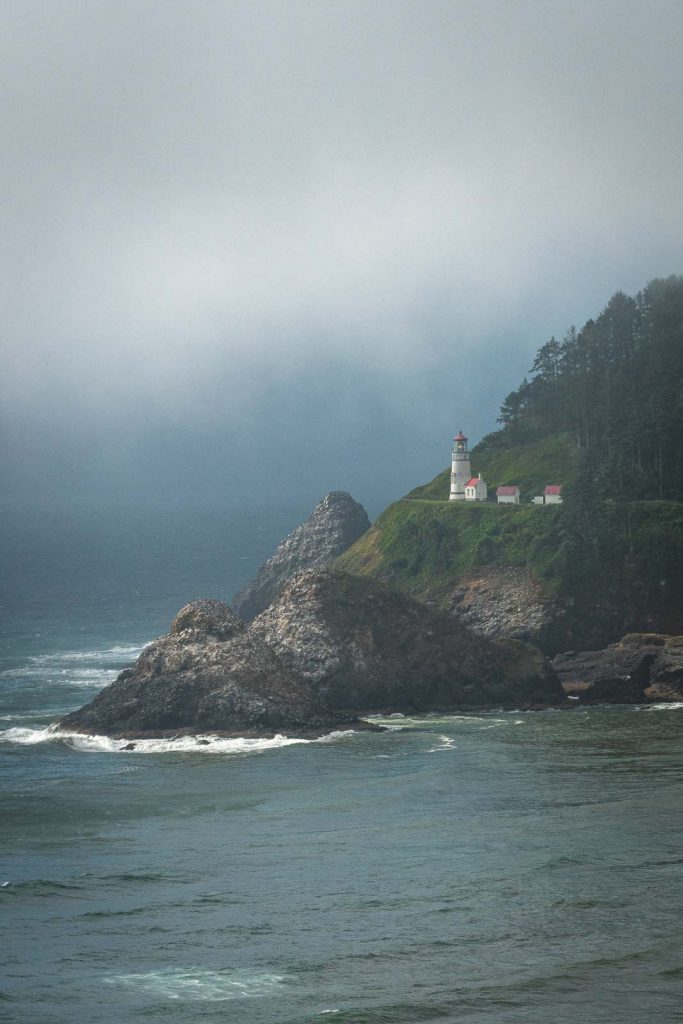
Tours: 11 am to 3 pm in the summer, and 11 am to 2 pm in the winter. On the tour, you will only be able to access the bottom half of the lighthouse.
Adventures Near Heceta Head Lighthouse in Oregon
Heceta Head Lighthouse to Hobbit Beach – (3.6 miles, moderate, out and back) – This is a beautiful hike with just the right amount of difficulty. Starting with an incline, you’ll head up a hill to be greeted with some stunning views. Give yourself a little longer than you think you will need for this one as chances are you will be stopping to take pictures every 10 minutes.
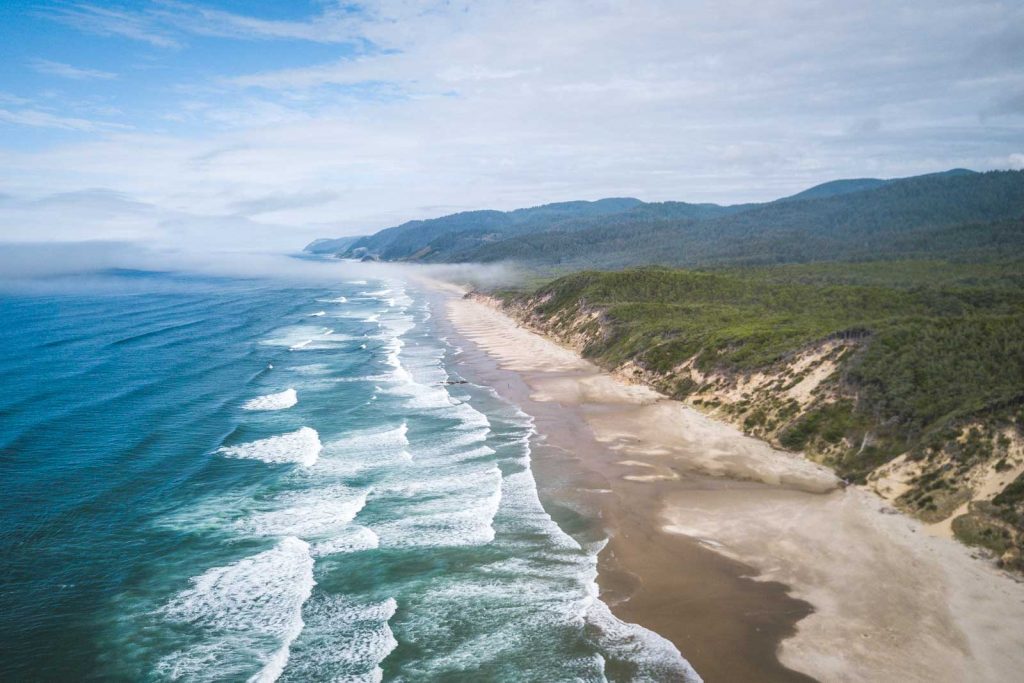
You’ll end up at the beach where you can sit, relax, and drink in the sounds of the waves (and maybe even run into a Hobbit! You’ll have to check it out to see what we mean)
The Umpqua River Lighthouse was the first lighthouse on the Oregon coast. To this day, you are still able to climb to the top of it while also learning more about the area’s history.
On the tour, you can climb the seemingly endless spiral staircase all the way to the top of the 65ft lighthouse. At every landing, there is a story about different stages in the lighthouse’s past.
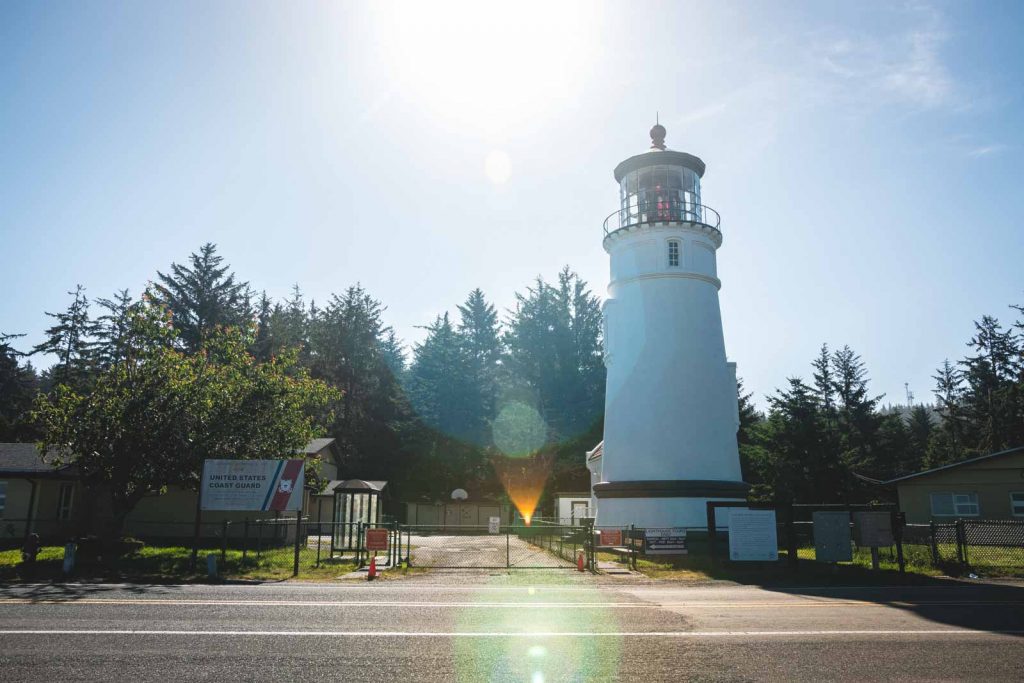
It is still operational and has only recently switched over from bulbs to LEDs to keep it lower maintenance. Once you reach the top, you are even able to take a look inside the working light.
The lighthouse a vibrant history, Before it was placed on the bluff on the entrance to Winchester Bay, it was commissioned along the beach of the Umpqua River in 1857. It was then moved less than 10 years later.
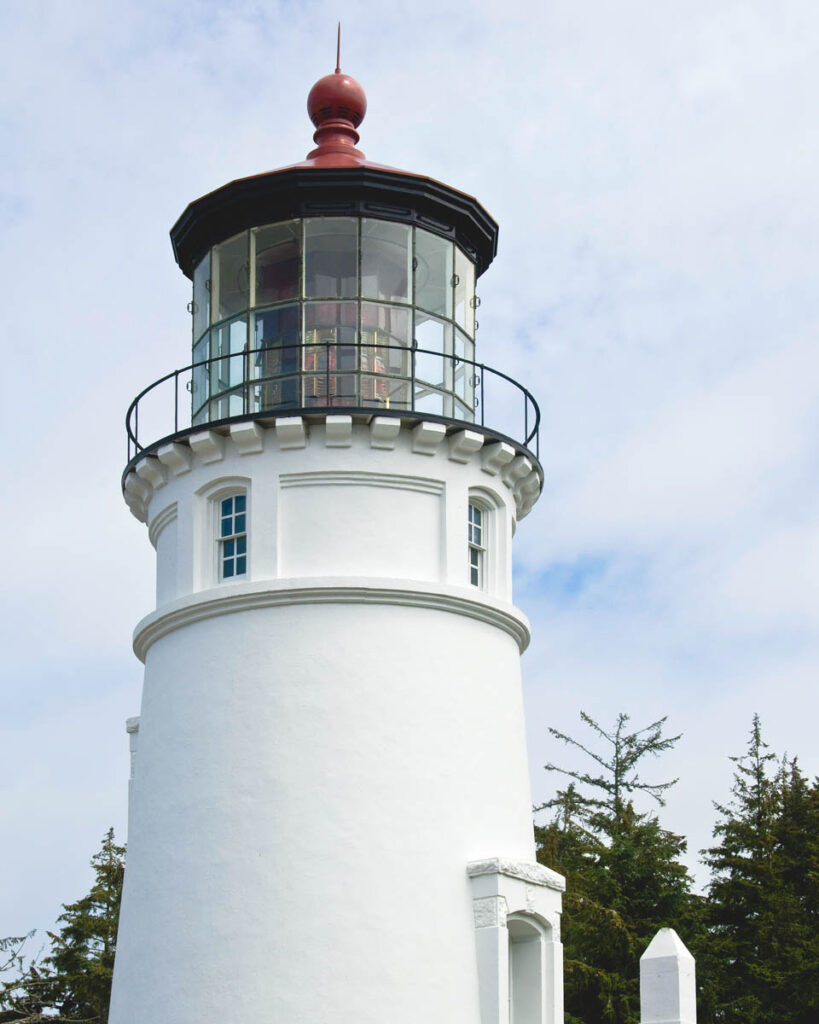
Tours: Available May to October by appointment only.
Adventures Near Umpqua River Lighthouse in Oregon
Oregon has miles of dunes along the coastline, many of which can be found near the Umpqua River Lighthouse. In fact, you can get some great views of the dunes from the top of this Oregon lighthouse.
Hikers will find plenty of areas to explore the dunes, and many trails have a view of the ocean. OHV enthusiasts will have a great time in the two large day-use areas where you can get your adrenaline rush heading out into the sand.
Lake Marie – Lake Marie provides the ultimate combo of adventure and leisure, making it great for an all-day outing. The lake is open for swimming and is the ideal place to cool down on hot summer days.
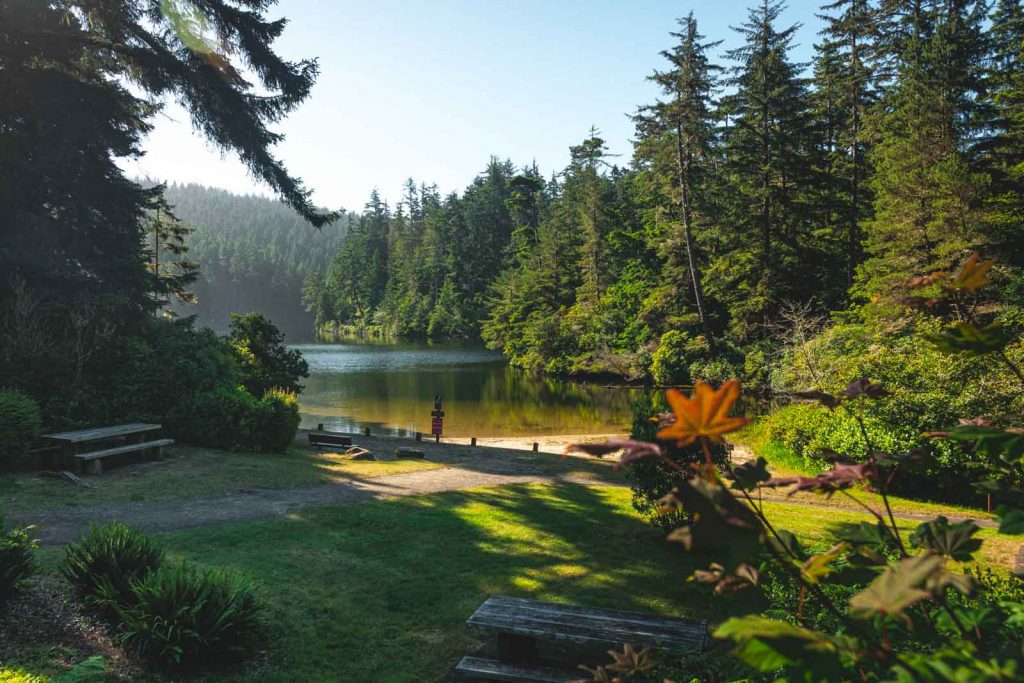
You can also go fishing, canoeing, and kayaking on the waters – the perfect way to get a different view of the coast. There’s also a mile trail that circles the lake.
Just west of Coos Bay is one of the most scenic Oregon lighthouses, Cape Arago . The most distinctive part of the lighthouse is its foghorn. It was first illuminated back in 1934 and stands 44 feet above sea level.
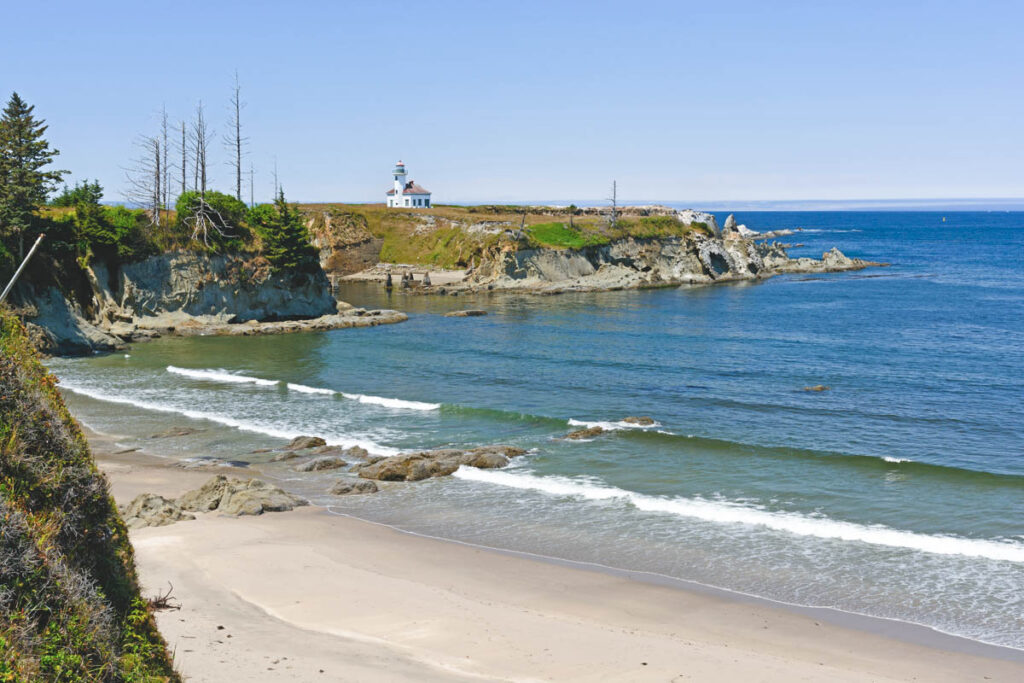
Unfortunately, you can’t get anywhere near the lighthouse as it is precariously located on Chief’s Island off Gregory Point. Still, there are some fantastic viewpoints of the light from the shore. One of the best views can be found at Shore Acres State Park , Yoakam Point.
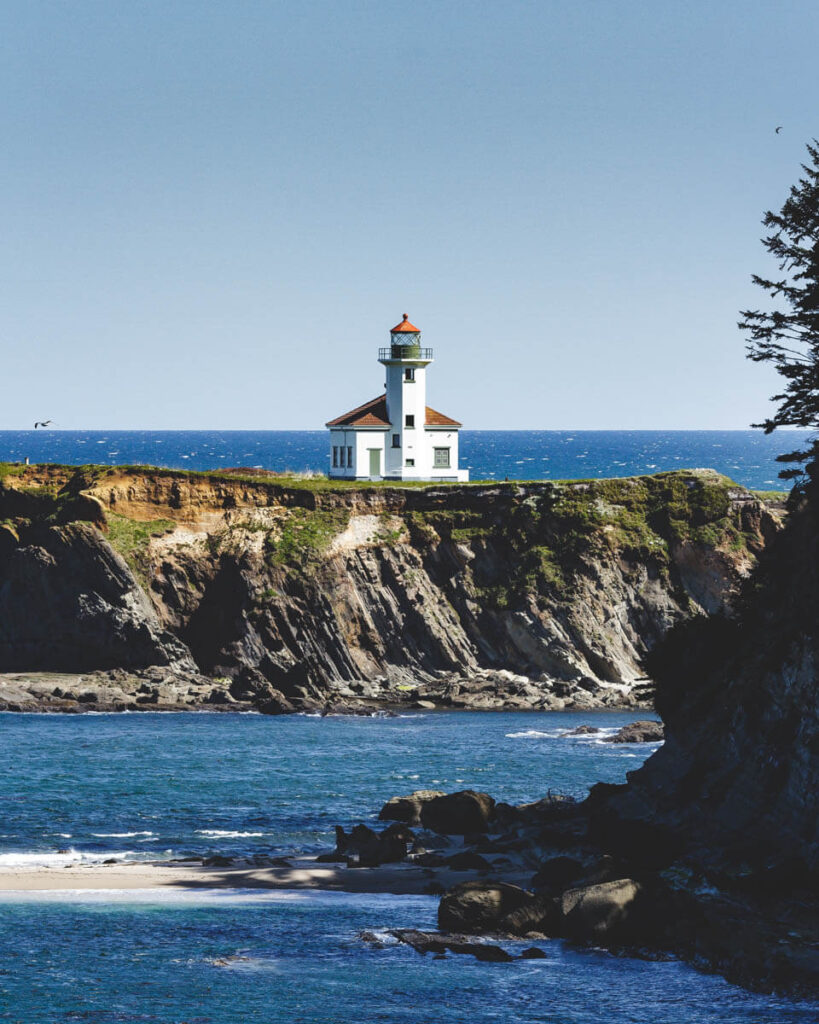
Adventures Near Cape Arago Lighthouse in Oregon
Sunset Bay State Park – Sunset Bay is a beautiful part of the Oregon coast and is connected to Shore Acres and Cape Arago State Park via a series of trails. The park features some stunning sandy beaches surrounded by towering cliffs.
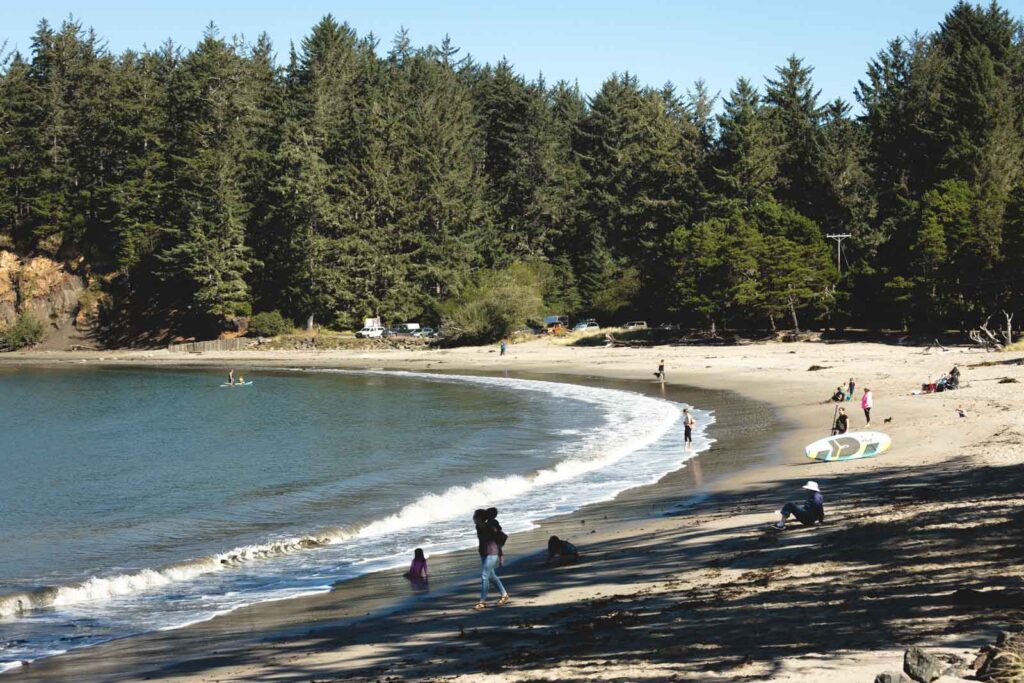
Fishing, swimming, boating, and beachcombing are also popular activities, and there is a camping ground at the park too.
RELATED: 25 Cool Oregon Coast Campgrounds to Stay at
Shore Acres State Park – Shore Acres can be found towering on the high sandstone cliffs above the rugged ocean. The state park is the perfect combination of natural and human-made features.
It contains the grand estate of timber baron Louis Simpson, with beautifully manicured gardens with plants from all over the world. Trails lead down to secluded Simpson Beach, or you could choose loftier views from the tails along the cliff edge.
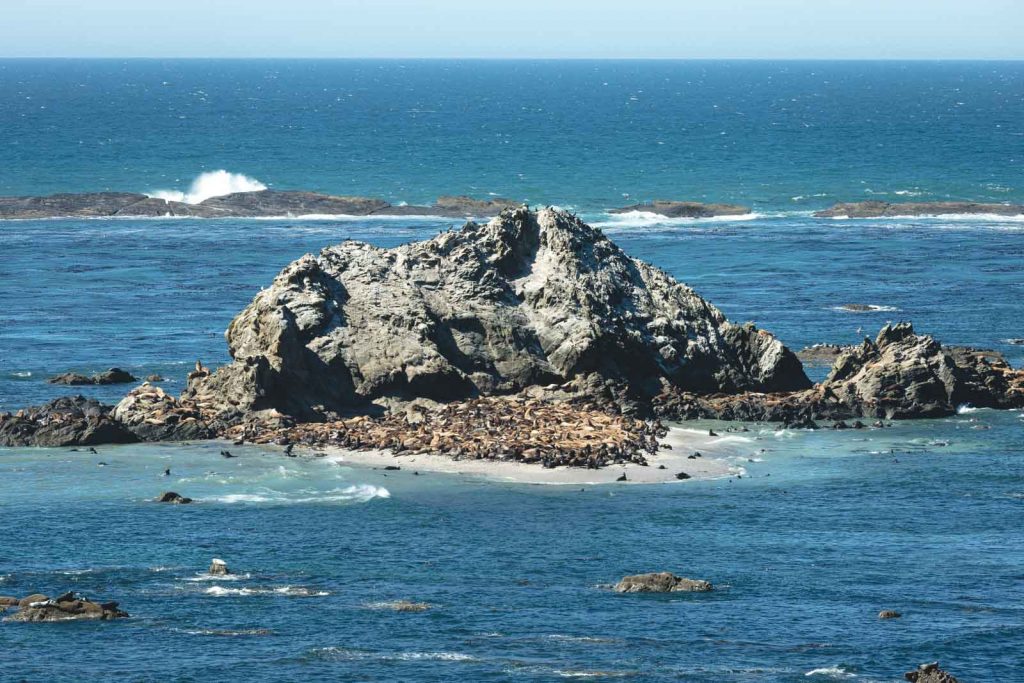
Trails – There are tons of trails, most of them quite short, all around the three state parks in the area. You could spend your whole day exploring this pocket!
Wildlife Spotting – Wildlife is teeming around the shores. You’ll see some dark rocks just off the coast, and if you listen closely, you’ll probably hear the chattering of seals gleefully sunbathing on their “five-star resort’ rocks!
RELATED: 19 Must-Visit Oregon Coast State Parks
First lit in 1895, Coquille River Lighthouse was built in Bullards Beach State Park to help mariners cross the dangerous bar located at the entrance to the Coquille River.
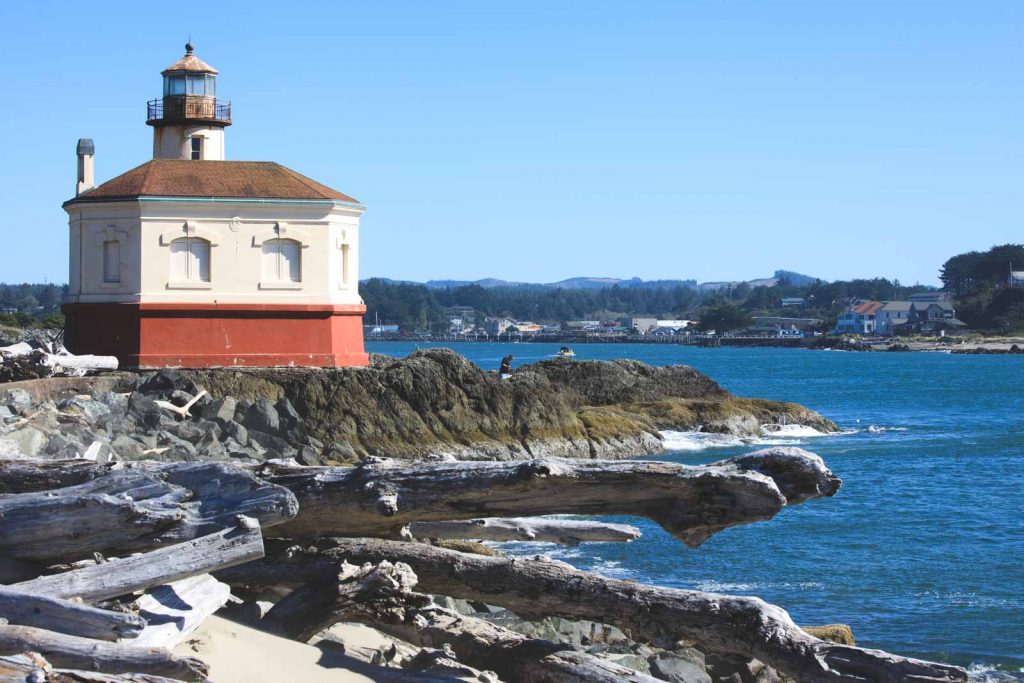
Mariners knew how to identify the light thanks to its signature 28 seconds of light followed by 2 seconds off. It was also equipped with a foghorn that it could use when needed.
It is a great place to explore, where plenty of wildlife can be found, with great views of the river and the surrounding beach.
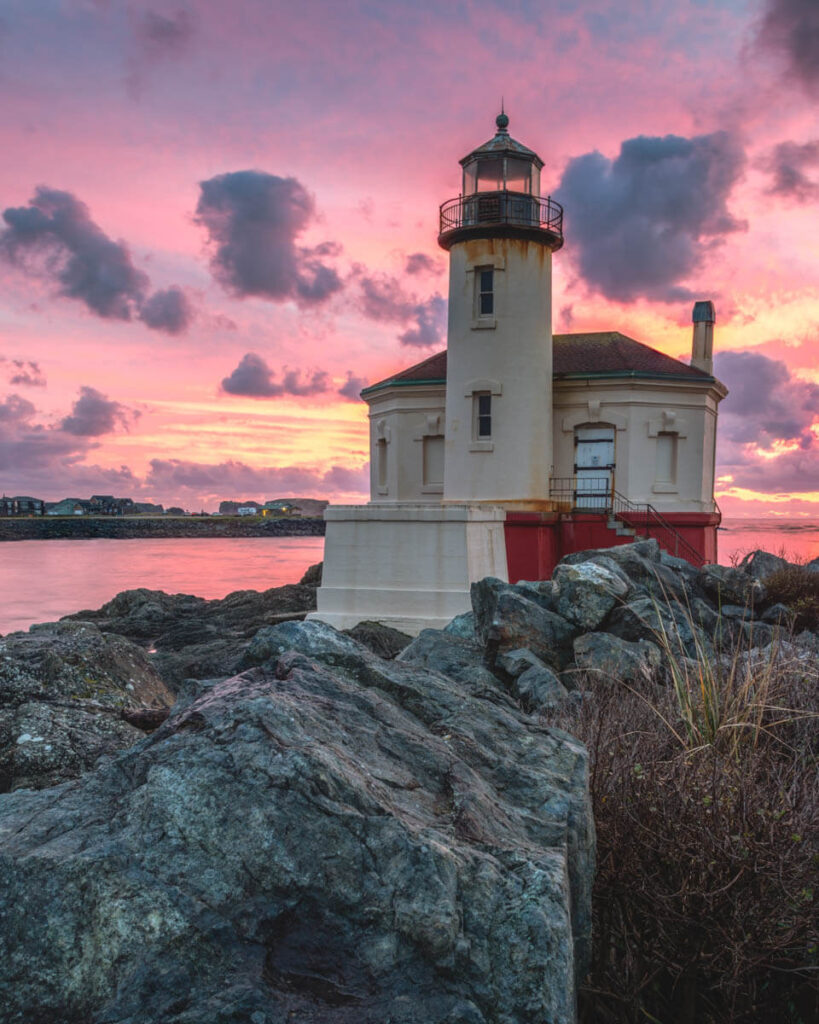
Tours: available from mid-May to mid-October. 11 am to 5 pm.
Adventures Near Coquille River Lighthouse in Oregon
Bullards Beach – Bullards Beach State Park lies at the Coquille River’s mouth, offering plenty of recreational activities. You can talk a walk along the picturesque beach, ride horses along the shore, and enjoy fishing in the river.
There is a mostly paved path along the beach that weaves through the grassy fields, lowland forest, and sandy dunes, showcasing the varied terrain that the park has to offer.
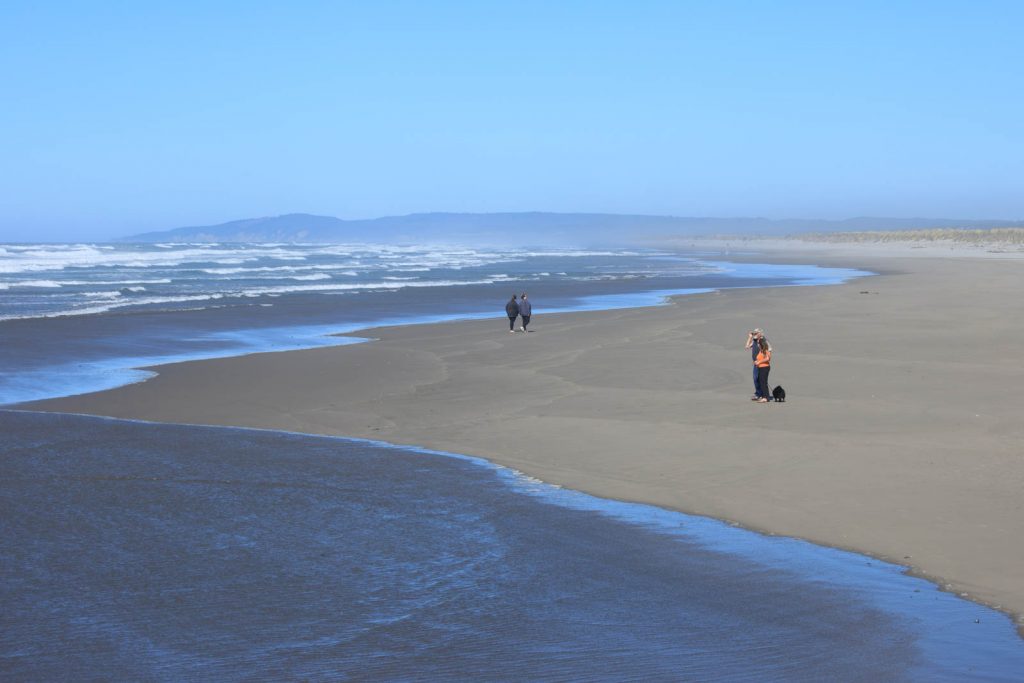
Camping – There is a campsite offering 103 full-hookup sites and 82 electrical sites within the park with plenty of facilities for a comfortable camping experience.
OHV Trails – There are 17 miles of single-track trails and roads suitable for off-road motorcycles and ATV riders so that you can satisfy your adrenaline needs. Trails are marked from 1 to 22, so there is plenty to explore and enjoy.
RELATED: Visiting Bullards Beach State Park Near Bandon, Oregon
Cape Blanco, sitting atop a wind-swept bluff overlooking the Pacific Ocean, is a pretty special Oregon lighthouse for several reasons. For a start, it is the oldest continually operating light in Oregon, it has the highest focal plane above the sea in Oregon at 256 feet, and it had Oregon’s first woman keeper.
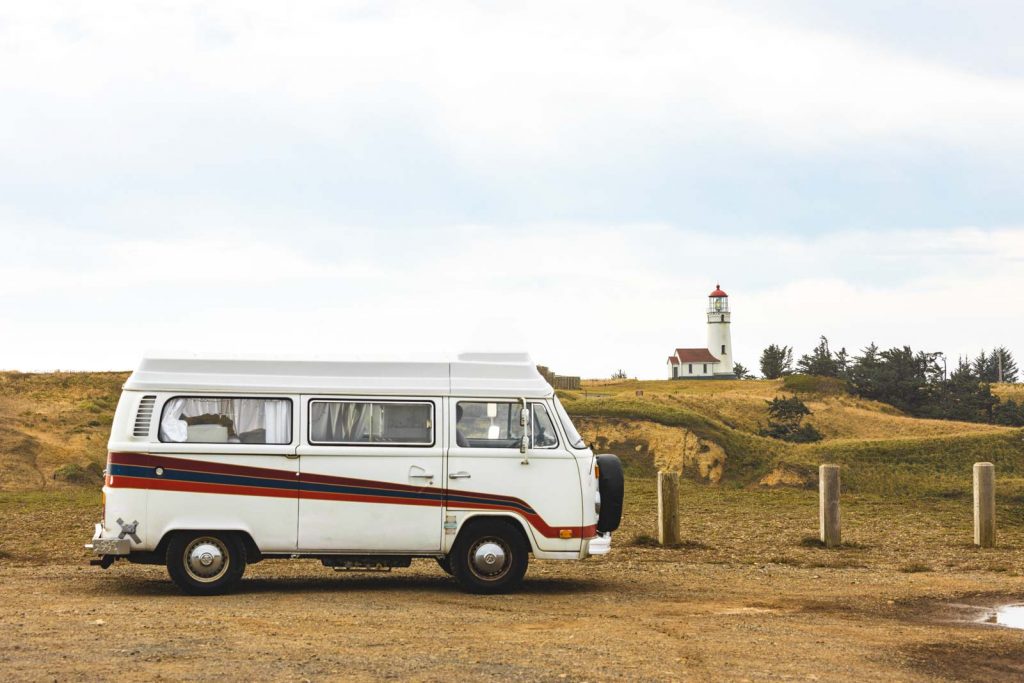
It is also the most westerly lighthouse in Oregon. The light began its operation in 1870, beginning to warn passing ships away from the reefs of Cape Blanco.
Tours: Wednesday to Monday 10 am to 3.30 pm – April to October.
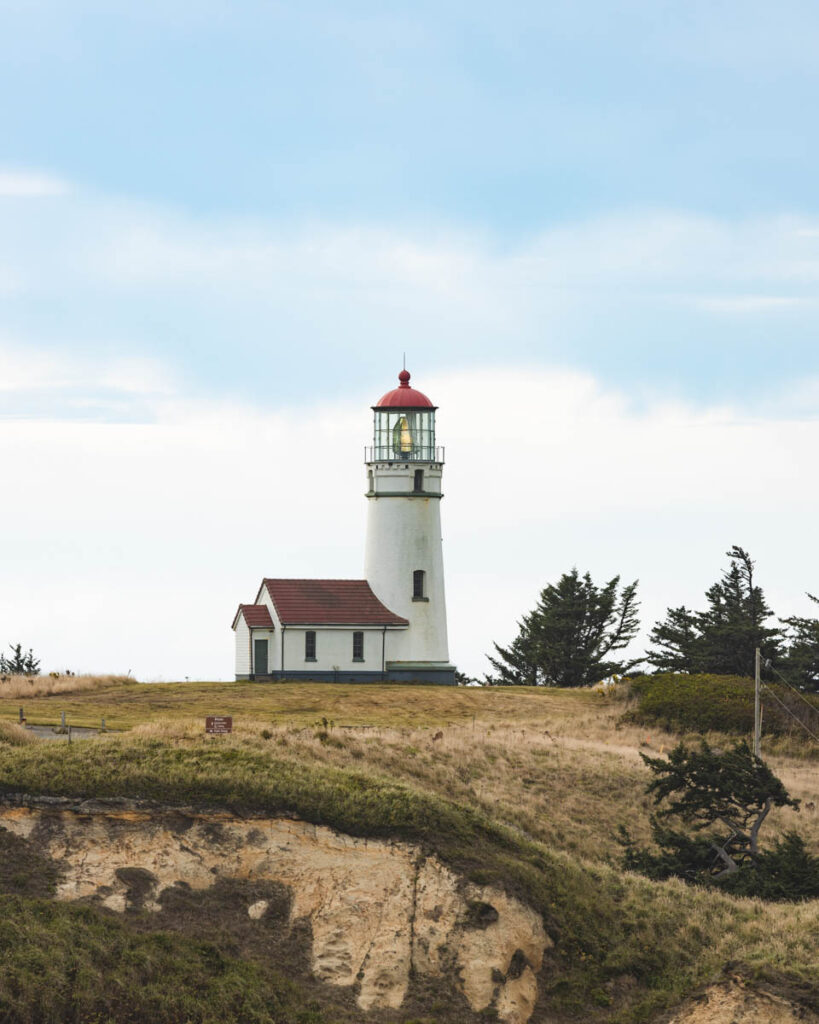
Adventures Near Cape Blanco Lighthouse in Oregon
Whale Watching – The bluff is an incredible place to watch the incredible California gray whales and a range of other marine mammals.
Camping – Cape Blanco State Park is home to a great campground. With 52 electrical sites with water, it is the perfect place to stay to have immediate access to the trails from the minute you wake up. There are flush toilets and hot showers, firewood, and a reservable group camp.
Trails – There are a few short trails that lead you down the beaches below.
Pelican Bay is the newest lighthouse on the Oregon coast, shining its light up to 12 miles out to sea. Standing 141 feet above sea level, it was first lit in 1999.
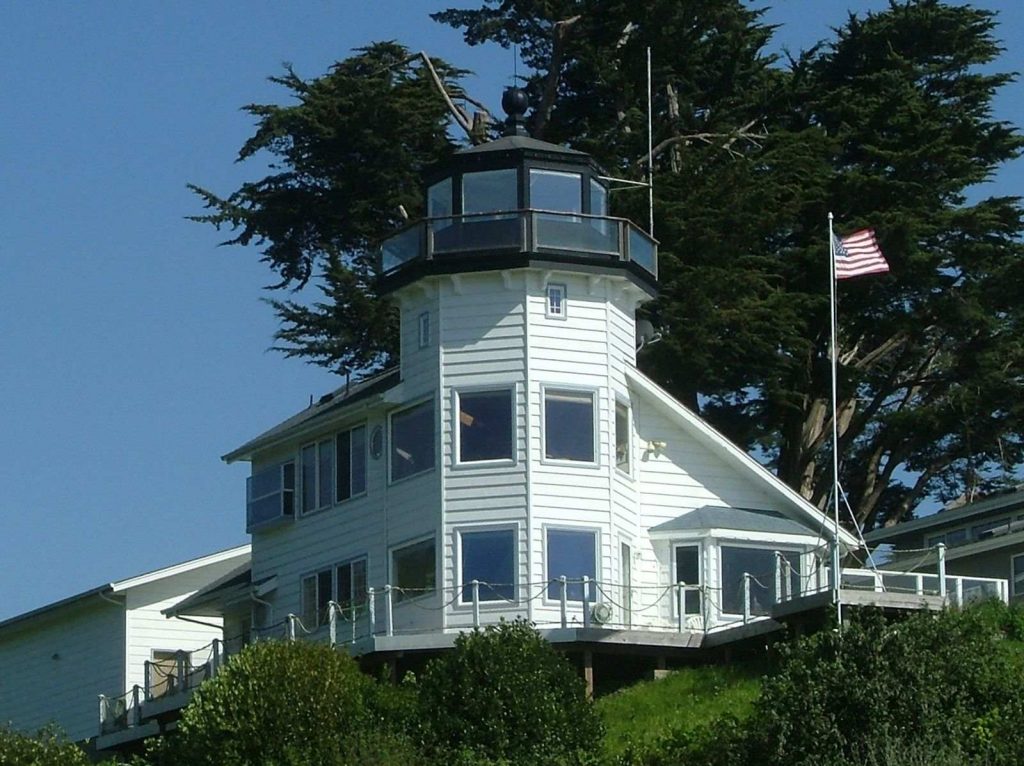
Although it is not open to the public as it is privately owned, it is still pretty impressive to see, with some of the best views from Brookings Harbor .
Adventures Near Pelican Bay Lighthouse
Sporthaven Beach Walk – (1.9 miles, easy, out and back) – Sporthaven Beach offers a great little walk along the coast. If you’re lucky, it is one of the best places in the area to see gray whales migrating through, which can be a magical sight.
This can be a pretty popular beach during the weekend, and it is not hard to see why. There is a large sandy stretch, and the waves make it popular for surfing.
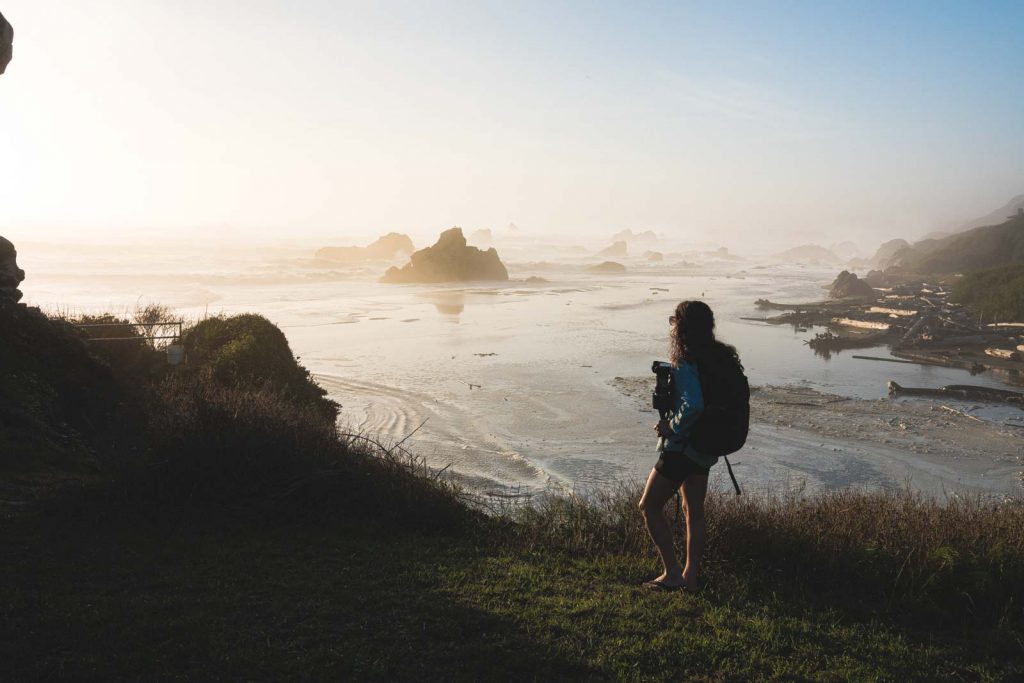
Harris Beach State Park – One of the most stunning state parks in Oregon is very close to this lighthouse. There are trails weaving through huge boulders set along the coast and a perfectly placed campsite for you to post up for the night.
Camping – Beachfront RV Park is one of the best places to camp in the area, with many sites offering beautiful river views, an incredible scene to wake up to in the morning. There are plenty of amenities for a comfortable camping experience.
ACCOMMODATION OPTIONS ON THE OREGON COAST
More Oregon Lighthouses
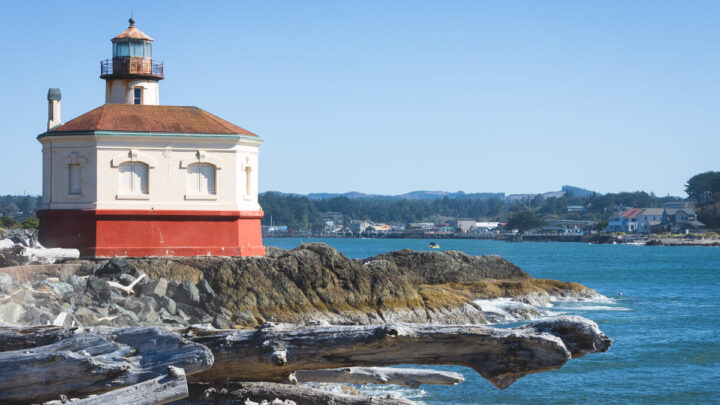
We hope these tips will help you to plan your successful Oregon coast road trip. Here are more posts on Oregon’s coast and epic adventures around Oregon to check out.
Oregon native and explorer at heart. Loves tackling expeditions around the world and drinking a good beer at the end of the day. PNW obsessed, VW nerd, and surf or snow riding fanatic.
Leave a Reply
Your email address will not be published. Required fields are marked *
- Your First Listen
- Listen Live
- Recently Played
- On-Air Highlights
- Carlin & Brent
- The Sunday Show
- Your Toronto
- Pop Culture
- Job Opportunities
- Contest Rules & Regs
- Privacy Policy
- Accessibility

The Tillamook Rock Lighthouse Has A Haunting History
In 1881, just over a mile off the coast of Oregon , the government decided to build a lighthouse to help guide ships around Tillamook Head. Meant as a safety measure, the lighthouse ended up being anything but safe.
Horrific storms, isolation, madness, and major safety issues plagued the lighthouse from its inception.
The large piece of basalt rock that became home of the Tillamook Lighthouse had a reputation. Perhaps the government wasn’t aware of its history with the Indigenous peoples. Or maybe they just didn’t care.

The reputation of Tillamook was fraught. The Indigenous groups believed the tiny island was cursed by their gods. To take it further, they also believed that it was haunted by evil spirits. Because of this, generations of Natives to the land never approached the rock.
- RELATED: The ‘Bjork House’ In Iceland Has Inspired Wild Stories Over The Years
The rumours that the rock was filled with tunnels occupied by spirits flew around local communities, eventually spreading to the construction crews. The first surveyor of the rock, a master mason named John Trewavas, was hit by a huge wave and swept out to sea. His remains were never found.
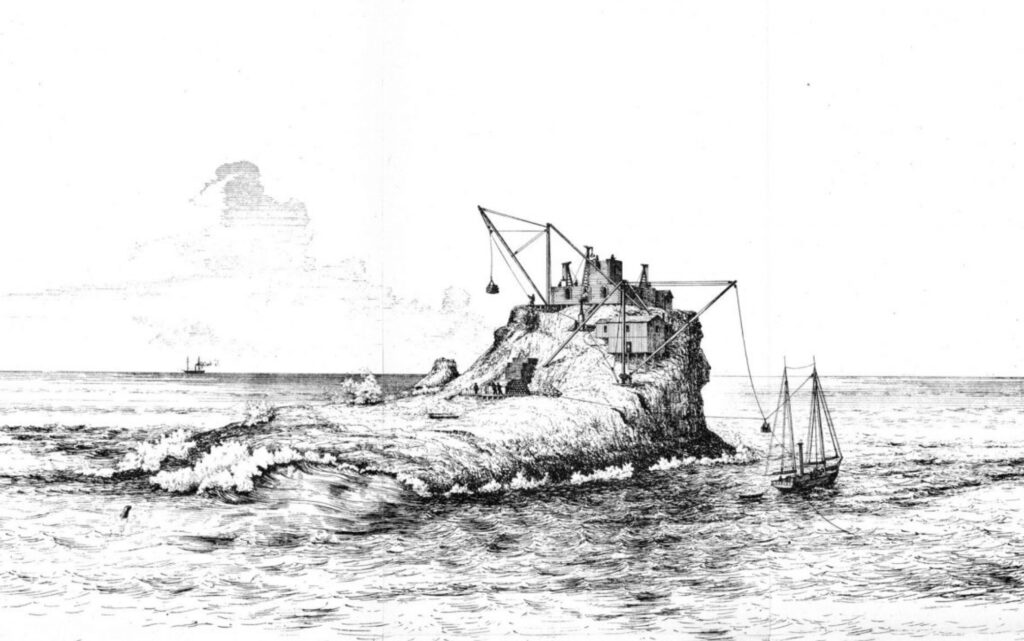
The local men refused to work on the lighthouse. Officials had to remove them from the area so they could then bring in a crew from outside the area who didn’t know what was up. The outsiders, as a result, could perform their work more effectively without being scared for their lives.
Ghosts In The Lighthouse

Getting to the lighthouse was extremely dangerous. Huge winds seemed to work with the rock to keep the crews from doing their work. Stranded and alone, one crew nearly starved to death. The problem was simple: help could not access them to help them or bring them food.
Just when you thought it couldn’t get any more creepy, the attendants to the lighthouse started going mad. Some said it was because they men didn’t have their families. Others say it was because of the haunting of the rock.
- RELATED: The Gibraltar Point Lighthouse In Toronto Is A Must-See Stop

One night, all four lighthouse keepers on shift saw a ghost ship. They’d hear whispering moans, and think that the other attendees were playing tricks… but they were not. Shared stories across the world of isolated lighthouse keepers tell of similar accounts. Sounds of ghosts. Things moving in the night. Strange visions. They had to remove one of the managers in a straight jacket.
You know, standard lighthouse stuff.
- RELATED: The Upside Down House In Orlando Is Just One Of Many Around The World
Can You Visit The Tillamook Lighthouse?
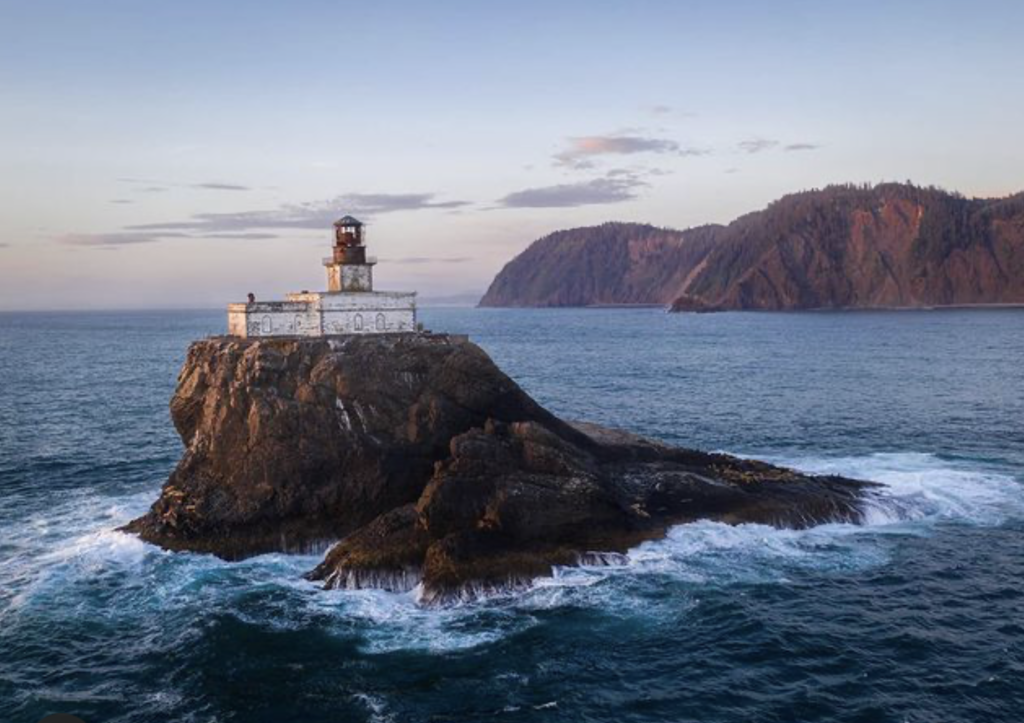
A terrible storm broke the lighthouse lens in 1934. They didn’t replace the lens, and Terrible Tilly started to deteriorate from here. In 1957, they inactivated the lighthouse. Because of this, they abandoned the lighthouse too. Left to break down on its own, you can still view it today.
You cannot, however, visit the Tillamook Lighthouse; it’s on private property and it’s super dangerous. However, you can see it from Seaside, Cannon Beach, or Ecola State Park.
The Tillamook Head Trail

The Tillamook Head Trail is a stunning and supernatural area of hiking on the Oregon Coast Trail. The trailhead is just south of Seaside, and the hike takes you up over a thousands feet above the ocean.
The old-growth Sitka trees are breathtaking; they add so much to the hike’s beauty and therapy. The total distance is 6.3 miles each way. If you decide to do this glorious hike to go and check out Terrible Tilly for yourself, prepare yourself for the challenge!
We don’t need to add injuries and accidents to the already frightening history of this area, do we?

RELATED ARTICLES
The 7 best bars in toronto for a memorable night out, what are fairy stones and how are they formed, the best restaurants in ontario (our top 6 picks), most popular, indie88’s your first listen album special with pearl jam, win tickets to punk in drublic, major announcement coming, indie88’s kings of leon winning weekend.
Indie88 (CIND-FM) is Toronto’s New Alternative. Launched on August 3rd, 2013, as Canada’s first indie music station, Indie88 provides a platform for emerging artists while paying homage to the classics that inspired them. Indie88 is where new music belongs. It’s also a multi-media hub for news, local lifestyle, and pop-culture content focused on unique and engaging stories.
Contact us: [email protected]
© Indie88


IMAGES
COMMENTS
Tillamook Rock Lighthouse, also known as "Terrible Tilly", is a historic lighthouse located off the coast of Oregon, USA. The lighthouse is perched on a rock formation about a mile offshore from Tillamook Head, near Seaside, Oregon. The lighthouse was constructed in the late 19th century to aid mariners navigating the treacherous waters of.
So, while you cant touch it, what you can do is visually see the distance between land and the lighthouse. And on a good day, you can see the lighthouse in her glory. Read more. Written July 16, 2018. ... It took us about an hour to get to the Tillamook Rock Lighthouse viewpoint. Along the way you see markers, some with interesting and relevant ...
At the time of writing, Aalpha Shuttle (503-440-7777) charges $22 for a ride from Ecola Point and $27 from Indian Beach; Royal (503-325-5818) does not have a flat rate from either of those two locations, but you can expect to pay between $30-$40. Click here for more great hikes in and around Seaside. Photo by Greg Vaughn. Your quest to see ...
Just like Heceta Head, you're allowed to go inside the lighthouse but not climb up the stairs to the top from 11 a.m. to 5 p.m. mid-May to the end of September. A museum and interpretive center is ...
Lighthouse Views. Perhaps the trail's most compelling sight is the Tillamook Rock Lighthouse, listed on the U.S. National Register of Historic Places and known commonly as "Terrible Tilly.". Sitting just over a mile offshore, the lighthouse (which took nearly two years to build) operated from 1881 to 1957; its keepers endured miserable ...
October 2, 2015 (Updated August 5, 2021) Resting atop a sea stack of basalt, more than a mile off the banks of Oregon's North Coast, the notorious Tillamook Rock Lighthouse, (nicknamed "Terrible Tilly"), is the stuff of aged lore. Although long closed to the public, she still stands today, though battered and bruised, a testament to her ...
Tillamook Rock Light (known locally as Terrible Tilly or just Tilly) is a deactivated lighthouse on the northern Oregon Coast of the United States.It is located approximately 1.2 miles (1.9 km) offshore from Tillamook Head, and 20 miles (32 km) south of the mouth of the Columbia River near Astoria, situated on less than an acre of basalt rock in the Pacific Ocean.
During low tide, you can walk up to the base of Haystack Rock and look north to see the lighthouse in the distance. Ecola State Park provides some of the best views of Tillamook Rock Lighthouse. From the park's scenic overlooks, you can take in the breathtaking panorama of the coastline and the lighthouse perched on its small rock.
Joel Munson at Point Adams Lighthouse near the Columbia River spotted the initial lighting of Tillamook Rock at 7:15 p.m. and wrote, "Three cheers for the new light, long may it shine.". The total cost of the lighthouse came to $123,492.82, and amazingly, the only construction death was the drowning of Trewavas.
Located on the rock about a mile offshore from the Tillamook Head, this lighthouse probably has the richest history of all the Oregon lighthouses. This 62-foot light station towering 133 feet above sea level can be visible from Ecola State Park and Tillamook Head. Tillamook Head Viewpoints offer the best view of the lighthouse.
Off Hwy. 101, 2 miles north of Cannon Beach. Cannon Beach, Oregon 97110. West of Tillamook Head, this lighthouse was constructed on top of a rock in 1880. The construction of this particular lighthouse was thought to be incredibly risky, but its five workers beat the odds. Because this lighthouse was built on a rock, it is not accessible to the ...
Tillamook Rock Lighthouse, Cannon Beach: See 208 reviews, articles, and 55 photos of Tillamook Rock Lighthouse, ranked No.7 on Tripadvisor among 25 attractions in Cannon Beach. ... and you can take the trail at the top of the loop to the bluff to see the lighthouse. You can't visit it, and it's small, but is a fun thing to spot from the shore ...
West of Tillamook Head, this lighthouse was constructed on top of a rock in 1880. The construction of this particular lighthouse was thought to be incredibly risky, but its five workers beat the odds. Because this lighthouse was built on a rock, it is not accessible to the public. However, visitors can easily see it and a beautiful view of the ...
Tillamook Rock light began operations on January 21, 1881. The tall white tower stood 133 feet above sea level. The lighthouse ultimately cost nearly $125,000. After its initial appropriation of $50,000, Congress was forced to provide another $50,000 in 1880, and $25,000 in 1881, to cover the costs. Tillamook Rock's construction cost nearly ...
The Tillamook Rock Lighthouse was placed for sale by the General Services Administration in 1959 and sold to a group called the Academic Economic Coordinators of Las Vegas for $5,500. ... It will take you a short distance to a parking area. From here, if you walk up to the ocean, you can see the Tillamook Rock Lighthouse. I used a 1000mm ...
Tillamook Rock Lighthouse is Oregon's only offshore light and the fourth oldest of nine lighthouses now standing on the state's coastline. Its construction, completed in 1881, was an engineering feat involving hazardous landings of men and materials by derrick and breeches buoy from a lighthouse tender anchored off the rock. Its roof was ...
After you visit Tillamook Rock Lighthouse, return to a gorgeous home from Starfish Vacation Rentals! We have a wonderful selection of properties in Cannon Beach, near Ecola State Park.Consider booking Pacific House, a three-bedroom, two-bathroom property that's perfect for families who don't want to sacrifice comfort or privacy during their vacation.
From Ecola State Park, you can see the Tillamook Rock Lighthouse, one of eleven in Oregon. It was built in 1880 and deactivated in 1957, and still stands tall in the Pacific today 1.2 miles offshore. I am excited to go back on a clear day with my new zoom lens to capture more of a close up. Explore more at www.traveloregon.com….
Year lit: 1881 Height: 62 feet Many people find the Tillamook Rock Lighthouse fascinating. It sits about a mile offshore from Tillamook Head, 133 feet above sea level, on a rock battered by the ...
1. Tillamook Rock Lighthouse. Located more than a mile off the North Coast of Oregon is 'Terrible Tilly', or Tillamook Rock Lighthouse. It stands on a sea stack of basalt and is well-known throughout Oregon. It is closed to the public, and while you can't visit it, it's still a formidable sight off of the coast of Tillamook Head.
Know Before You Go. The lighthouse can be seen from shore at Ecola State Park and from Highway 101 near Cannon Beach, Oregon. Sea conditions usually prevent accessing the rock via boat.
The Tillamook Rock Lighthouse Has A Haunting History. In 1881, just over a mile off the coast of Oregon, the government decided to build a lighthouse to help guide ships around Tillamook Head. Meant as a safety measure, the lighthouse ended up being anything but safe. ... Can You Visit The Tillamook Lighthouse? Image: @itsjoshytime on Instagram.